Lakers Season Capsules

1947-48
The Game's First Star
The Lakers franchise predates the NBA. The Minneapolis Lakers' first season was 1947-48, when the team entered the National Basketball League. A strange series of events early that year landed the Lakers the biggest prize in the game at that time-center George Mikan.
Mikan was a 6-10 giant of a man who had dominated college basketball in his four years at DePaul. He joined the Chicago American Gears at the end of the 1945-46 season, then led the Gears to the NBL Championship the following year.
Prior to the 1947-48 campaign Maurice White, president of the American Gear Company and owner of the Chicago team, pulled the club out of the NBL. White's plan was to create a 24-team circuit called the Professional Basketball League of America, in which he would own all of the teams and all of the arenas. But the new league lasted barely a month, and the players on White's teams were distributed among the 11 NBL franchises. The first-year Minneapolis Lakers landed Mikan strictly by chance.
The Lakers were a good team even without Mikan. The club featured a fine forward named Jim Pollard and one of the better playmakers in the league in Herm Schaefer. Coaching the squad was John Kundla, who had been hired away from the University of Minnesota. But once the bespectacled Mikan joined the Lakers there was no stopping them.
Minneapolis walked away with the NBL crown that season. After winning the Western Division by 13 games, the team disposed of the Oshkosh All-Stars, the Tri-Cities Blackhawks, and the Rochester Royals. Minneapolis lost only two games during the postseason, one in the first round and one in the finals against the Royals. Mikan paced the circuit in scoring during the regular season with 21.3 points per game and was tops in postseason play with an average of 24.4 points per contest.
Return to top of page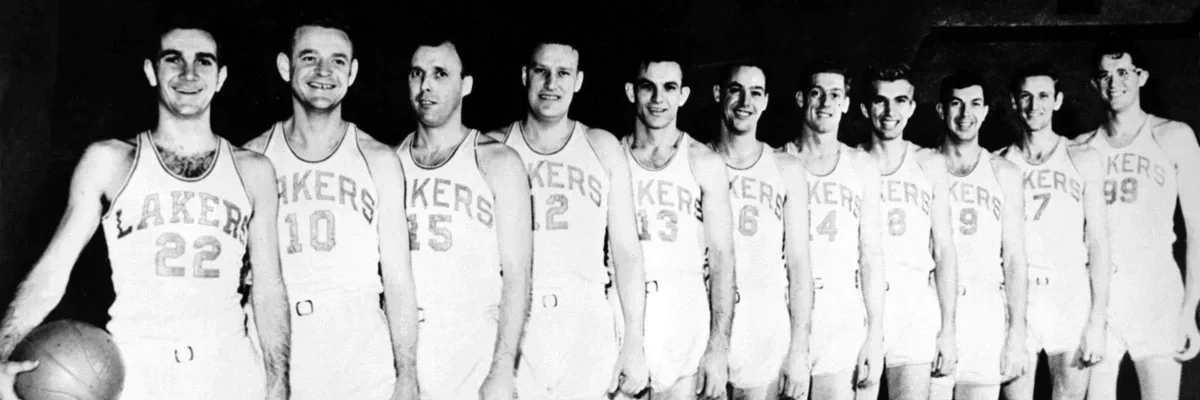
1948-49
Minneapolis Jumps to BAA
Before the 1948-49 season began the Minneapolis Lakers, Rochester Royals, Fort Wayne Zollner Pistons and Indianapolis Kautskys (later renamed the Jets) jumped to the Basketball Association of America. The BAA was already an eight-team league that included franchises in such major markets as New York, Boston, Philadelphia and Chicago. The addition of the four NBL teams now gave the league the big-name players it needed.
The biggest name of all was Mikan, and fans flocked to see him in every BAA city. When the Lakers arrived in New York to face the Knickerbockers, the marquee at Madison Square Garden read "George Mikan vs. Knicks."
Rochester and Minneapolis dueled for the top spot in the BAA's Western Division, but the Royals edged out the Lakers by one game, even though the tall, broad-shouldered, and extremely agile Mikan played with unstoppable force. His 28.3 points per game led the league and accounted for one-third of the Lakers' point production.
Minneapolis swept the Chicago Stags in the first round of the 1949 playoffs before attention shifted to a division finals matchup that pitted the Lakers against the Royals. Minneapolis squeezed out a one-point win in Game 1, then stormed back from a 12-point third-quarter deficit to take Game 2 and sweep the best-of-three series.
The BAA Finals came next, and the Lakers faced the Washington Capitols, who were coached by Arnold "Red" Auerbach. Minneapolis notched three quick wins to open the best-of-seven series. In Game 4 Mikan sustained a broken wrist, and the Capitols came away with a win. Mikan played Game 5 with a cast on his hand and still pumped in 22 points, but Washington prevailed. Game 6 was played on the Lakers' home court, and Minneapolis came away with a 77-56 win and a BAA Championship.
Return to top of page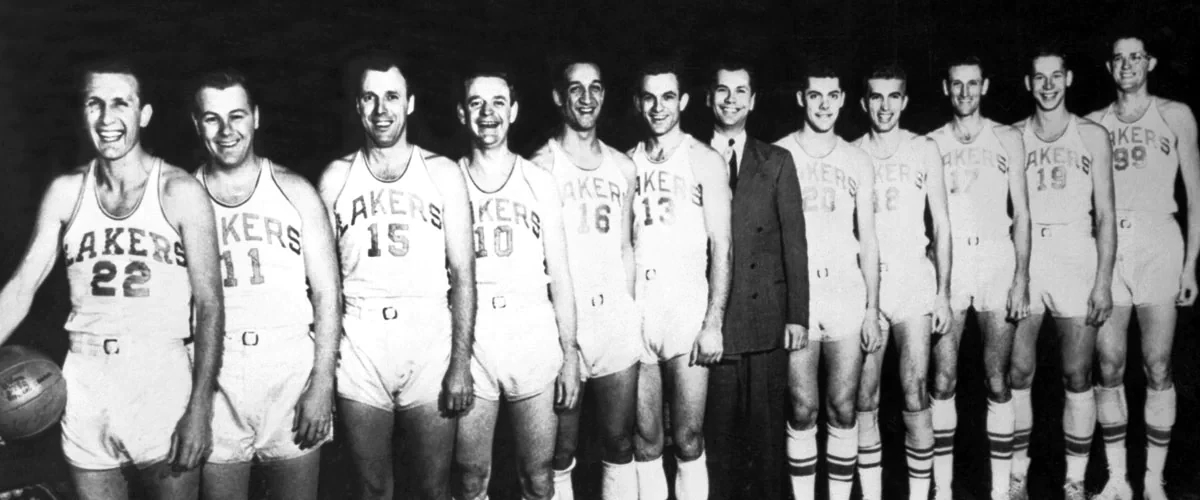
1949-51
Lakers Win First NBA Finals
The BAA and the NBL merged after that season, and the NBA was born for the 1949-50 campaign. In its first year the NBA consisted of 17 teams competing in three divisions. Minneapolis was assigned to the Central Division (the new circuit's strongest division), where the team once again went head-to-head with Rochester.
If anything, the Lakers were even better than they had been the season before. The team included a trio of promising first-year players in forward Vern Mikkelsen and guards Slater Martin and Bud Grant. (Grant went on to greater fame as coach of the football Minnesota Vikings.)
Minneapolis seemed to have a lock on the top spot in the Central Division, but Rochester put together a 15-game winning streak as the campaign wound down, and the teams ended the regular season tied for first with identical 51-17 records. The Lakers then edged the Royals by a single basket in a one-game playoff to claim the division title.
For the second season in a row Minneapolis waltzed through the preliminary rounds of the postseason. The powerful Lakers felled the Chicago Stags in the Central Division Semifinals, swept the Fort Wayne Pistons in two games in the division finals, and then dusted the Anderson Duffey Packers in two games in the NBA Semifinals.
The first NBA Finals pitted the Lakers against the Syracuse Nationals. The Nats had the home-court advantage, but the Lakers took Game 1 in Syracuse when reserve guard Bob Harrison heaved in a 40-foot shot at the buzzer to give Minneapolis a two-point victory. The Nationals evened the series the next night. When the Finals reconvened in Minnesota five days later, Minneapolis pounded out a 91-77 win, then followed that with a victory in Game 4. Syracuse postponed the inevitable by shutting down Mikan in Game 5, but the Lakers came back with a 110-95 victory in Game 6 to earn the first NBA Championship. Mikan, who had led the league in scoring during the regular season with 27.4 points per game (only one other player topped 20.0 ppg), poured in 31.3 points per contest in the playoffs.
A slimmed-down NBA fielded 11 teams in the 1950-51 campaign and went back to a two-division format, with the Lakers returning to the Western Division. With the best players from the six disbanded clubs distributed throughout the remaining teams, the offseason attrition helped to raise the level of competition in the two-year-old league.
The Lakers were favored to repeat as NBA champs that season. In addition to Mikan, the team boasted a solid frontcourt in Jim Pollard and Vern Mikkelsen and a better-than-average backcourt in Bob Harrison and Slater Martin. Minneapolis took the Western Division by three games and posted the league's best record at 44-24. But the playoffs didn't go according to plan. Minneapolis lost a game to the Indianapolis Olympians in the division semifinals, marking the Lakers' first-ever loss in a preliminary playoff round. They nevertheless won the series, two games to one, and advanced to face old rival Rochester in the Western Division Finals. The Lakers won Game 1, but the Royals came back with three straight victories to take the best-of-five series.
Return to top of page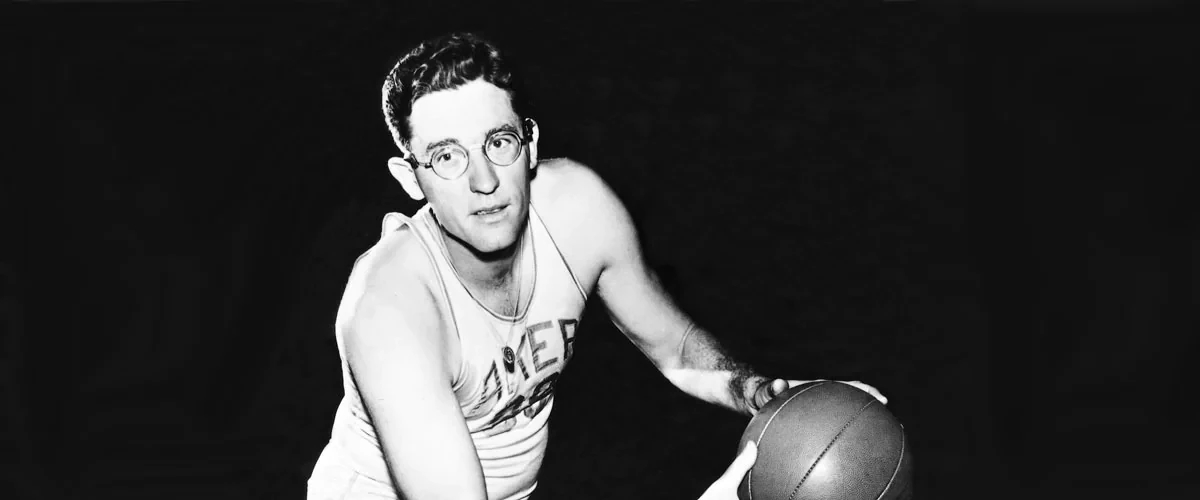
1951-52
NBA Tries To Slow Down "Big George"
The NBA widened the foul lane before the 1951-52 season in an attempt to slow Mikan, but the rule change had a minimal effect on "Big George." He still averaged 23.8 points, but he lost the scoring title to Paul Arizin, a sharp-shooting forward with the Philadelphia Warriors.
The Lakers went into the campaign with essentially the same lineup. Rochester took the Western Division crown by a game, but the Lakers ousted the Royals in four games in the division finals to set up an NBA Finals matchup between the Lakers and the New York Knickerbockers.
Minneapolis took Game 1 at St. Paul but needed overtime to do so. The Knicks prevailed in Game 2. Back in New York, Games 3 and 4 were played at the 69th Regiment Armory instead of at Madison Square Garden because the circus was in town. The teams split those games, and Games 5 and 6 as well. Game 7 was all Minneapolis. The Lakers pounded out an 82-65 win at home to claim their second NBA crown in three years.
Return to top of page
1952-53
Basketball's First Dynasty
The 1952-53 Lakers outmuscled the Royals during the regular season to finish atop the Western Division by a four-game margin. Mikan's scoring output dipped a notch to 20.6 points per game, second best in the league. He was joined in the NBA's top 10 by teammate Vern Mikkelsen, who finished eighth with 15.0 points per game. Mikan led the league in rebounding, pulling down 14.4 boards per contest.
In the playoffs the Lakers and the Knickerbockers marched toward an NBA Finals rematch. Minneapolis whipped past Indianapolis and Fort Wayne in the preliminary rounds. Meanwhile, in the Eastern Division, New York downed the Baltimore Bullets and then the Boston Celtics.
The NBA Finals opened in Minneapolis, and the Knicks stunned the Lakers with an eight-point win in Game 1. Minneapolis barely beat the Knicks in Game 2, winning by a slim two-point margin. The next three games were scheduled for New York, and with the series tied at one game apiece, the Knickerbockers had hopes of unseating the defending champions. But the Lakers would have none of that. They took all three contests at Madison Square Garden to win the series and become the NBA's first repeat champs. With four championships in five years (including the BAA crown in 1949), the Lakers staked a claim as professional basketball's first dynasty.
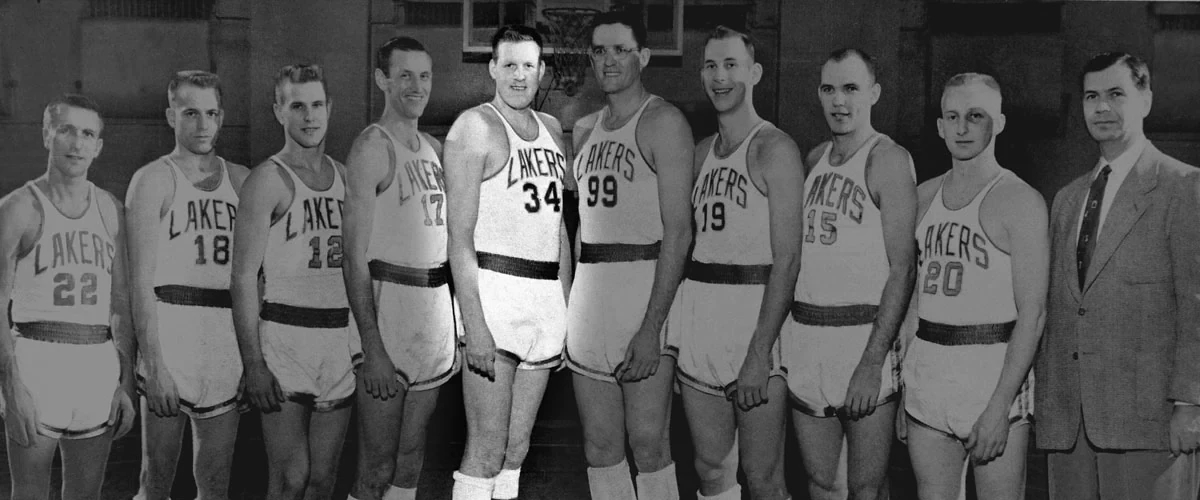
1953-54
Lovellette Comes To The Rescue Of Ailing Mikan
The following season saw Mikan's production dip again. Bad knees were beginning to take a toll on the 29-year-old center, and he scored only 18.1 points per game. But the Lakers signed a promising rookie named Clyde Lovellette, who was more than capable of spelling Mikan at the center position.
Minneapolis won the Western Division in 1953-54, posting the NBA's best record at 46-26. The playoffs got off to an odd start when the league experimented with a round-robin format in the first round. Minneapolis survived, then downed Rochester in the Western Division Finals. The expected NBA Finals rematch between the Lakers and the Knickerbockers failed to materialize because New York was eliminated in the Eastern Conference round-robin. Instead, the Lakers faced Syracuse.
The Nationals surprised Minneapolis with a two-point win on the Lakers' home court in Game 2, tying the series at one game apiece. The Lakers then took two out of three games in Syracuse, and the teams returned to Minneapolis with the Lakers leading, three games to two. Syracuse survived Game 6 with another two-point victory, but the Lakers made it three titles in a row with an 87-80 triumph in the deciding game.
Return to top of page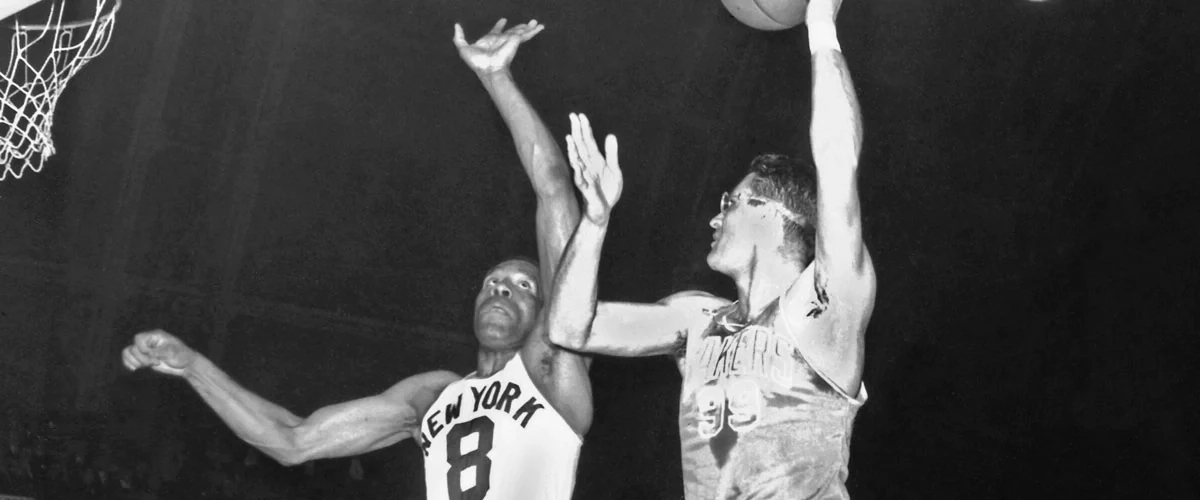
1954-58
New Rules Are Bad News For Lakers
The NBA instituted two revolutionary rule changes shortly after the end of the 1953-54 season. The 24-second shot clock was introduced, as was a limit of six team fouls per quarter (after which every foul would result in penalty free throws). The new rules accomplished two things: they helped quicken the pace of the action on the court, and they took away the tactical advantage of fouling a player who has possession of the ball late in a game.
The big question was what effect the new rules would have on the three-time defending NBA-champion Lakers, a team built around the size and power of George Mikan. But the question was never really answered, because Mikan retired before the 1954-55 season began and assumed the job of team general manager.
With Mikan gone, the center position fell to second-year player Clyde Lovellette, who contributed 18.7 points and 11.5 rebounds per game. But Lovellette was not the defensive force that Mikan had been, and the Lakers finished 40-32, second to the Fort Wayne Pistons in the Western Division. Minneapolis survived the first round of the playoffs but fell to the Pistons in four games in the division finals. The beginning of the shot-clock era meant the end of the Lakers' dynasty.
Age was also beginning to take its toll on Minneapolis. Jim Pollard retired before the 1955-56 season, ending an eight-year career with the Lakers that stretched back to the NBL days. Guard Slater Martin had a fine season, but he was 30 years old. The Lakers' youngest starter was the 26-year-old Lovellette, who had become the team's star, finishing fourth in the league in scoring (21.5 ppg) and third in rebounding (14.0 rpg).
By midseason the Lakers were struggling so badly that they prevailed upon Mikan to come out of retirement. It took him some time to get back into shape, but by the end of the season he had become a solid contributor, if not the star he had been a few years earlier. All told, Mikan appeared in 37 regular-season contests, averaging 10.5 points and 8.3 rebounds.
Slater Martin finished among the NBA's top 10 in assists (6.2 apg) and free-throw percentage (.833), while seven-year veteran Vern Mikkelsen led the league in personal fouls for the second year in a row.
The Lakers fell under .500 for the first time in franchise history that season, finishing with a 33-39 record. Facing the St. Louis Hawks in the playoffs, Minneapolis dropped Game 1, 116-115, then walloped the Hawks by 58 points in Game 2. But St. Louis came back with a repeat of the opening game and won Game 3, 116-115, to take the series.
In 1956-57 Minneapolis managed to earn a tie for first place in the Western Division, but that said more about the division's weakness than about the Lakers' strength. Minneapolis, St. Louis, and Fort Wayne shared first place with identical losing records of 34-38. By contrast, the last-place team in the Eastern Division was 36-36.
After a series of one-game playoffs, St. Louis earned the Western Division title and a bye in the first round of the 1957 NBA Playoffs. While the Hawks waited, the Lakers and the Pistons squared off in the division semifinals. Minneapolis prevailed with a two-game sweep. St. Louis then took out the Lakers in three straight, but the series was close for a sweep. The Hawks won Game 1 by a comfortable nine-point margin. Game 2 was a squeaker at 106-104. The final contest was a no-holds-barred marathon. The game lasted through a pair of overtime periods, and when it ended, St. Louis was the team still standing. The final score was Hawks 143, Lakers 135.
The franchise endured a disastrous season in 1957-58. George Mikan was persuaded to assume the head coaching duties, but he failed miserably and stepped aside after the club fell to 9-30. John Kundla moved back into the coaching spot after half a season in the front office, but there wasn't much he could do with the Lakers that year. The team finished with a 19-53 record and in last place in the Western Division.
Return to top of page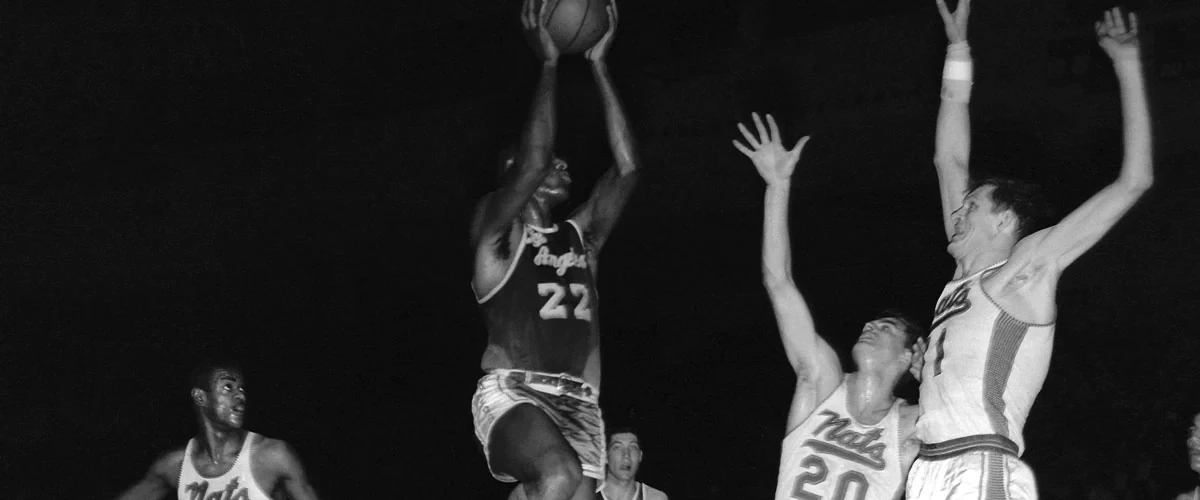
1958-60
Baylor Ushers In A New Era
The dreadful record had a silver lining, however, for it earned Minneapolis the No. 1 pick in the 1958 NBA Draft. The Lakers came away with Seattle University star Elgin Baylor. With the unbeatable combination of a great scoring touch, smooth ballhandling and passing skills, a willingness to pound the boards, and the seeming ability to defy gravity on the way to the hoop, the 6-5 forward helped usher in a new era for the struggling Lakers franchise.
In his rookie campaign Baylor finished fourth in the league in scoring (24.9 ppg) and third in rebounding (15.0 rpg). He also led the club in assists with 4.1 per game. Powered by the league's newest superstar (and that season's Rookie of the Year), Minneapolis won 14 more games than the year before and finished with a 33-39 record, good for second place in the Western Division behind the St. Louis Hawks.
The Lakers dispatched the Detroit Pistons in the division semifinals, then moved on to face St. Louis in the Western Division Finals. By all accounts the series was little more than a warm-up for defending NBA-champion St. Louis. The Hawks had breezed through the regular season with a 49-23 record and were looking forward to a rematch with the Boston Celtics in the NBA Finals.
However, behind Baylor and Vern Mikkelsen, who was the last link to the glory years of the Mikan-era Lakers, Minneapolis stunned the Hawks. St. Louis owned a two-games-to-one series lead heading into Game 4, but the Lakers took that game by 10 points and then earned a one-point overtime victory in Game 5. They completed the upset with a 106-104 triumph in Game 6.
The Lakers ran out of gas in the 1959 NBA Finals, however. They faced the Celtics, who owned an 18-game winning streak against Minneapolis and had demolished the Lakers, 173-139, in the teams' last meeting. When the dust settled, the Celtics' winning streak was still intact-Boston swept the series in four straight.
Still, the Lakers' season had to be counted as a great success. After finishing with the league's worst record the year before, they had bounced all the way back to the NBA Finals.
After the Lakers' great playoff run in 1959, the 1959-60 regular season was a bust. Head Coach John Kundla was replaced by John Castellani, who had been Baylor's college coach. The team managed a dismal 11-25 record under Castellani's command, and he was replaced by Jim Pollard, who had played alongside George Mikan in the early years of the NBA. Pollard fared no better, and the Lakers finished with a 25-50 mark. Only Baylor managed to shine-he pumped in 29.6 points and snared 16.4 rebounds per game.
Despite the difficult regular season, the Lakers made the playoffs because they had the third-best record in a four-team division. (The Cincinnati Royals were worse at 19-56.) After making short work of second-place Detroit in the division semifinals, they headed to St. Louis for a rematch of the previous year's Western Division Finals. Minneapolis got ahead, three games to two, but the Hawks avoided embarrassment for a second straight year by posting a 21-point win in Game 6 and then ousting the Lakers with a 97-86 victory in Game 7.
Return to top of page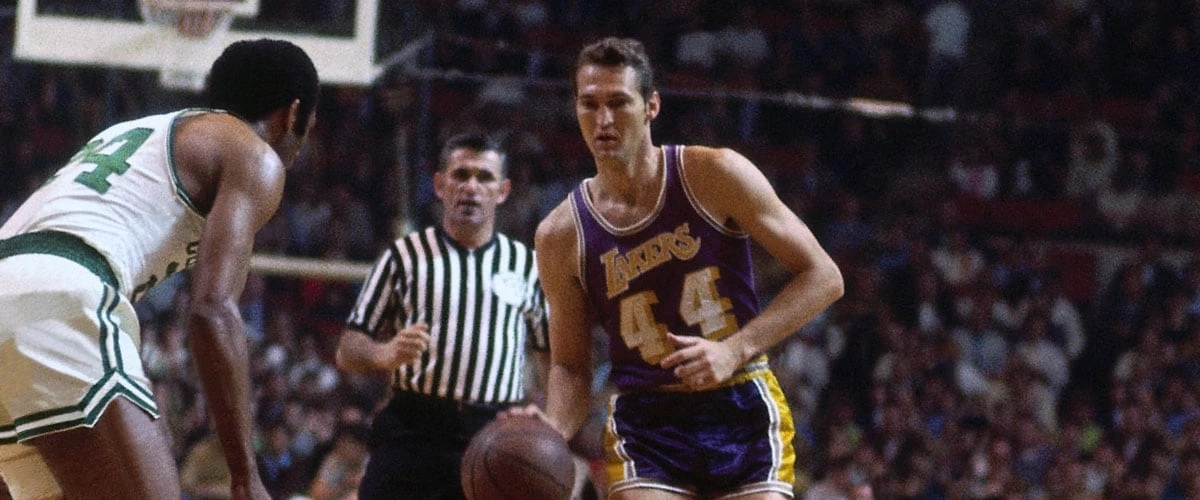
1960-62
A Double Dose Of West
During the offseason the Lakers became the NBA's first West Coast team. Although Minneapolis fans had come out in droves to watch the Lakers when Mikan was with the club, attendance had fallen off dramatically in the ensuing five seasons. Even the presence of Elgin Baylor hadn't made much of a difference. Meanwhile, Major League Baseball's Dodgers had moved from Brooklyn to Los Angeles in 1958 and had become a huge financial success. Lakers owner Bob Short, a shrewd young businessman from Minneapolis who had owned the franchise for two years, packed up the club and moved it to Los Angeles before the 1960-61 season.
That wasn't the only important change for the franchise during the offseason. The Lakers' 25-50 record the previous year had given the club the No. 2 pick in the NBA Draft. The prize was 6-21/2 guard Jerry West, a talented playmaker and scorer. West's former coach at West Virginia, Fred Schaus, was installed at the Lakers' helm.
Baylor was a scoring machine and a terror on the boards for the new Los Angeles Lakers. He averaged 34.8 points and 19.8 rebounds in 1960-61. West struggled for the first half of the season before hitting his stride, finishing his first NBA campaign averaging 17.6 points. The two players combined to boost the Lakers to a 36-43 record and a second-place finish in the Western Division.
The Lakers faced the Pistons in the opening round of the playoffs. In an era of rampant scoring, the two teams lit up the scoreboard. Los Angeles posted 120 points in each of the first two games and won both. Back in Detroit, the Pistons won Game 3, 124-113, and Game 4, 123-114. The Lakers closed out the series with a 137-120 shoot-out in the final game.
That meant a Lakers-Hawks matchup in the Western Division Finals for the third year in a row. St. Louis had finished the regular season 15 games ahead of Los Angeles and was heavily favored, but the series was a dogfight. The Hawks managed a one-point victory in Game 4 to even the series at two games apiece. After the Lakers took Game 5, St. Louis eked out a 114-113 overtime win in Game 6 and a 105-103 victory in Game 7 to move on to the Finals.
Los Angeles played with a slight handicap during the 1961-62 season. Elgin Baylor was one of only two NBA players called to active military duty in the wake of the Berlin crisis. (Lenny Wilkens was the other.) For much of the campaign Baylor was only available on weekends. Still, in 48 games he averaged 38.3 points. Meanwhile, West exploded for a 30.8 average in his second year.
The high-scoring duo was ably supported. The cast included 6-8 Rudy LaRusso, a third-year forward who chipped in 17.2 points and 10.4 rebounds per game. Frank Selvy, a much-traveled veteran who had played with six teams in his first five seasons in the NBA before settling in with the Lakers, added 14.7 points per game at guard. A solid bench featured Rodney "Hot Rod" Hundley and Tom Hawkins.
Los Angeles dominated the Western Division, topping second-place Cincinnati by 11 games. Up against Detroit in the division finals, the Lakers trounced the Pistons in the first three games of the series, lost Games 4 and 5, and then ousted Detroit in Game 6.
The NBA Finals pitted the Lakers against the Boston Celtics, and the series opened in Boston, where the teams split two games. The Lakers won Game 3 in Los Angeles, thanks to a last-second steal and a layup by Jerry West. The Celtics evened the series with a win in Game 4. Game 5, which was played in Boston, saw Baylor pour in 61 points to set a playoff record that stood for a quarter of a century. The teams headed to Los Angeles with the Lakers up three games to two and poised to clinch the championship on their home court. But the Celtics pushed the series to the limit with a 119-105 win.
Game 7 ranks as one of the most exciting championship games of all time. The score was knotted at 100 apiece when Selvy put up a shot that slid off the rim as time expired. Had the shot fallen, the Lakers would have claimed the crown. Instead, the game moved into overtime, and the Celtics outscored the Lakers, 10-7, to win the game and the NBA Championship.
Return to top of page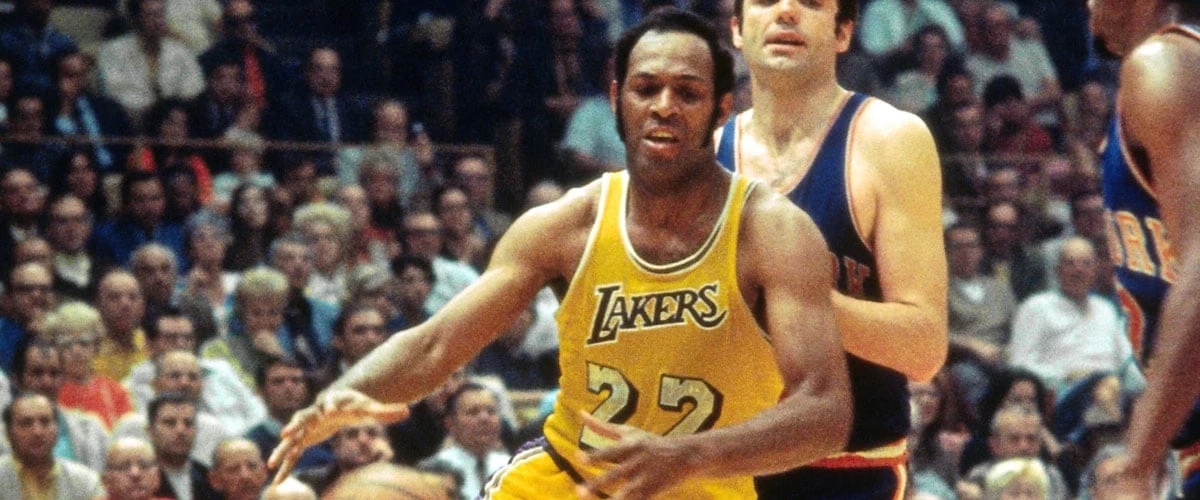
1962-65
The Start Of A Trend: Celtics Clip Lakers For NBA Title
The Lakers added Dick Barnett to their roster during the offseason. Barnett, who had spent the previous two seasons with Syracuse, moved into the starting lineup at guard, and Selvy became the team's sixth man. Barnett averaged 18.0 points during 1962-63, and his contribution became critical when Jerry West missed 27 games with a leg injury. West still finished with 27.1 points per game, while Elgin Baylor poured in 34.0 points per contest to finish second in the league in scoring behind the San Francisco Warriors' Wilt Chamberlain.
Los Angeles finished 53-27, repeating as Western Division champs. The Lakers then earned a rematch against the Celtics for the NBA crown by besting St. Louis in the Western Division Finals. But the Celtics, in the midst of a string of 11 championships in 13 seasons, continued to hold the upper hand, winning the series in six games.
The Lakers' two-year reign atop the Western Division came to an end during the 1963-64 season. West (28.7 ppg) and Baylor (25.4 ppg) finished fifth and sixth in the league in scoring, respectively. But the team was weak in the middle. Starting center Gene Wiley averaged only 4.3 points, and Los Angeles placed third in the division with a 42-38 record. The Lakers failed to get by the St. Louis Hawks in the first round of the playoffs.
Los Angeles rebounded from a relatively disappointing year by posting a 14-6 record to open the 1964-65 season. The Lakers then coasted to a 49-31 overall mark and their third division title in four years. As usual, West (31.0 ppg, second in the NBA) and Baylor (27.1 ppg, fifth) provided the firepower. The Lakers had a surprisingly tough time with Baltimore in the Western Division Finals, needing six games to win the series and advance.
The NBA Finals, which pitted the Lakers against the Celtics, was a lopsided affair. Baylor went down with a knee injury and was unable to play in the series. West did his best to make up for Baylor's absence by averaging 40.6 points during the postseason, but he couldn't do it alone. Boston humiliated Los Angeles in Game 1, 142-110. Only a token Lakers win in Game 3 prevented a sweep. The Celtics finished off Los Angeles in Game 5 with a 33-point rout.
Return to top of page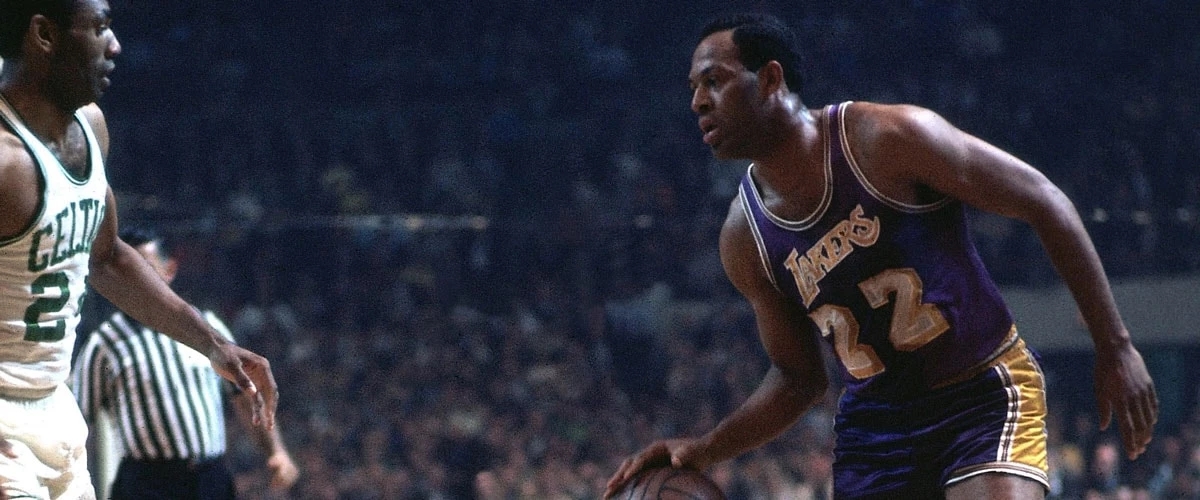
1965-68
Cooke Purchases Lakers For $5 Million
The Lakers franchise changed hands during the offseason when Bob Short sold the club to Jack Kent Cooke. Cooke paid $5 million for the team, which not only represented a huge profit but also established that the value of an NBA franchise was on par with the value of a Major League Baseball team.
Cooke left the team virtually intact. Center Darrall Imhoff and guard Walt Hazzard, who had been backups the season before, moved into the starting lineup for the 1965-66 season. Bob Boozer came to Los Angeles from New York and proved to be a valuable addition when sore knees sidelined Baylor. The Lakers also featured a promising young rookie from UCLA named Gail Goodrich.
Baylor had a tough season. Knee problems limited him to 65 games, and after scoring at least 24 points per game in each of his first seven seasons, his output dipped to just 16.6 points per contest. West (31.3 ppg) was as irrepressible as ever, trailing only Wilt Chamberlain in the NBA scoring race. The Lakers came away with the Western Division title but never really put together a hot streak during the regular season. Their best month was November, when they went 10-7. But they barely played above the .500 mark for the next three months and finished 45-35.
Los Angeles moved on to the postseason and bested the Hawks in seven games to reach the NBA Finals. Facing the Celtics for the fourth time in five years, Los Angeles stole Game 1 in an overtime thriller, then dropped three straight. Wins in Games 5 and 6 sent the series to a seventh game. Once again the Celtics prevailed, this time by the score of 95-93. Since 1959 the Lakers had faced Boston in the NBA Finals five times and had come away losers each time.
The Lakers stumbled out of contention in the 1966-67 campaign. Injuries kept Jerry West on the sidelines for 15 games and Elgin Baylor out of action for 11. The squad finished in third place in the Western Division and chalked up a losing record (36-45) for the first time since the 1960-61 campaign. San Francisco made short work of Los Angeles in the playoffs, ousting the Lakers in a three-game sweep.
That season ended Fred Schaus's reign as the team's head coach. The Lakers' pilot since the move to Los Angeles, he had guided them to the NBA Finals four times. His replacement was Bill "Butch" van Breda Kolff, who started the season in the new 17,500-seat Forum.
West missed 31 games during the 1967-68 campaign with injuries, but second-year guard Archie Clark blossomed into an offensive threat, averaging 19.9 points. Baylor led the team in scoring (26.0 ppg) and rebounding (12.2 rpg). The club improved by 16 games over the previous season, to 52-30, but finished in second place in the division behind St. Louis. The Lakers dispatched the Chicago Bulls in the division semifinals, then breezed by San Francisco in the division finals. That set up a sixth meeting between Los Angeles and Boston in the NBA Finals, and once again the Celtics came out on top, this time taking the series in six games.
Return to top of page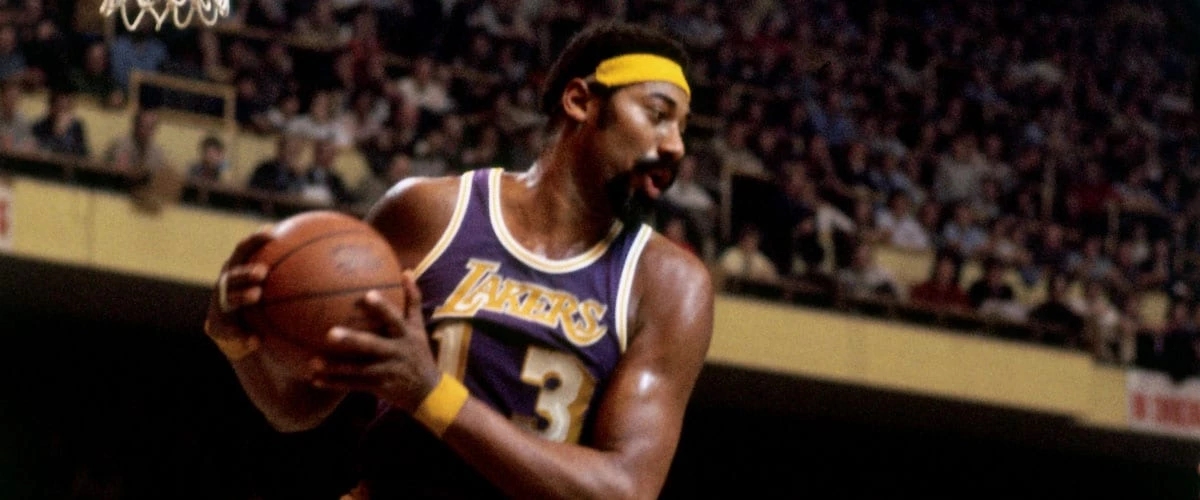
1968-69
L.A. Acquires A Supercenter
By now it had become clear to everyone that the Lakers were missing the one ingredient they needed to nail down a championship-a dominating center to complement West and Baylor. And time was running out-Baylor was 34 years old and playing on gimpy legs, and West was 30. So owner Jack Kent Cooke filled the gap by wresting supercenter Wilt Chamberlain away from the Philadelphia 76ers for Clark, Darrall Imhoff, and Jerry Chambers.
The 1968-69 Lakers weren't the dominating force that everyone expected them to be after the arrival of Chamberlain, but they did take the Western Division title with a 55-27 record. Chamberlain led the league in rebounding with 21.1 boards per game while West and Baylor each averaged better than 20 points.
In the playoffs the Lakers dropped the first two games of their division semifinal matchup with the San Francisco Warriors. But Los Angeles stormed back to win the next four, including a 118-78 romp in Game 6, and take the series, four games to two. The Hawks (now playing in Atlanta) came next, and the Lakers dispatched them in five games. That set up yet another Celtics-Lakers showdown, but with a new twist-a clash of the titans, with Chamberlain going up against old nemesis Bill Russell.
Los Angeles took the first two games and appeared to have a good chance at ending the Celtics' dominance. But Boston won Game 3 and then eked out a win in Game 4 after Sam Jones hit a shot at the buzzer to give the Celtics an 89-88 victory. The series went to seven games, with the deciding contest played at the Forum in Los Angeles. The Celtics built a 17-point fourth-quarter lead and then held on to win by two points. For the sixth time in eight years the Lakers had butted heads with the Celtics in the NBA Finals and had come away without a championship. Jerry West earned the first-ever NBA Finals Most Valuable Player Award. It was the only time the award was given to a member of the losing team.
Return to top of page
1969-71
West Cans Miracle Shot, But Reed Is The Real Hero
Coach Butch van Breda Kolff stepped down after the Finals and was replaced by Joe Mullaney, who took over a team that was badly bitten by the injury bug during the 1969-70 campaign. Chamberlain tore up his knee in the ninth game of the season and was lost until the playoffs. Baylor's injured knees limited him to 54 games. That placed most of the burden on West, who led the league with an average of 31.2 points. He couldn't keep the team at the top of the Western Division, however, and the Lakers finished with a 46-36 record, two games behind Atlanta.
Chamberlain and Baylor both recovered in time for the playoffs, but the Lakers nearly faced elimination at the hands of the Phoenix Suns in the division semifinals. Down three games to one, Los Angeles rallied with convincing wins in the final three games to take the series in seven. The Lakers then swept Atlanta in the division finals and moved on to face not the Celtics but the New York Knicks in the NBA Finals.
It was a dream matchup for the league, pitting the two most glamorous teams from America's two largest cities against each other. The Lakers and the Knicks split the first two games. In Game 3 at the Forum, Jerry West provided one of the most memorable moments in Finals history when he sank a 60-foot shot at the buzzer to send the game into overtime. New York won the game, 111-108, but West's miraculous heave helped earn him the nickname "Mr. Clutch."
Unfortunately for the Lakers, the Knicks' Willis Reed upstaged West with a memorable moment of his own. After Los Angeles evened the series with an overtime victory in Game 4, the teams returned to New York for Game 5. In the first half of that game Reed went down with a torn thigh muscle and didn't return. Despite trailing by 13 points at halftime, New York rallied without its center to post a 107-100 victory. Reed sat out Game 6, and the Lakers rolled to a 135-113 victory behind Wilt Chamberlain, who had 45 points and 27 rebounds, and West, who had 31 points and 13 assists.
It looked as if the Knicks would be without Reed in the deciding game. Then, moments before tip-off amid a deafening roar from the crowd at Madison Square Garden, Reed hobbled onto the court. He then scored the first two baskets of the game before returning to the bench, but the damage was done. With the crowd and Reed's teammates inspired, the Lakers fell, 113-99. For the seventh time in nine years the team had reached the Finals and come away empty.
The 1970-71 season saw the league expand to 17 teams and four divisions. Los Angeles was put into the Pacific Division alongside San Francisco, the San Diego Rockets, the Seattle SuperSonics, and the Portland Trail Blazers. The Lakers had Wilt Chamberlain back and healthy, but Elgin Baylor played in only two games because of ongoing knee problems. The team was helped by the addition of Harold "Happy" Hairston, who had joined the club midway through the previous season, and Gail Goodrich, who returned to Los Angeles after two years in Phoenix. Future Lakers Coach Pat Riley was acquired from Portland as a player.
With Baylor missing, West (26.9 ppg), Chamberlain (20.7 ppg), Hairston (18.6 ppg), and Goodrich (17.5 ppg) picked up the scoring slack. Chamberlain led the league in rebounding with 18.2 boards per game. The Lakers finished 48-34 and won the Pacific Division, seven games ahead of second-place San Francisco. Los Angeles squeaked by the Chicago Bulls in a tough conference semifinal series, then fell to Lew Alcindor (soon to be known as Kareem Abdul-Jabbar) and the Milwaukee Bucks in the Western Conference Finals.
Return to top of page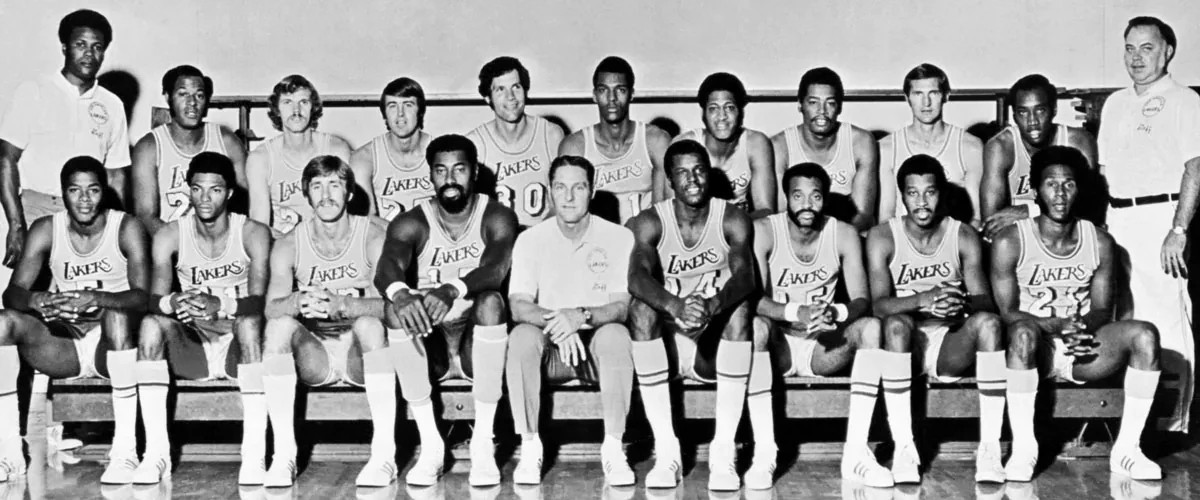
1971-73
33 In A Row!
Owner Jack Kent Cooke replaced Head Coach Joe Mullaney in 1971-72, bringing in former USC star and Celtics standout Bill Sharman. The team had to make do without Baylor, who retired early in the season after realizing that his legs were not going to hold up through another year. The Lakers may have lost Baylor, but they did have a balanced, mature, and experienced team with Hairston and second-year player Jim McMillian as forwards, Chamberlain in the pivot, and West and Goodrich at the guard spots.
The Lakers went 6-3 through the first month of the season. On November 5 they beat Baltimore, 110-106, marking the first of 14 straight wins in November. December saw them take 16 games without a loss. Along the way, the Lakers shattered the NBA mark of 20 consecutive victories set by the Milwaukee Bucks just one season before. Los Angeles won three straight to open the new year before the Bucks finally ended the string on January 9, besting the Lakers, 120-104. At that point the Lakers had rung up a 33-game winning streak, an American professional sports record.
The team rolled on to a 69-win year, setting a new NBA record for victories in a season, a record that would stand until the 1995-96 Chicago Bulls went 72-10. Chamberlain averaged a career-low 14.8 points, but it may nevertheless have been his finest season-he led the league in rebounding with 19.2 per game, was a defensive stalwart, and played outstanding team basketball. West led the league by dishing out 9.7 assists per game, and he and Goodrich each averaged better than 25 points. The team paced the league in points, rebounds, and assists. At season's end, Bill Sharman was named NBA Coach of the Year.
The Lakers breezed right through the playoffs, sweeping the Chicago Bulls in the conference semifinals, ousting the Bucks in six games in the conference finals, and then zipping by the Knicks in the Finals, four games to one. After years of frustration the Lakers had finally earned an NBA Championship, the team's first in Los Angeles and the first for the franchise since 1954. Chamberlain was named Most Valuable Player of the Finals.
The Lakers didn't match their record pace of the previous season during the 1972-73 campaign (although they won all 12 of their games in November), but they did roll to another Pacific Division title by winning 60 games overall. Wilt Chamberlain, playing in his final season, led the league in rebounding for the 11th time in his career. He also became the first player in NBA history to record a field-goal percentage above .700 -he finished at .727.
Los Angeles needed seven games to get by the Chicago Bulls in the conference semifinals, but they then breezed past the Golden State Warriors in the Western Division Finals. That set up an NBA Finals rematch between the Lakers and the New York Knicks. Los Angeles took the first game by three points, but the Knicks employed a pressing, trapping defense that forced the Lakers into an average of 19 turnovers and held them under 100 points in each of the final four games. New York took the series in five games to wrest the title away from the defending champions.
Return to top of page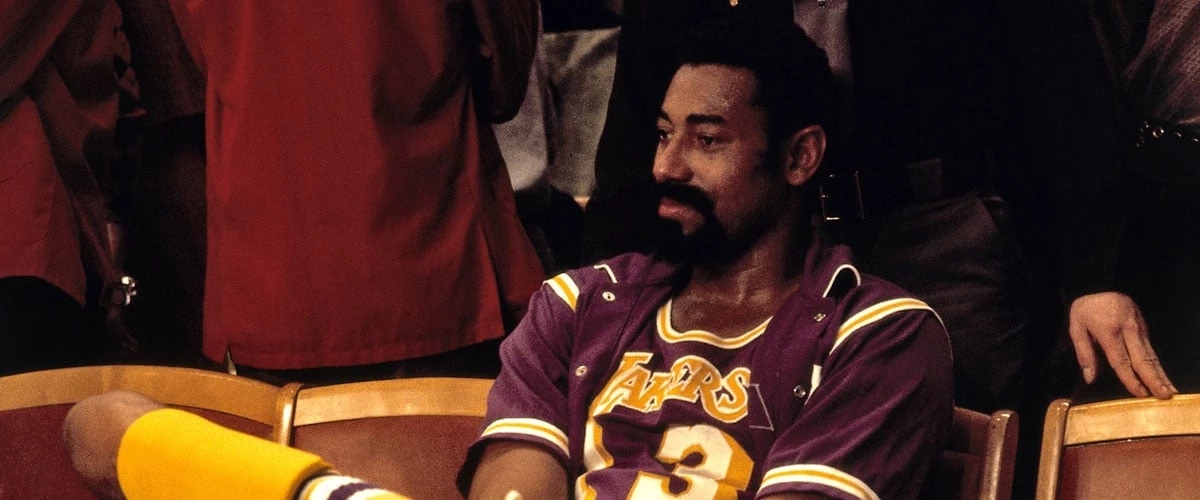
1973-75
Wilt Retires, West Shortly Follows Suit
Chamberlain, now 37 years old, retired. He left the NBA with a career average of 30.1 points per game. Of the 57 top scoring performances in NBA history, he had accounted for 47. In 14 years he had accumulated more than 31,000 points and had pulled down more than 23,000 rebounds. He was elected to the Naismith Memorial Basketball Hall of Fame in 1978.
For the 1973-74 season the Lakers picked up promising young defensive center Elmore Smith to plug the hole in the middle, and they also acquired Connie Hawkins to add some punch to the offense. But the team was hampered by the loss of Jerry West, who lasted only 31 games before his 35-year-old legs finally gave out. By that point the team's real star was Gail Goodrich, who averaged 25.3 points and helped engineer a late-season surge.
Trailing Golden State by three games with seven left to play, the Lakers rallied to win the Pacific Division with a 47-35 record, three games ahead of the Warriors. Los Angeles advanced to the postseason but managed only one win against Milwaukee in the conference semifinals.
The 1974-75 season found the Lakers in transition. West had retired after 14 incredible seasons in a Los Angeles uniform. Mr. Clutch had led the Lakers to the playoffs in every season of his career, including nine trips to the NBA Finals. He was an All-Star all 14 seasons and an All-NBA First Team selection 10 times. He finished with 25,192 career points and an average of 27.0 points per game. Truly one of the league's all-time greats, West scored more points as a Laker than any other player in the franchise's history.
For 1974-75 the team signed Cazzie Russell, who played just 40 games before a knee injury ended his season. Despite the addition of Lucius Allen (19.5 ppg) and another strong season from Goodrich (22.6), the club posted its first losing record in eight seasons, at 30-52. Los Angeles sat out the postseason for the first time in 17 years.
Return to top of page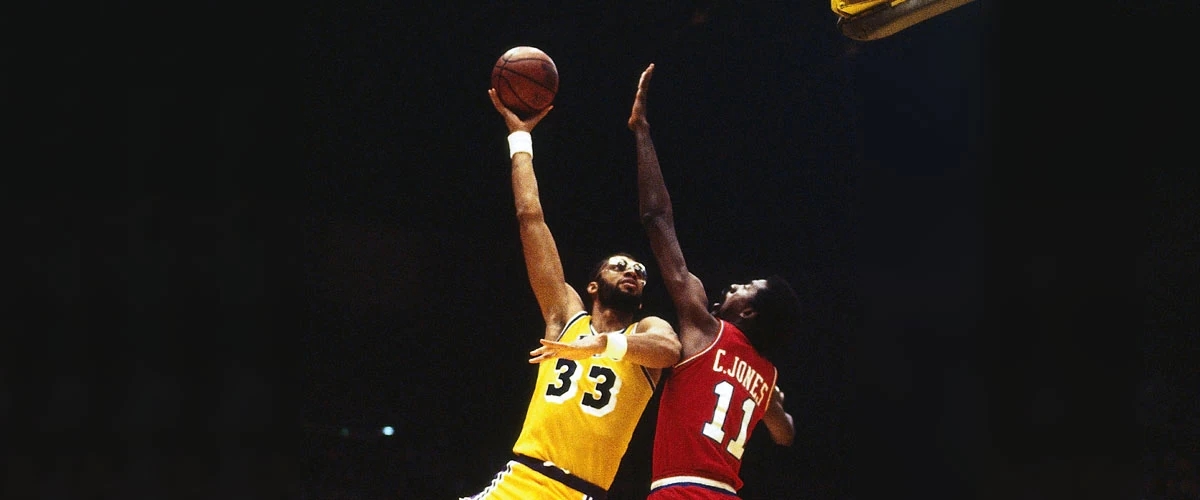
1975-79
Los Angeles Trades For Jabbar
During the offseason the Lakers made an acquisition that laid the foundation for yet another championship-caliber squad. Kareem Abdul-Jabbar, the league's premier big man, made it known that he would not return to Milwaukee after the 1974-75 season, demanding instead to be traded to either New York (where he had grown up) or Los Angeles (where he had attended college). He ended up going to the Lakers for Elmore Smith, Brian Winters, Junior Bridgeman, and Dave Meyers.
Abdul-Jabbar had an MVP season for Los Angeles in 1975-76. He led the league in rebounding, blocked shots, and minutes played and finished second in scoring and field-goal percentage. But the big trade paid higher short-term dividends for Milwaukee than it did for Los Angeles-the Bucks went from last to first in the Midwest Division.
The Lakers stumbled through a 3-10 January and finished out of the playoffs with a 40-42 record. At season's end, Abdul-Jabbar won the fourth of six career NBA Most Valuable Player Awards.
Jerry West replaced Bill Sharman as head coach during the offseason. The club lost Gail Goodrich, who signed with the New Orleans Jazz as a free agent. It took another MVP season from Abdul-Jabbar to carry the team back to the top of the Pacific Division, as the Lakers finished 1976-77 with a league-best 53-29 record. They barely survived a tough seven-game series against the Warriors to open the postseason before being defeated by Portland in the Western Conference Finals. The Trail Blazers swept the Lakers en route to an NBA Championship.
During the offseason the Lakers picked up Jamaal Wilkes from Golden State and signed first-round draft pick Norm Nixon. But the 1977-78 season got off to a horrendous start. Just two minutes into the campaign's first game Abdul-Jabbar punched Milwaukee's Kent Benson in retaliation for an overly aggressive elbow. Abdul-Jabbar broke his hand and was out for two months.
Then, on December 9, the Lakers' Kermit Washington got into a tussle with Kevin Kunnert of the Houston Rockets. Houston's Rudy Tomjanovich ran downcourt to break up the fight. Washington saw Tomjanovich running at him from behind and responded with a devastating punch that nearly ended Tomjanovich's career. Washington was fined and suspended for 60 days. Tomjanovich missed the entire season and underwent a series of operations to reconstruct his jaw, eye, and cheek.
The Lakers struggled through the first half of the season but rebounded to post a 28-13 mark during the campaign's second half. A 45-37 record earned them a matchup against Seattle in a best-of-three first-round playoff series. The Sonics, on their way to the NBA Finals under Coach Lenny Wilkens, eliminated Los Angeles.
Despite the early ouster, the pieces were beginning to settle into place for the Lakers. During the 1978-79 season the team got a sneak preview of the future with Kareem Abdul-Jabbar, Jamaal Wilkes, and Norm Nixon all turning in fine performances. The club posted a 47-35 record, then fell to the SuperSonics in the semifinal round of the playoffs.
Return to top of page1979
The Beginning Of The Buss Era
During the offseason owner Jack Kent Cooke sold his sports empire, which included the Lakers and the Great Western Forum, to Santa Monica real estate developer Jerry Buss for $67.5 million. Buss brought in Jack McKinney as the new head coach.
When the Lakers had let Gail Goodrich go to free agency prior to the 1976-77 season, they had no idea how significant Goodrich's departure would be for the team's future. Because Goodrich signed with the New Orleans Jazz as a veteran free agent, the Jazz had to compensate the Lakers. New Orleans did so by giving Los Angeles three draft picks, including its first-round pick in 1979. When the Jazz (who moved to Utah in 1979) finished with the league's worst record in 1978-79, the Lakers found themselves holding the No. 1 overall pick in the 1979 NBA Draft.
Return to top of page
1979-82
"Showtime" Arrives
Los Angeles picked Earvin "Magic" Johnson, an electrifying 6-9 point guard who had led Michigan State to the 1979 NCAA Championship. "Showtime" had arrived, and a dynasty was established almost overnight.
The 1979-80 season was one of intense drama for the Lakers. With the team at 10-4, Head Coach Jack McKinney suffered a serious injury in a bicycle accident and was replaced by Paul Westhead. The Lakers rallied to finish the season at 60-22, tops in the Pacific Division. Inspired by NBA All-Rookie Team member Johnson, Abdul-Jabbar turned in the best all-around performance of his career and earned his sixth and final Most Valuable Player Award. The Lakers were talented and deep-Jamaal Wilkes, Jim Chones, and Abdul-Jabbar made for an intimidating front line, and the backcourt of Johnson and Nixon could stand up to any guard tandem in the country. The Lakers' bench included Michael Cooper and Spencer Haywood.
Los Angeles walked all over Phoenix and Seattle in the first two rounds of the playoffs, taking each series in five games. The NBA Finals pitted the club against the Julius Erving-led Philadelphia 76ers, and the two teams split four close games to start the series. Abdul-Jabbar sprained his ankle in Game 5 but still scored 40 points to give the Lakers a 108-103 win.
Abdul-Jabbar was unable to play in Game 6, but Johnson stepped up to turn in one of the most remarkable performances in NBA Finals history. Still just a 20-year-old rookie, Johnson moved from guard to center and tallied 42 points, 15 rebounds, and 7 assists, single-handedly carrying the Lakers to a 123-107 victory and the NBA Championship. Johnson earned the first of three NBA Finals Most Valuable Player Awards.
The 1980-81 season was a major disappointment. The Lakers lost Magic Johnson for much of the season to a knee injury. Behind another brilliant year from Kareem Abdul-Jabbar (26.2 ppg, 10.3 rpg), the team turned in a 54-28 record and finished second behind the Phoenix Suns in the Pacific Division. But Los Angeles was stunned by the Houston Rockets in the first round of the playoffs. Led by Moses Malone, the Rockets bumped the Lakers in a best-of-three series, notching both victories in Los Angeles.
Owner Jerry Buss fired Coach Paul Westhead after the Lakers went 7-4 to start the 1981-82 season. Buss promoted Assistant Coach Pat Riley, a former Lakers backup point guard, to head coach on November 19, and the team won 17 of its next 20 games.
The Lakers took the Pacific Division title and then embarked on one of the most impressive playoff journeys in NBA history. They swept both Phoenix and the San Antonio Spurs with an average margin of victory of 11 points. Los Angeles then stretched its postseason winning streak to nine games by taking the first contest of the NBA Finals from the 76ers. Philadelphia came back to win Game 2, but the Lakers prevailed in the series, four games to two, to win their second title in three years. The team's playoff record that year was 12-2.
Return to top of page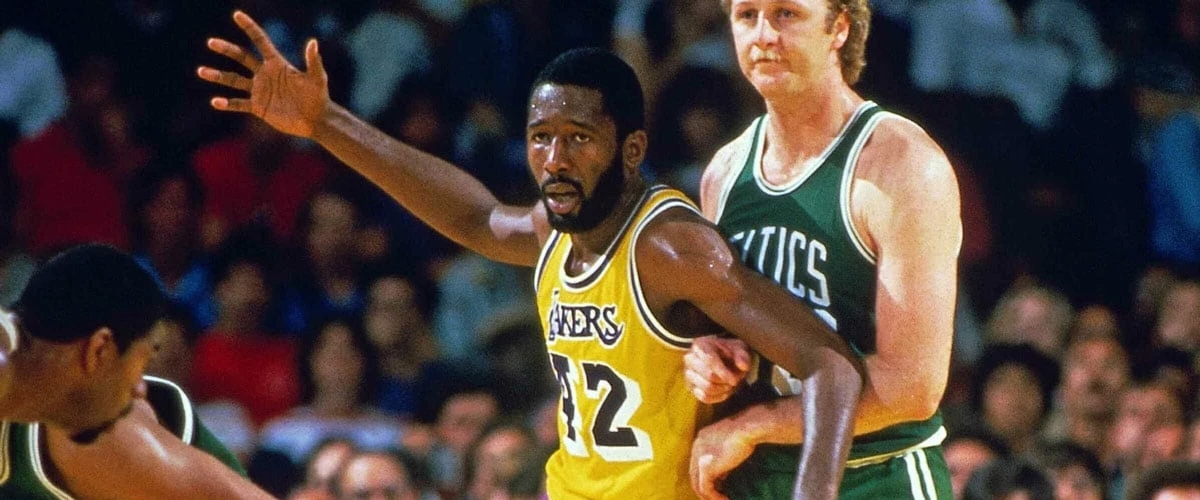
1982-83
A Worthy Draft Pick
The Lakers found themselves with an embarrassment of riches when, after winning the championship, they also ended up with the first overall pick in the 1982 NBA Draft. The situation was the result of a trade with Cleveland midway through the 1979-80 season, when the Lakers had sent Don Ford and a 1980 first-round pick (eventually Chad Kinch) to the Cavaliers for Butch Lee and their 1982 selection. Fortuitously for the Lakers, Cleveland had finished with the league's worst record in 1981-82, giving Los Angeles first crack at a talented crop of college players. It marked the first time in NBA history that a reigning champion held the No. 1 pick.
The Lakers used that pick to select forward James Worthy, who had just led North Carolina to the 1982 NCAA Championship. Worthy, Magic Johnson, and Kareem Abdul-Jabbar would define the powerhouse Lakers teams of the 1980s. Worthy proved to be the perfect complement to both players, finishing on the break for Johnson and stepping out to the perimeter when Abdul-Jabbar needed room to maneuver inside.
Worthy's rookie year ended in disappointment, however. He suffered a broken leg in the last week of the regular season and had to watch the postseason from the sidelines. The Lakers, who had won the Pacific Division with a 58-24 record, advanced to the 1983 NBA Finals with early-round victories against Portland and San Antonio. But Los Angeles was no match for the Philadelphia 76ers, who had acquired Moses Malone before the season. The Sixers won the series and the championship in four straight games.
Return to top of page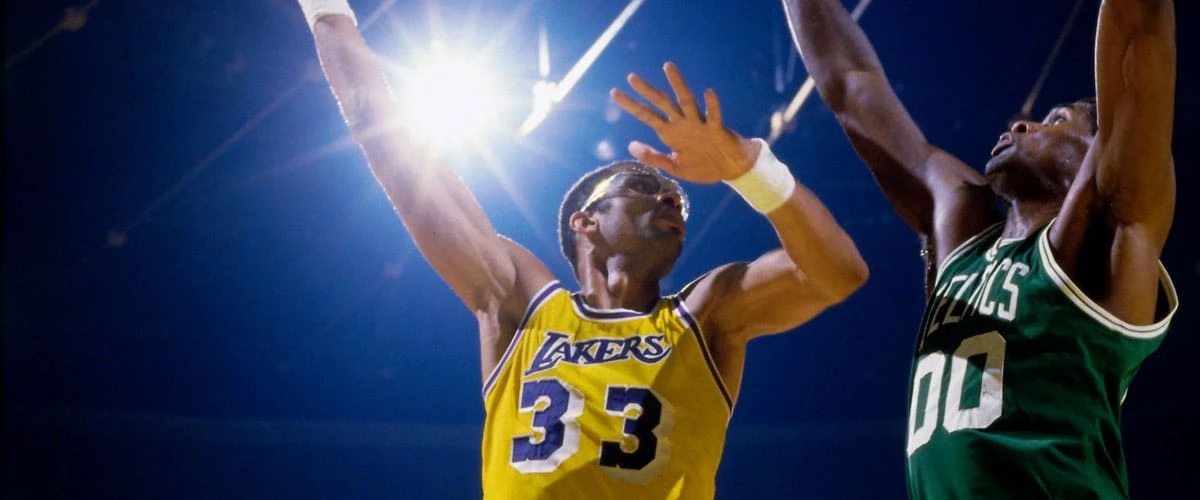
1983-84
Abdul-Jabbar Becomes NBA's All-Time Leading Scorer
During the offseason the Lakers sent Norm Nixon to San Diego for Byron Scott. Los Angeles started 1983-84 at 12-4, but on December 2 Magic Johnson sustained a dislocated right index finger and missed a month of action. Although he led the league with 13.1 assists per game, Johnson's injury prevented him from setting a probable NBA record for total assists in a season. The Lakers garnered their share of NBA records that year anyway. On April 5 Kareem Abdul-Jabbar became the NBA's all-time leading scorer when he scored point No. 31,420 against Utah to pass Wilt Chamberlain.
The Lakers reached the NBA Finals in 1984 by roaring past the Kansas City Kings, the Dallas Mavericks, and the Phoenix Suns in the early rounds. That set up a Larry Bird-Magic Johnson matchup as Los Angeles and Boston squared off for the championship. Los Angeles took Game 1, then held a two-point lead in Game 2 with 15 seconds remaining when Gerald Henderson picked off a James Worthy pass and scored a layup to send the game into overtime. Boston prevailed, 124-121, and then the teams split the next four games. The Celtics had never lost Game 7 in an NBA Finals series, and tradition held. Boston triumphed, 111-102.
Return to top of page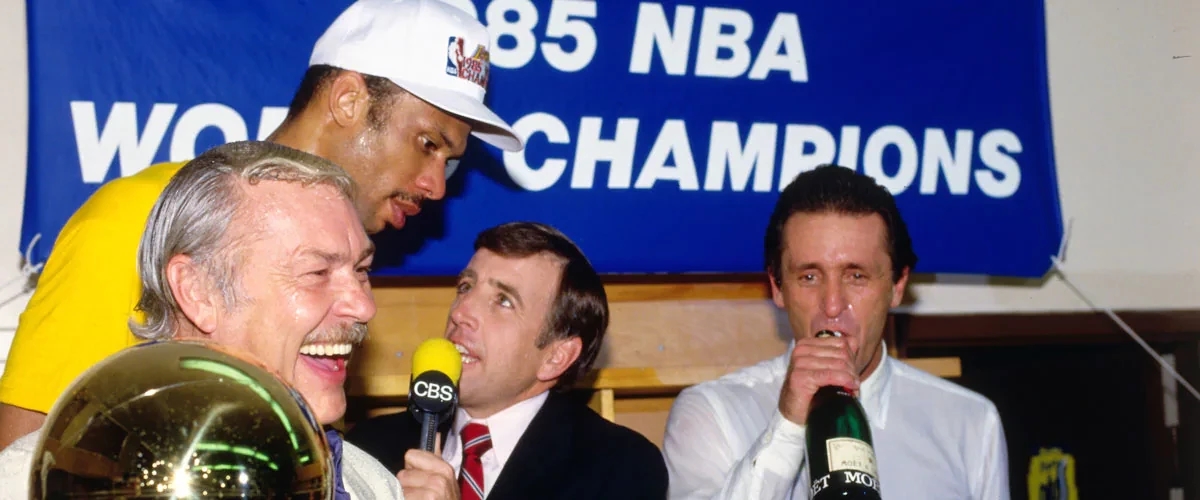
1984-86
Finally! Lakers Beat Celtics In Finals
The Lakers cruised to a fourth straight Pacific Division title in 1984-1985 despite losing Jamaal Wilkes for the season in mid-February because of torn knee ligaments. Los Angeles (62-20) took the division by an NBA-record 20 games. The club, at the height of its "Showtime" era, set two other NBA marks by posting a phenomenal .545 team field-goal percentage and handing out 2,575 assists.
Los Angeles reached the NBA Finals after eliminating Phoenix, Portland, and the Denver Nuggets, chalking up an 11-2 record on the way. Facing Boston again in the championship round, the Lakers were humiliated in the first game, 148-114, a contest remembered as the "Memorial Day Massacre." But Los Angeles bounced back to take four of the next five games, led by 38-year-old series MVP Kareem Abdul-Jabbar. The 1985 series marked the ninth time that Los Angeles and Boston had met in the NBA Finals but the first time that the Lakers had come away with the crown.
Jamaal Wilkes left the Lakers before the 1985-86 season. (He played only 13 games with the Clippers before retiring.) Los Angeles continued to rebuild, adding 33-year-old Maurice Lucas, who gave the team some muscle, and rookie A. C. Green. The Lakers also had power forward Kurt Rambis, a bespectacled, blue-collar fan favorite who had joined the team in 1981. Rambis spent seven seasons in a Los Angeles uniform.
The team got off to a blazing start, with records of 11-1, 19-2, and 24-3 early in the season. Los Angeles won 62 games for the second year in a row and finished 22 games ahead of second-place Portland in the Pacific Division. Abdul-Jabbar was playing in an unprecedented 17th season, and he set new NBA career records for minutes and games played while averaging 23.4 points. Johnson paced the league in assists (12.6 apg) for the third time in six seasons.
The Lakers seemed headed for an NBA Finals rematch with the Boston Celtics, who had ripped through the Eastern Conference with a 67-15 record. The Celtics lost only one game en route to the Finals, but the Lakers failed to hold up their part of the bargain. After eliminating San Antonio and Dallas in the first two rounds, Los Angeles met Houston in the Western Conference Finals. Led by twin towers Hakeem Olajuwon and Ralph Sampson, the Rockets took a surprising series lead after four games. But the teams headed back to Los Angeles for Game 5, where the Lakers expected to regain the momentum. Instead, Sampson stunned the Lakers with a miraculous turnaround jump shot at the buzzer, breaking a 112-112 tie to give Houston the series victory. The Rockets managed two victories against the Celtics in the Finals but lost the series.
Return to top of page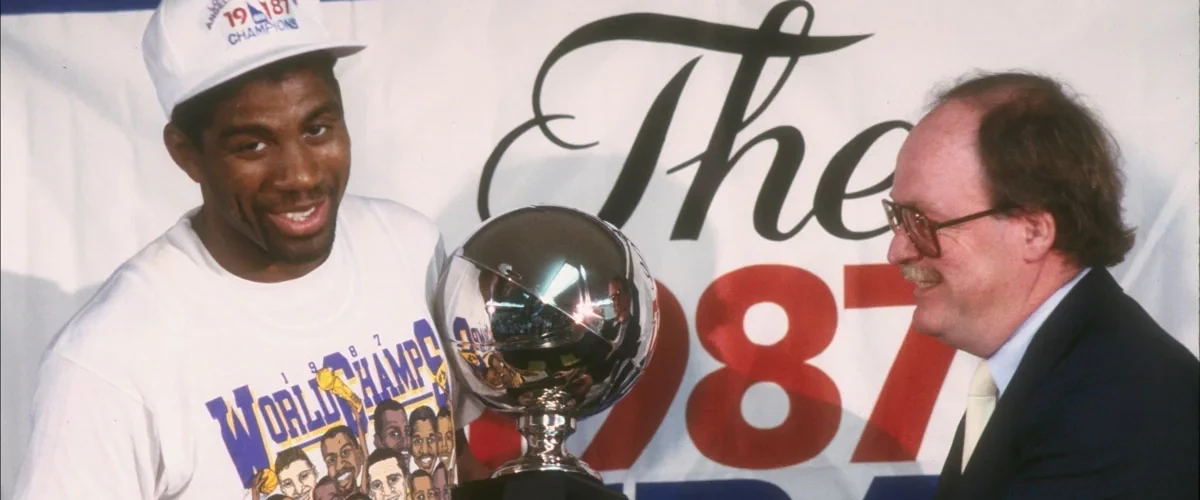
1986-87
A Very Magic Year
Once again the Lakers made a couple of key offseason moves, letting go of Maurice Lucas, moving A. C. Green into the starting lineup, and picking up Mychal Thompson from San Antonio. Head Coach Pat Riley also made a tactical adjustment in 1986-87 by shifting the offensive focus from Kareem Abdul-Jabbar to Magic Johnson.
The moves paid off. Johnson won his first career NBA Most Valuable Player Award while leading the Lakers to a 65-17 record, the second-best mark in franchise history. Abdul-Jabbar, now 39 years old, chipped in 17.5 points per game, and Michael Cooper was named NBA Defensive Player of the Year.
The Lakers earned another matchup with the Celtics in the NBA Finals by sweeping Denver, losing just one game to Golden State, and then sweeping Seattle. Los Angeles routed Boston in the first two games of the Finals, and the teams then split the next four contests, giving the Lakers their second championship in three seasons.
Johnson earned the NBA Finals MVP Award to go with his regular-season MVP trophy. At the Lakers' championship celebration in Los Angeles, Coach Riley brashly declared that the Lakers would repeat as NBA champions in 1987-88. It was a bold statement that served to motivate the team throughout the next season.
Return to top of page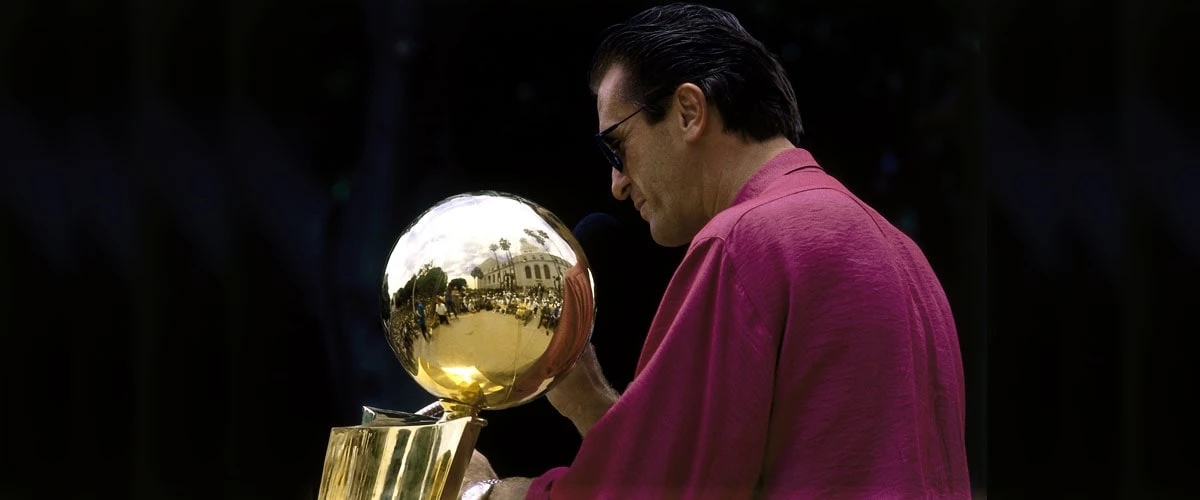
1987-88
Lakers Fulfill Riley's Prophecy
Los Angeles made no major moves before the 1987-88 campaign. The Lakers opened the season with an eight-game winning streak but lost six of their next nine games. They snapped out of the uncharacteristic slump with a 115-114 victory in Boston on December 11 that ignited a 15-game winning streak, the second longest in franchise history.
The club finished with a 62-20 record and a seventh consecutive Pacific Division title. After sweeping San Antonio in the first round of the playoffs, Los Angeles was forced to the limit in each of the next two series. The Lakers struggled against both the Utah Jazz and the Dallas Mavericks before winning each series in seven games. In the NBA Finals the Lakers had a new opponent in the Detroit Pistons. The Pistons had grown into an Eastern Conference power thanks to Isiah Thomas, Joe Dumars, Bill Laimbeer, and Dennis Rodman. Detroit had managed to unseat the Celtics in six games in the Eastern Conference Finals.
The NBA Finals represented a clash of styles, with the run-and-gun Lakers battling the physical Pistons. The series went a grueling seven games, with players on both sides turning in heroic performances. The most heroic of all was turned in by James Worthy, who had a triple-double in Game 7 to lead the Lakers to a 108-105 victory. Worthy was named Finals MVP, and Los Angeles became the first club to repeat as NBA champions since the Boston Celtics in 1968-69.
Return to top of page
1988-90
Kareem Calls It A Career
The next year marked the 20th and final NBA campaign for 41-year-old Kareem Abdul-Jabbar. The 1988-89 Lakers won 57 games, the 10th year in a row that they had topped the 50-victory mark, and maintained their stranglehold on the Pacific Division crown by finishing two games ahead of Phoenix. Magic Johnson earned his second NBA Most Valuable Player Award.
Three-quarters of the way through the playoffs it looked as if Abdul-Jabbar's career would have a perfect ending. The Lakers reached the NBA Finals by sweeping Portland, Seattle, and Phoenix. No other team in NBA history had ever earned sweeps in three series in one year. But the Finals rematch with the Pistons didn't go according to plan. Hamstring injuries to Johnson and Byron Scott hobbled the Lakers, and Detroit swept Los Angeles out of the playoffs and Abdul-Jabbar into retirement.
The 1989-90 Lakers adjusted very quickly to the absence of Kareem Abdul-Jabbar, moving Mychal Thompson into the starting lineup and bringing over Vlade Divac from what was then Yugoslavia. The team rolled to another 60-win season, its fifth in six years, and Johnson claimed his second straight MVP trophy (and third in four seasons). The Lakers won the Pacific Division for the ninth consecutive season.
Heading into the playoffs, another Lakers-Pistons Finals seemed likely. But in the Western Conference Semifinals, Los Angeles was overpowered by a tough Phoenix team that included Kevin Johnson, Eddie Johnson, Tom Chambers, and Jeff Hornacek. The Suns won the series in five games.
Return to top of page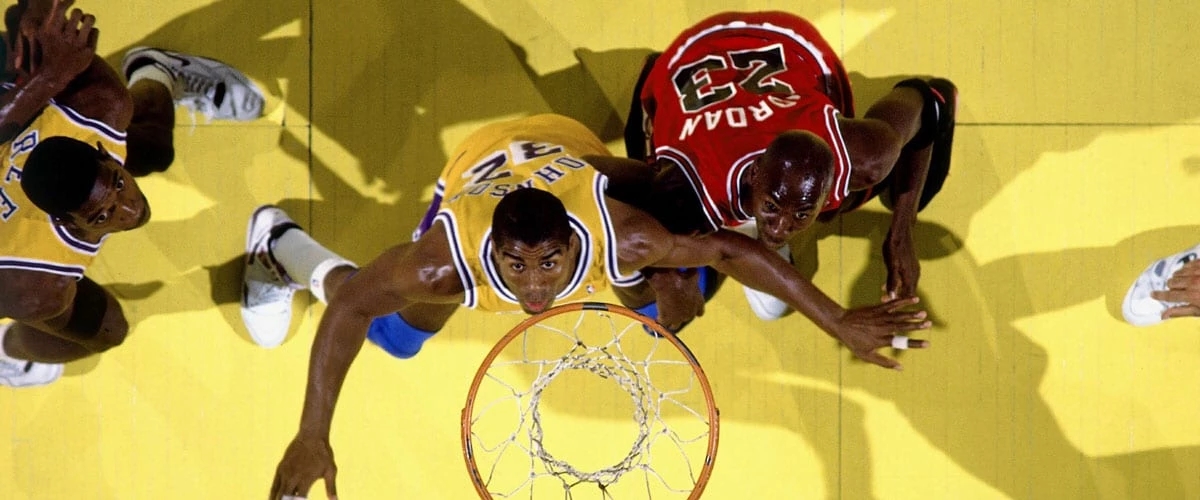
1990-91
Riley Steps Down, But L.A. Still Advances To Finals
After winning the NBA Coach of the Year Award for 1989-90, Pat Riley stepped down during the offseason. His nine-year reign in Los Angeles had yielded incredible numbers: a .733 regular-season winning percentage, a 102-47 playoff record, nine Pacific Division titles, and four NBA Championships. Mike Dunleavy was appointed to fill Riley's shoes, and the team signed free agent Sam Perkins from Dallas.
Los Angeles got off to a slow start under Dunleavy, with a 2-5 record to open the year. But the team won eight straight after that and then strung together 16 consecutive wins at midseason. An important milestone was reached on April 15 when Magic Johnson handed out career assist No. 9,888 to pass Oscar Robertson and become the NBA's all-time assists leader.
The 1990-91 Lakers won 58 games but finished in second place in the Pacific Division to the high-powered Portland Trail Blazers. Los Angeles had no problem with either Houston or Golden State in the first two rounds of the playoffs but found itself in the unaccustomed position of underdog against Portland in the Western Conference Finals. The Lakers upset the Blazers by winning the series in six games but then fell victim to the Chicago Bulls and Michael Jordan in the 1991 NBA Finals. Los Angeles won Game 1 against the Bulls on a last-second three-pointer by Perkins. But Chicago roared back to take four straight and the championship, the first of three consecutive titles for the Bulls.
Return to top of page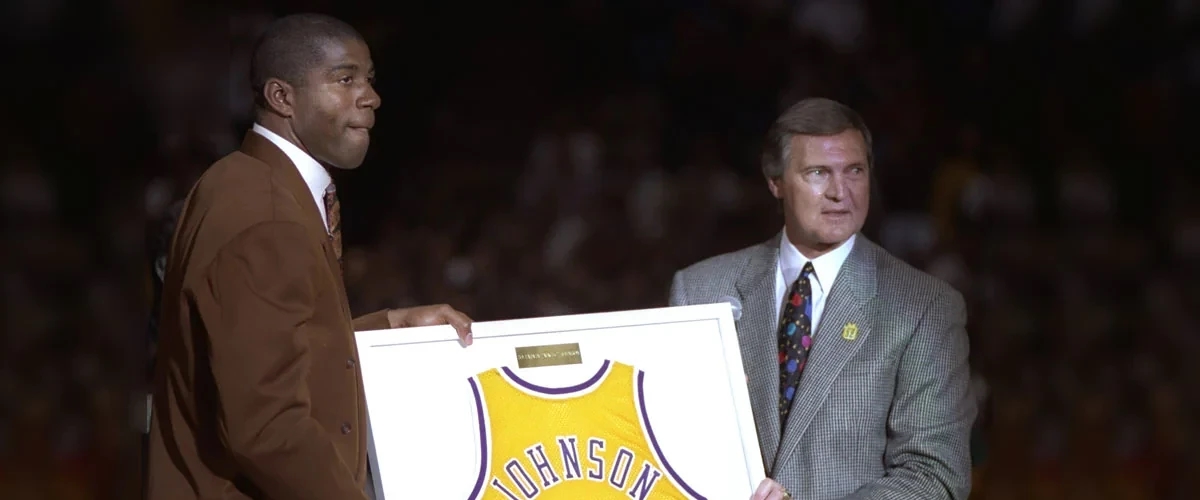
1991-92
Magic Shocks The World
The following season was a roller-coaster ride for the team. Los Angeles went 1-2 in three straight overtime games to start the season. Then on November 7, 1991, Magic Johnson shocked the world when he announced his retirement, having tested positive for the HIV virus. The Lakers responded on the court with a nine-game winning streak. In early December center Vlade Divac underwent surgery for a back problem and was lost for two months. Divac's absence contributed to a 6-8 showing by the club in December, the Lakers' first losing month since March 1979.
Although he had retired, Johnson was voted to the 1992 NBA All-Star Game and, in a rousing performance, earned the game's MVP Award. That was the high point of the season for the Lakers. The team qualified for the playoffs for an NBA-record 16th straight year, but they limped through the final month of the season after losing James Worthy and Sam Perkins to injuries. Los Angeles was eliminated in four games by Portland in the first round of the playoffs.
After Johnson's stunning announcement in November, he went on a season-long crusade to help increase AIDS awareness and raise money for AIDS research. For his tireless efforts Johnson was presented with the NBA's J. Walter Kennedy Citizenship Award, given annually to that member of the NBA family who makes outstanding contributions to the community.
Johnson's playing career wasn't quite finished, however. He joined Larry Bird and Michael Jordan on the U.S. Dream Team at the 1992 Summer Olympic Games in Barcelona and helped the team win a gold medal. Wherever he went during the Olympics, Johnson found himself mobbed by fans, reporters, and even fellow athletes. He had truly become an international icon.
Perhaps bolstered by his Barcelona experience, Johnson declared that he would return to the Lakers for 1992-93. He practiced and played with the team throughout the preseason but then called it quits again before the start of the campaign, citing personal reasons.
Thus, one of the most dynamic and successful players in NBA history, just two years removed from the NBA Most Valuable Player Award, brought his career to a premature close. Johnson was 33 years old and had accomplished so much, yet he still had so much to accomplish. His career ledger was impressive. In 12 seasons he had led the Lakers to five championships; he had won three NBA MVP Awards, three NBA Finals MVP Awards, and an Olympic gold medal; and he had earned 12 All-Star selections (including 1992), two All-Star Game MVP Awards, and nine All-NBA First Team selections.
At the time of his retirement Johnson also ranked as the NBA's all-time career assists leader with 9,921. With his spectacular passing skills, Johnson had made team basketball glamorous again. He had also rekindled one of the league's greatest rivalries by facing off with Boston and Larry Bird three times in the NBA Finals.
Return to top of page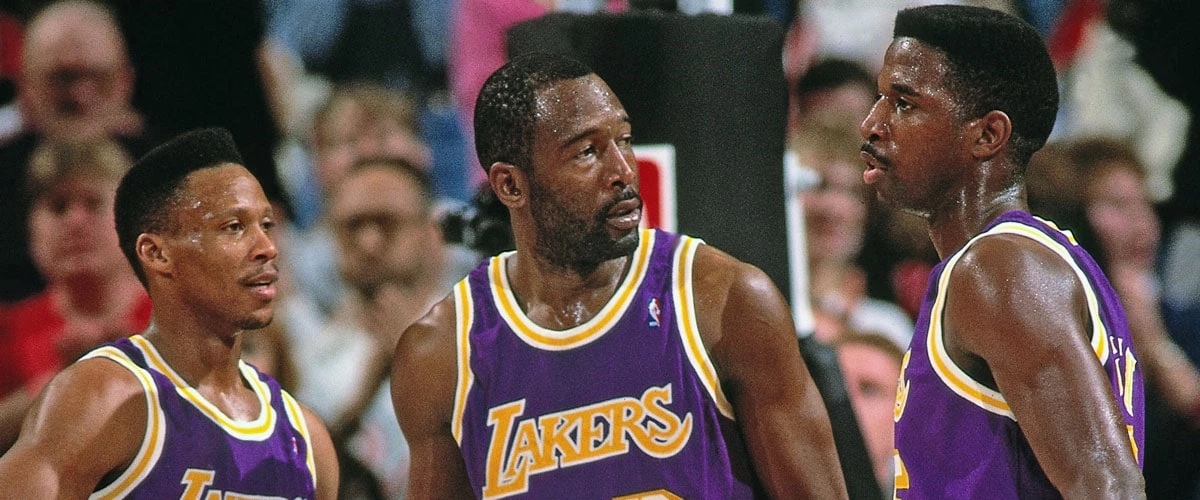
1992-93
Not A Very Pfund Year For The Lakers
Prior to the 1992-93 season Mike Dunleavy departed the Lakers to become head coach and vice president of basketball operations for the Milwaukee Bucks. Los Angeles promoted longtime assistant Randy Pfund to the head coaching role.
The Lakers had a difficult season, struggling to mesh young talent such as Vlade Divac, Elden Campbell, and Anthony Peeler with veterans such as James Worthy, A. C. Green, and Byron Scott. Veteran Sedale Threatt, whom Los Angeles had acquired from Seattle prior to the 1991-92 campaign, assumed Johnson's vacated point guard role for the second consecutive year. Threatt led the team in both scoring (15.1 ppg) and assists (6.9 apg), but something was still missing.
At midseason the Lakers sent Sam Perkins to Seattle for Benoit Benjamin and the rights to unsigned rookie Doug Christie, an athletic swingman who seemed to have star potential. The move was a signal that the Lakers intended to rebuild with youth, a philosophy that would hit home when they let both Green and Scott go to free agency after the season.
The Lakers finished the campaign at 39-43, barely earning the eighth and final playoff berth in the Western Conference. They drew the Phoenix Suns in the first round of the postseason and nearly staged one of the greatest upsets in NBA Playoff history. The Suns had climbed onto the shoulders of newly acquired superstar Charles Barkley and had ridden him to the NBA's best record at 62-20.
The Lakers, however, stunned Phoenix by opening the series with two straight victories at America West Arena. The Suns, who had been favored by many to win the championship, suddenly seemed on the verge of collapse, especially with the series heading to Los Angeles for two games. But Phoenix won both games in Los Angeles, forcing a deciding Game 5 back in Phoenix. The Lakers hung tough, forcing the contest into overtime before finally losing, 112-104.
Return to top of page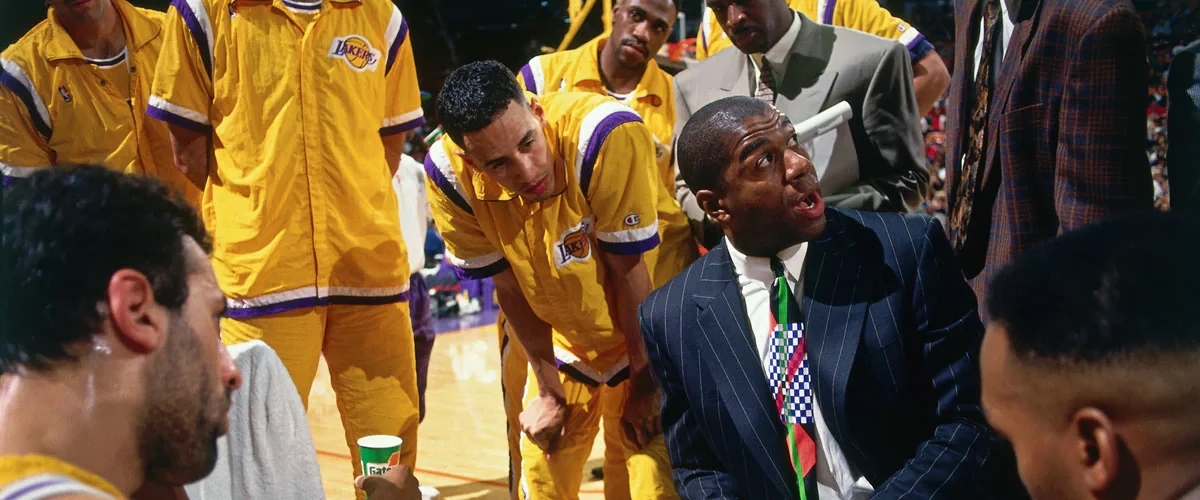
1993-94
Not Even A Little Magic Can Lift The Lakers
Magic Johnson had another moment in the Lakers' sun in 1993-94, but it was brief and added only a glimmer of excitement to the club's worst season in almost two decades. The Lakers lost their last 10 games and finished at 33-49, out of the playoffs for the first time since the 1975-76 season. The record was the second worst since the club had come to Los Angeles in 1960. The 1993-94 Lakers had trouble both on offense and defense. The team yielded opponents an average of 104.7 points per game (19th in the league), while its offense generated a franchise record low of 100.4 points per contest.
Individually, Vlade Divac was the team's top scorer with 14.2 points per game, and rookie Nick Van Exel proved to be the steal of the 1993 NBA Draft. A second-round pick, Van Exel started 80 games for the Lakers at point guard, scored 13.6 points per contest, and earned a spot on the NBA All-Rookie Second Team. Second-year players Anthony Peeler and Doug Christie, considered part of the club's core for the future, missed a combined 69 games because of injuries.
With the team sputtering in late March, the Lakers replaced Coach Randy Pfund with Johnson, hoping that he would take a liking to coaching and stay on for 1994-95-and that his championship magic would rub off on the team. With Johnson at the helm, the Lakers captured five of the next six games, defeating such teams as the Houston Rockets and the Atlanta Hawks, and began battling for the final playoff spot in the Western Conference. But reality soon set in, and Los Angeles dropped nine straight games. Before season's end Johnson announced that he would not return to guide the Lakers for the next year. In the offseason Del Harris was named the team's new head coach.
Return to top of page
1994-95
Newcomers Key Lakers' Revitalization
The Los Angeles Lakers were one of the league's most improved teams in 1994-95, and their playoff success augured well for the future. The Lakers had finished the previous season with a 33-49 record; in 1994-95 the team was 48-34. The 15-win improvement was second best in the league behind that of the Dallas Mavericks. Aside from the emergence of electrifying point guard Nick Van Exel, three new arrivals keyed the Lakers' turnaround: Head Coach Del Harris, free-agent signee Cedric Ceballos, and rookie Eddie Jones.
The postseason was even more satisfying. The Lakers earned a No. 5 seed in the playoffs, finishing in front of the defending NBA-champion Houston Rockets, and they met the fourth-seeded Seattle SuperSonics in the first round. Los Angeles was defeated soundly in Game 1 but responded with three straight victories to score an upset. Van Exel, who made a name for himself in the postseason, averaged 24.8 points and shot .500 from the field against the Sonics. In Game 3 of that series he set a team record by playing 48 minutes without committing a single turnover-all the more impressive considering that he handled the ball against a Seattle team that had led the league in steals.
In the Western Conference Semifinals the Lakers met the San Antonio Spurs, who had finished the season with the league's best record. Los Angeles won two games in an exciting series but fell to the Spurs in six. In Game 5 at San Antonio, with the Lakers down three games to one, Van Exel hit two buzzer-beating three-pointers-one at the end of regulation and one at the end of overtime-to give the Lakers a 98-96 victory.
For his team's effort, Harris was named NBA Coach of the Year. General Manager Jerry West was named NBA Executive of the Year for his work behind the scenes. On the court, Ceballos had a terrific season in his first year with the Lakers, averaging 21.7 points, 8.0 rebounds, and 1.03 steals and earning selection to the All-Star Game, although he didn't participate because of an injury. Van Exel averaged 16.9 points and 8.3 assists in the regular season, while center Vlade Divac averaged 16.0 points, 10.4 boards, and 2.18 blocks. Athletic swingman Jones averaged 14.0 points and won a spot on the NBA All-Rookie First Team.
Return to top of page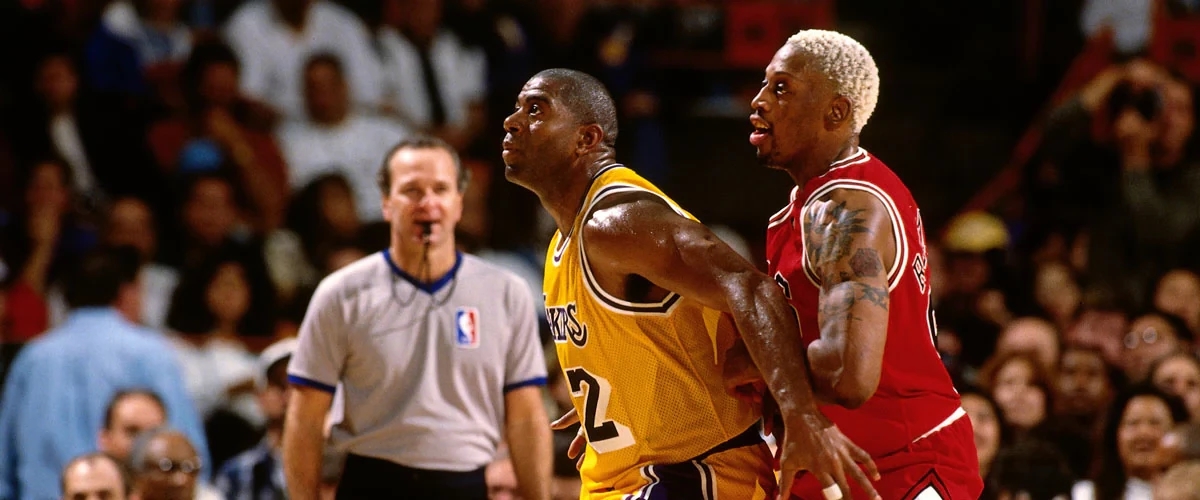
1995-96
Magic Returns To The Court
The 1995-96 season gave the Lakers much cause for optimism. After all, they were coming off of a first round upset of the Seattle Sonics and their best season since 1990-91. Not many, though, could have predicted that "Showtime" would return to Los Angeles with the return of Magic Johnson.
The Lakers were already a talented team -- featuring Nick Van Exel and second-year player Eddie Jones in the backcourt and a frontline of Vlade Divac, Elden Campbell and Cedric Ceballos. On January 30, they added a legend. Johnson, who after talking about it for years, finally made the decision to come out of retirement.
Although his statistics were impressive (15.3 ppg, 8.5 rpg and 6.5 apg), his arrival did upset the delicate chemistry of a team that had gotten a whole lot younger. In spite of the turmoil, which included a brief unexcused absence by leading scorer Ceballos, the Lakers returned among the league's elite, posting 53 wins, and a second place finish in the Pacific Division.
In the playoffs, the Lakers had the challenge of unseating the two-time defending champion Houston Rockets. Not even the Magic of Magic could save the Lakers, who fell to the Rockets in four games.
The conclusion of the season began an offseason of change for the Lakers, who stayed true to their history and acquired a franchise center in the rich tradition of Chamberlain and Abdul-Jabbar. The arrival of Shaquille O'Neal necessitated the trading of longtime center Vlade Divac, and the trading or renouncement of several other veterans. A new look Laker team would take the floor in 1996-97.
Return to top of page
1996-97
Shaquille Goes Showtime
The Los Angeles Lakers dipped into the free agent coffers prior to the 1996-97, wresting away prized center Shaquille O'Neal from the Orlando Magic. O'Neal, a 7-1 center with a rare combination of power and quickness, averaged 27.2 ppg and 12.5 rpg in four seasons with the Magic, leading Orlando to the NBA Finals in 1995.
O'Neal was just the tonic to rekindle championship hopes in Los Angeles. He paid immediate dividends for the Lakers, leading them to a 56-26 record, their best effort since 1990-91, despite missing 31 games with a knee injury. O'Neal averaged 26.2 ppg and 12.5 rpg (but did not qualify for the league leaders in either category due to his injury), and finished third in the league in blocked shots (2.88 bpg) and fourth in field goal accuracy (.557). In the 51 games that O'Neal played, Los Angeles was 38-13.
Opponents of the Lakers were faced with more than a Shaq Attack. The team featured several of the quickest, youngest, most versatile players in the NBA, including Nick Van Exel, Eddie Jones, Elden Campbell and Robert Horry, as well as an 18-year-old rookie, Kobe Bryant, who showed flashes of brilliance at All-Star Weekend, winning the Slam Dunk competition and scoring a game-high 31 points in the Rookie Game.
Jones (17.2 ppg) received his first All-Star berth, while Van Exel averaged 15.3 ppg and finished eighth in the NBA with 8.5 apg. His 23 assists against Vancouver on Jan. 5 were an NBA season high. Campbell also enjoyed the best season of his career, averaging 14.9 ppg and 8.0 rpg, and filling in ably during the O'Neal injury. Horry, acquired from Phoenix for Cedric Ceballos during the season, provided additional spark, setting an NBA playoff record for three-point playoff goals without a miss with a 7-for-7 effort against the Utah Jazz.
Despite Horry's heroics, the Jazz was more than the Lakers could handle. The Lakers dispatched Portland in the first round before losing to Utah in the Western Conference Semifinals, 4-1. O'Neal's 46-point effort in Game 1 against the Trail Blazers marked the highest single-game playoff scoring output by a Laker since Jerry West tallied 53 against the Boston Celtics in 1969.
Return to top of page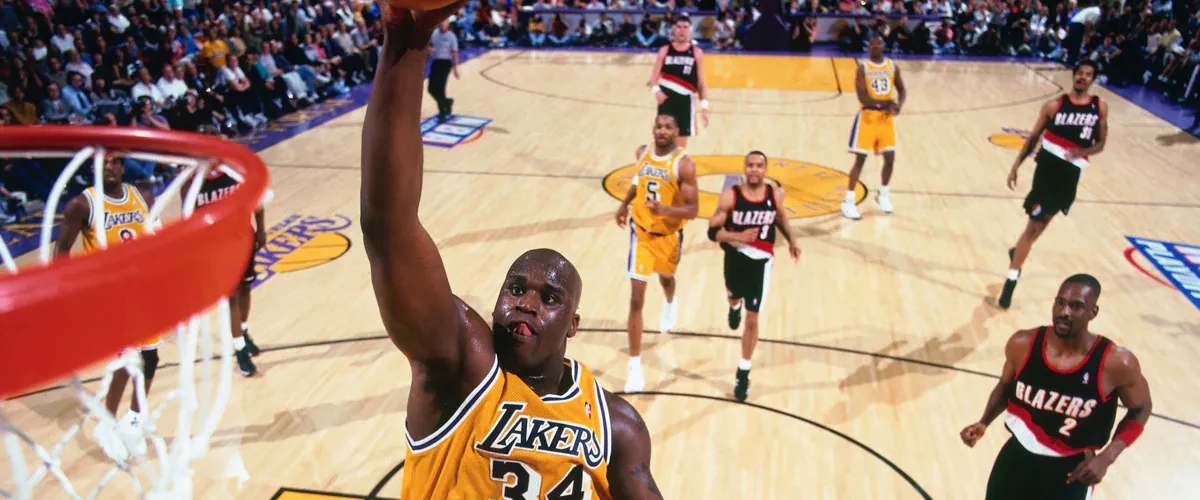
1997-98
Showtime Once Again
In the second season of the Shaquille O'Neal era, the Los Angeles Lakers survived early injuries to the gargantuan center, then climbed upon his broad shoulders and ascended all the way to a 61-win season and a berth in the Western Conference Finals.
O'Neal and the Lakers immediately served notice of their improvement with the best start in franchise history. The Lakers started 11-0, then endured a stretch of 20 games that O'Neal missed because of an abdominal injury. That key stretch, during which the Lakers were 13-7, gave other players the opportunity to step up and prove that the Lakers proved they were more than a one man show.
In Shaq's absence, Nick Van Exel, Eddie Jones and Kobe Bryant stepped into the limelight and shined, picking up the offensive slack while Elden Campbell manned the middle. Versatile forwards Robert Horry, Rick Fox and Derek Fisher rounded out the nucleus of the one of the youngest and quickest teams in the NBA -- the only NBA team without a single player over the age of 30. With Jones, Bryant and Van Exel running and gunning, and the January return of the dominant O'Neal inside, the Lakers possessed the most prolific offense in the NBA (105.5 ppg). All four players were rewarded for their effort, as the Lakers became the first team in 15 seasons to send four players to the All-Star Game.
All season, the Lakers found themselves embroiled in a fierce battle with Seattle for the Pacific Division title. On Mar. 16, Seattle scored a 101-89 win to take a four-game lead in the division with only five weeks remaining in the season. But the Lakers wouldn't give up. In the final two months of the season, no team played better ball than the Lakers, who won 22 of their final 25 games. O'Neal led the team in scoring in all but two of those games, including a 50-point effort in a 117-106 win over New Jersey.
O'Neal averaged 28.3 ppg for the season to finish a close second to Michael Jordan (28.7 ppg) in the scoring race, and was among league-leaders in rebounds (11.4 rpg) and blocks (2.40 bpg), while leading the league with a field-goal percentage of 58.4 percent. With their late-season surge, the Lakers captured Seattle atop the Pacific at 61-21. Their paths crossed in the second round, after the Lakers disposed of Portland with a 3-1 win in the first-round best-of-five. A series destined to be a classNameic instead was a one-sided affair. After Seattle won the first game, the Lakers responded with four straight wins, making quick work of their division rival.
What looked to be a Laker steamroller rolled to a halt in Salt Lake City, where the Lakers were swept in four games by the Utah Jazz, putting a damper on an otherwise exceptional season in which Los Angeles was stopped one series short of reaching the Finals for the first time since 1991.
Return to top of page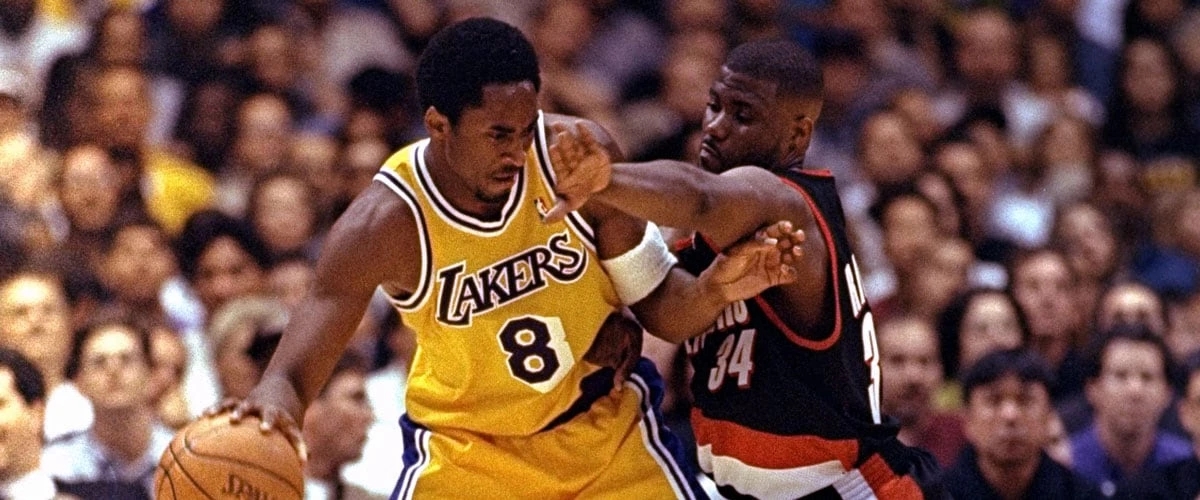
1998-99
Busy Times in Brief Season
The Lakers made a blockbuster trade, changed coaches, brought a seven-time rebounding champion on board for awhile and closed out their historic arena. In other words, they squeezed an entire year's worth of action into a lockout-shortened season.
By the time the regular season was over, Shaquille O'Neal and Kobe Bryant had led the Lakers to a 31-19 record. They advanced to the Western Conference semifinals, where they lost to San Antonio in four games.
The Lakers' 118-107 loss to the Spurs in Game 4 on May 23, 1999, marked the last meaningful game in the Great Western Forum, home to six championship teams in 32 years. Los Angeles would play two more preseason games at the Forum the following season before moving into the brand-new Staples Center.
Early in the 1998-99 season, the Lakers made three significant moves in a three-day span. It started Feb. 23 when they signed Dennis Rodman, a member of five NBA championship teams and one of the top rebounders in league history. He would average 11.2 boards in 23 games before being waived April 15.
One day after signing Rodman - with the team sporting a 6-6 record -- Los Angeles relieved head coach Del Harris of his duties. Assistant coach Kurt Rambis took over Feb. 26 for the rest of the season.
On March 10, the Lakers and Charlotte Hornets pulled off a deal involving All-Stars Glen Rice and Eddie Jones. L.A. sent Jones and Elden Campbell to Charlotte for Rice, J.R. Reid and B.J. Armstrong, who was subsequently waived. Rice averaged 17.5 points in 27 games and 18.3 ppg in the playoffs for the Lakers.
O'Neal, who was named All-NBA Second Team, averaged 26.3 points and narrowly lost the league scoring title to Philadelphia's Allen Iverson (26.8). Bryant scored 19.9 points per game and was All-NBA Third Team.
Return to top of page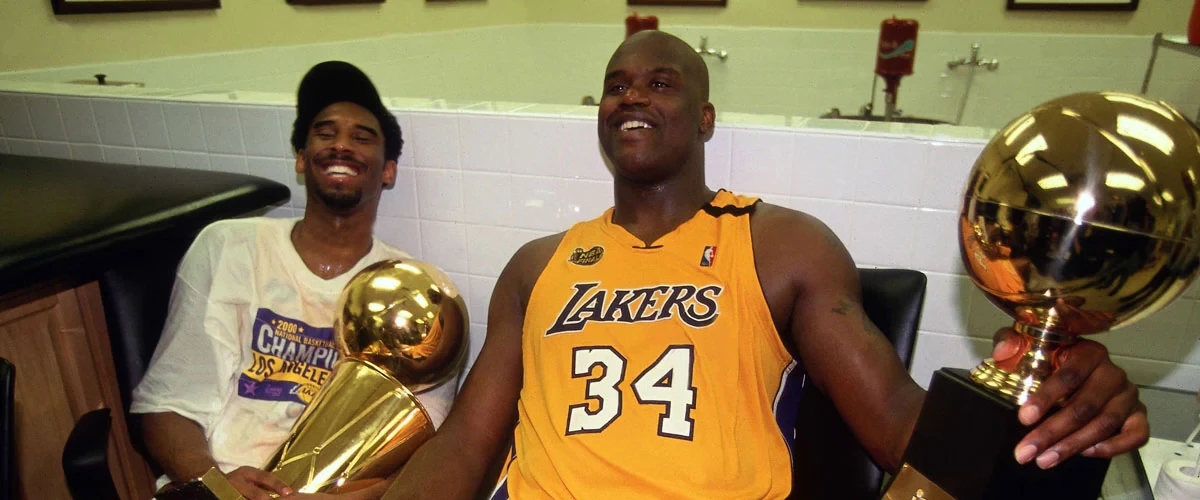
1999-2000
Return to Dominance
The 1999-2000 season was the beginning of a new era in Los Angeles Lakers basketball. The team hired a new head coach in former Chicago Bulls lead man Phil Jackson, and for the first time in 31 years the Lakers would play their home games somewhere other than the Great Western Forum, as the club moved into the brand new 18,997-seat STAPLES Center in Downtown Los Angeles.
Jackson brought with him three new assistant coaches in Jim Cleamons (a former player on the Lakers 1971-72 squad), Frank Hamblen and Tex Winter, and along with holdover Bill Bertka, that quartet would form one of the most experienced assistant coaching teams in the NBA. The team also took on a different look as veterans A.C. Green, Ron Harper, John Salley and Brian Shaw were added to the roster.
Shaquille O'Neal began the season with a vengeance as he earned NBA Player of the Month honors for November after averaging 28.7 points, 13.4 rebounds and 3.36 blocked shots in the first month of the season. O'Neal continued his dominating ways as he earned Player of the Month honors two more times, in February and March, becoming the first player to receive Player of the Month accolades three different times in the same season. O'Neal was also named the MVP of the 2000 All-Star Game played in Oakland and was joined there for the second time by teammate Kobe Bryant.
Not limited to individual efforts, the new coaching staff, the veteran additions, and the returning players all meshed incredibly well as the club got off to a fast start, registering wins in 25 of their first 30 games and reeling off a 16-game winning streak in the first half of the season. The streaks continued as the Lakers also added a 19-game winning streak and an 11-game winning streak to become only the third NBA team to register three different double-figure winning streaks in the same season.
The Lakers stormed though the regular season achieving the best record in the league (67-15) and earning homecourt advantage throughout the playoffs. Though they were heavily favored, the team struggled to get out of the first round, needing five games to defeat the Sacramento Kings. The next round was less difficult as the Lakers knocked off the Phoenix Suns in five games. The Western Conference Finals against the Portland Trail Blazers went to seven games, as the Lakers staged a miraculous comeback. Trailing by 13 points entering the fourth quarter of Game Seven, the Lakers fought back to win the game and the Western Conference Championship. Boosted by their improbable comeback, the Lakers went on to defeat the Indiana Pacers in six games, earning their first NBA Championship since 1988.
O'Neal (First Team) and Bryant (Second Team) were named to the All-NBA teams and both were also named to the NBA's All-Defensive Teams, with Bryant becoming the youngest player to ever receive All-Defensive honors. O'Neal became only the third player to be named Most Valuable Player of the regular season, All-Star Game and the NBA Finals.
Return to top of page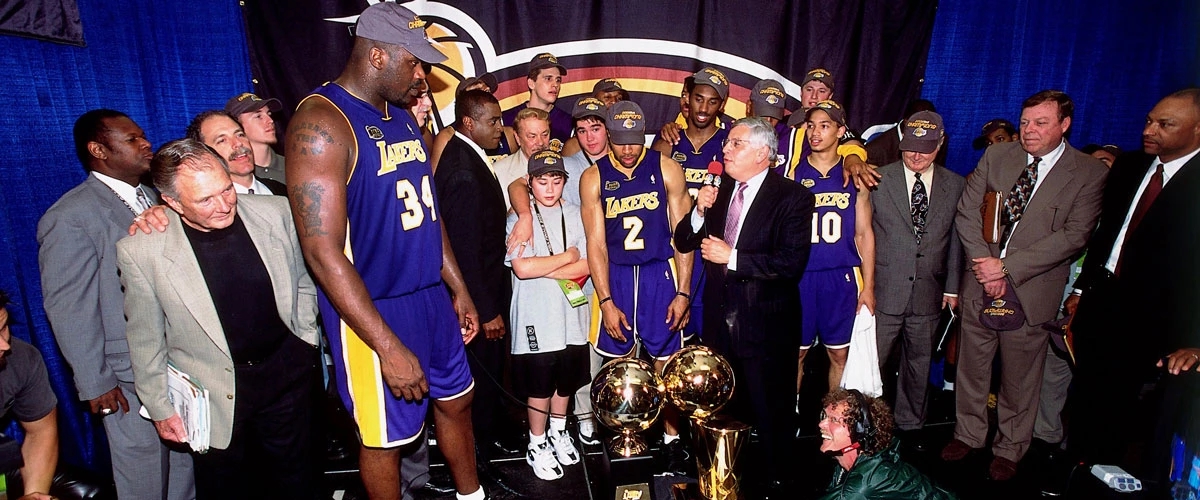
2000-01
Back to Back-to-Back
With a nucleus that included two of the NBA's best players in Shaquille O'Neal and Kobe Bryant and a head coach that has won seven NBA titles in Phil Jackson, the Lakers began the season with aspirations of winning a second consecutive NBA Championship.
After struggling to contain the Western Conference's high scoring power forwards in the playoffs, Los Angeles dealt Glen Rice and Travis Knight to the New York Knicks in a three-way deal involving the Seattle SuperSonics, which netted power forward Horace Grant and center Greg Foster. Having played under Jackson earlier in their careers, both Grant and Foster were skilled in running the Lakers triangle offense, and Grant was to provide a solid defensive and rebounding presence.
Derek Fisher began the season on the injured list after being diagnosed with a stress fracture in his right foot and would miss the first 62 games of the season. The rest of the team also got off to a slow start and was 31-16 at the All-Star break, already picking up one more loss than during the entire 1999-2000 campaign. The Lakers battled through injuries to Fisher, O'Neal and Bryant, but as the club returned to full health, the Lakers began to pick up steam heading into the postseason.
After a 96-88 win over the Utah Jazz at the Delta Center on April 3, the Lakers ran off eight consecutive victories, their longest winning streak of the season, and were able to claim their second consecutive Pacific Division title, edging out the Sacramento Kings in the last week of the season. Los Angeles would not lose another contest until Game 1 of the NBA Finals against the Philadelphia 76ers, sweeping Portland, Sacramento and San Antonio. Philadelphia surprised the Lakers with a 107-101 overtime victory at STAPLES Center, but Los Angeles went on to victories in each of the next four games to claim a second consecutive NBA title.
O'Neal was named Finals MVP after averaging 33.0 points and 15.8 rebounds against Philadelphia and was again a First Team All-NBA selection. Fisher returned from injury to convert 35 three-pointers throughout the playoffs, setting an NBA record with 15 threes in the four-game series against San Antonio. Bryant earned Second Team All-NBA and Second-Team All-Defense honors.
Return to top of page
2001-02
Thrice as Nice
With a third consecutive NBA Championship squarely in their sights, the Los Angeles Lakers opened the 2001-02 regular season much like they ended the 2000-01 campaign, with a flourish. Despite injuries to Derek Fisher (stress fracture; right foot) and Mark Madsen (fractured left wrist and abdominal strain), the team registered victories in their first seven games and 16-of-17 to start the season. The Lakers became only the 11th team to start a season with wins in 16 of their first 17 games and the first since the 1996-97 Chicago Bulls.
Gone from the 2001 Championship team were Ron Harper, Horace Grant, Tyronn Lue and Greg Foster, to be replaced by Lindsey Hunter, Samaki Walker and Mitch Richmond. Led by Richmond, a six-time All-Star, the Lakers acquired three veterans who had combined for 28,040 points and 26 seasons of experience. Those new faces would be relied upon early as Walker was immediately installed into the lineup at power forward and Hunter was counted on to replace Fisher until he recovered from injury.
After their quick start, the Lakers pace slowed as they went 17-12 over their next 19 games and with a mark of 33-13 at the All-Star Break, trailed the Sacramento Kings by 2 ½ games in the Pacific Division standings.
Shaquille O'Neal, who had been battling a foot injury throughout the season, returned from a stint on the injured list shortly after the All-Star break and earned Western Conference Player of the Week honors in two of the first three weeks after his return. He and Kobe Bryant finished third and sixth respectively among league leaders in scoring and propelled the Lakers to a 58-24 regular season mark, second best in the NBA.
The Lakers entered the postseason as the number three seed in the Western Conference and met up with the Portland Trail Blazers for the third consecutive season. Up two games to zero, Robert Horry connected on a three-pointer with 2.1 seconds remaining to give the Lakers a three-game sweep. In the Western Conference Semifinals, Los Angeles defeated the San Antonio Spurs 4-1 to set up a series between the teams with the league's two best regular season records, the Lakers and the Pacific Division Champion Sacramento Kings. In one of the most exciting playoff series in recent memory, the Lakers emerged victorious, 4-3, after a 112-106 overtime victory at ARCO Arena in game seven.
Los Angeles faced the New Jersey Nets in the 2002 NBA Finals and won the series in four games. Averaging 36.3 points and 12.3 rebounds, O'Neal was named NBA Finals MVP for the third consecutive season, joining Michael Jordan as the only players to have accomplished that feat. O'Neal and Bryant were both named First Team All-NBA, becoming the first tandem to receive that honor since Chicago's Jordan and Scottie Pippen in 1996. Phil Jackson earned his ninth NBA Championship as a head coach and surpassed Pat Riley for most playoff wins all-time.
Return to top of page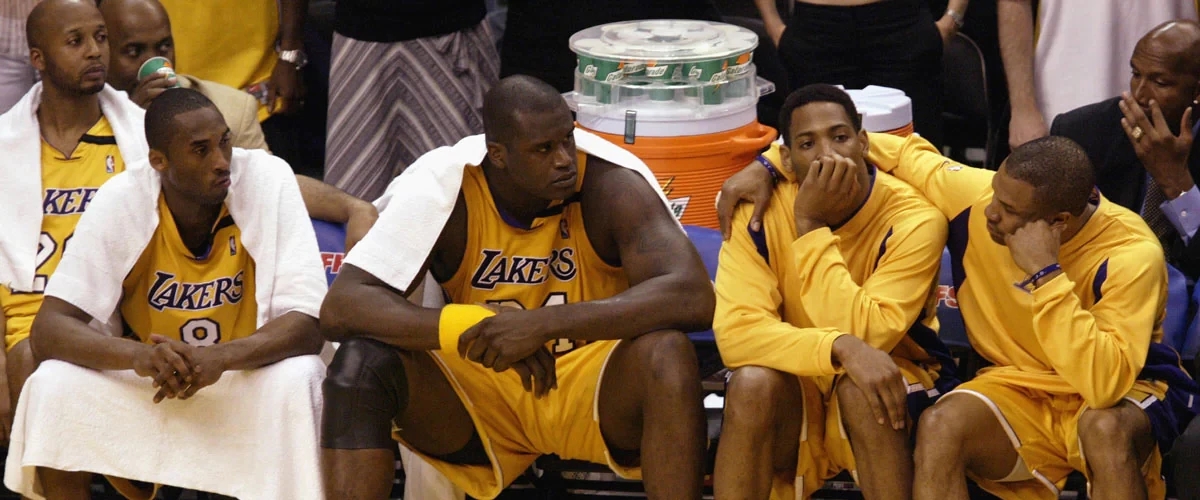
2002-03
In and Out, Heartbrrrrrrreak!
After celebrating back-to-back-to-back NBA championships, there appeared to be no end to the Lakers impressive run of titles. And if a Robert Horry three-pointer from the wing in the final seconds of Game Five of the Western Conference Semifinals had gone in-and-out and back in again, perhaps the run might not have ended, at least this season. Opportunity, for the first time in three years, had passed the champions by.
The Lakers title defense ran into a number of obstacles abnormally early in the season. From Shaquille O'Neal missing the first 12 games due to off-season toe surgery to Mark Madsen straining a hamstring to Rick Fox being suspended for six games after a preseason fight, the new campaign began somewhat precariously for the three-time defending champs. Shorthanded throughout the first half of the season while players were out or just returning to form, Kobe Bryant carried the team early on. Bryant, who entered the season adding fifteen pounds of mass to his frame over the summer, became youngest player in NBA history to reach 10,000 career points. Night in and night out, Bryant seemingly rewrote the record books. He established a new NBA record with 12 three-pointers in a game, tied the NBA record for most three-point field goals in a half with eight 3/28 vs. Washington, established a new franchise record with 42 points in a half 3/28 vs. Washington and tallied an NBA season-high 55 points in the same game, recorded nine consecutive games scoring 40 or more points, the 4th longest streak of its kind in NBA history (Wilt Chamberlain - 14 twice, Chamberlain - 10, Michael Jordan - 9), recorded 13 consecutive games scoring 35 or more points, the fourth longest streak of its kind in NBA history with all three others belonging to Wilt Chamberlain, by averaging 40.6 points in the month of February, became only the third player in NBA history to average 40 or more points in a month and became the first Lakers player since Magic Johnson in 1991 to record triple-doubles in consecutive games. Named Western Conference Player of the Week five times while being named Western Conference Player of the Month for January, Bryant elevated his play in pursuit of a fourth straight championship.
If the team had developed one trademark after three championship runs, it was that of resiliency. Never more apparent was the Lakers never-say-die attitude than when the team came from 27 points down in the fourth quarter to defeat the Dallas Mavericks in a December 6 showdown at STAPLES Center. Yet following a Christmas day defeat that dropped the team to 11-19, the Lakers had never seemed more vulnerable. Robert Horry, however, boldly predicted the Lakers would rise above .500 before the All Star break. True to form, by February 6th, the last game before the break, Los Angeles was 24-23. The Lakers, in fact, posted a 39-13 record after Christmas, the second best record in the league.
While Shaquille O'Neal had rejoined the team towards the end of November, it took time for him to reestablish his position as the most dominant force in the NBA. If January and February belonged to Bryant, March belonged to O'Neal. With the playoffs looming just around the corner and the team back in the hunt, O'Neal began to resemble the dominant force he had been in the previous season's NBA Finals when he garnered his third consecutive NBA Finals MVP award. He averaged 31.6 points, 11.0 rebounds and 2.88 blocks while leading the Lakers to an 11-5 mark in their toughest month of the season, earning Western Conference Player of the Month honors along the way. Although he missed the first 12 games of the season, O'Neal managed to remind the NBA that he was still its most imposing force in the middle. On the way to 2002-03 First Team All-NBA and All-NBA Defensive Second Team selections, O'Neal celebrated major career milestones such as recording his 9,000th career rebound 4/15 vs. Denver and recording his 20,000th career point 3/20 @ Sacramento. In addition, O'Neal made his 10th NBA All Star appearance while Bryant, who also was named First Team All-NBA and garnered an All-NBA Defensive First Team nod, started in the midseason classNameic for the fifth time.
The Lakers concluded their season with a 50-32 record, the team's 26th 50-plus win season since moving to Los Angeles. As a franchise, the Lakers improved to 2671-1648 (.618) all time, the most victories and best winning percentage in NBA history.
After knocking off the Minnesota Timberwolves in a hard fought six game series and splitting the first four games of the Western Conference Semifinals with the Spurs, the Lakers hopes of a fourth straight championship hinged on a pivotal Game Five in San Antonio. Already missing one of their tri-captains in Rick Fox, who had torn a ligament in his left foot during the Minnesota series, and in a game in which San Antonio led by as many as 25 points, the Lakers poise and confidence once again emerged down the stretch. Down 18 in the final period, Los Angeles dug deep and rallied, leaving themselves a two-point deficit with a mere 4.7 ticks left on the clock. The game would come down to a familiar hero in a familiar situation. Following the inbounds pass and with 3.6 seconds remaining in the game, Robert Horry let fly the potential game winning three-pointer. Only this time the Lakers saw the ball go in, then inexplicably rim out. A shot that had always fallen in the past would not this time around. In, and then, out. Playing for the first season since the Lakers moved to Los Angeles without the legendary Chick Hearn as their voice, it was indeed Chick who would have called it best, "In and out, Heartbrrrrrrreak!" This shot seemed to redefine the phrases' very meaning and symbolically sealed the Lakers fate. The Lakers lost the Western Conference Semifinals in six games as the San Antonio Spurs advanced and went on to claim their second NBA title.
Return to top of page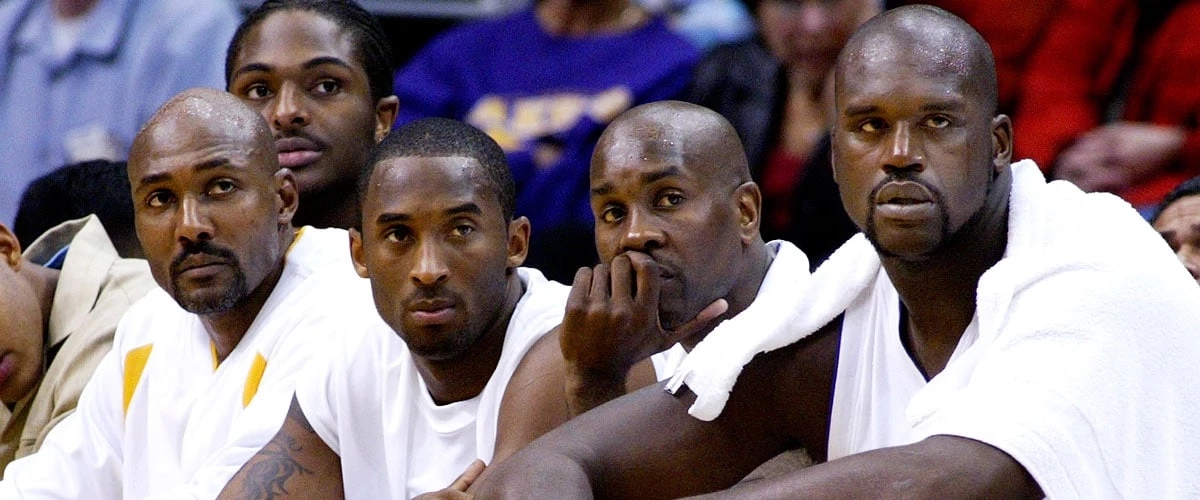
2003-04
A season unlike any other
Purchasing the Los Angeles Lakers franchise in 1979, last season marked the 25th year of Dr. Jerry Buss' ownership of the Los Angeles Lakers, a season falling just three wins shy of the perfect anniversary gift. Losing in five games to the Detroit Pistons in the NBA Finals, the 2003-04 Lakers enjoyed their share of spectacular highlights despite battling both injury and the treacherous Western Conference night in and night out.
Teaming future Hall-of-Famers Gary Payton and Karl Malone along with perennial All-Stars Shaquille O'Neal and Kobe Bryant gave the Lakers one of the most decorated starting line-ups in league history. Starting the regular season as winners of 20 of their first 25 games, Los Angeles entered a December 21st meeting with the Phoenix Suns as the most dangerous team in basketball. The Lakers defeated the Suns that night but lost Karl Malone to a sprained right knee, an injury that would keep him out of the next 39 games. The Lakers could not rid themselves of the injury bug as players seemed to fall nightly over the next few months of the NBA schedule.
Prior to his injury, Karl Malone notched his name in history once again by surpassing Robert Parish for 6th all-time in career rebounds November 19th against the Knicks. In addition, he became the oldest player (only player over the age of 40), to register a triple-double in a regular season game November 28th against the Spurs at STAPLES Center. With Malone sidelined, the Lakers were never quite the same but maintained their course, making easy prey of the Atlanta Hawks by defeating the visitors 116-67 in front of the hometown faithful. The Lakers' 46-point victory tied for the fifth largest margin of victory in franchise history as the golden clad Lakers held the Hawks to franchise lows for points in a first quarter (7) and half (28).
Entering the All-Star break with a 31-19 record, the Lakers sent two representatives to the midseason classNameic held at STAPLES Center while the rest of the team finally had a chance to catch its collective breath before embarking on the home stretch of the season. Kobe Bryant, voted as a Western Conference starter for the sixth-consecutive time, represented the Lakers well by scoring 20 points on 9-of-12 shooting from the floor to lead all starters. Shaquille O'Neal, entering the game as a reserve, proved to be the most dominating player, tallying 24 points and 11 rebounds while earning his second All-Star MVP award in front of the hometown crowd at STAPLES Center.
Following the All-Star break, the Lakers entered the second half of the season poised to regain their championship luster of prior years, winning seven of their first eight games after the layoff. During that stretch, Kobe Bryant recorded his ninth career triple-double with 25 points, 14 rebounds and 10 assists in a 122-110 win over the Washington Wizards.
The Lakers entered the playoffs as winners in 14 of their final 17 regular season games and with a great deal of momentum thanks in large part to the heroics of Kobe Bryant on April 14th in Portland. Behind a pair of Bryant buzzer-beating three-pointers, the first to send it to overtime and the second for the win in double-overtime, the Lakers clinched their 18th Pacific Division Championship with a 105-104 victory over the Trailblazers, finishing the season with a record of 56-26.
After recording their 27th 50-win season in Los Angeles, the Lakers defeated the Houston Rockets (4-1), San Antonio Spurs (4-2), and Minnesota Timberwolves (4-2) before falling to the Detroit Pistons in the NBA Finals. Although falling three games shy of their ultimate goal, this team for the ages left us with the memory of Karl Malone and a torn jersey in Houston, of Kobe Bryant posting 42 points against San Antonio after arriving at the arena late and of 0.4 seconds and Derek Fisher answering Tim Duncan's improbable buzzer beater with one of his own. While the ending was indeed disappointing, the ride was one basketball fans will remember for years to come.
Return to top of page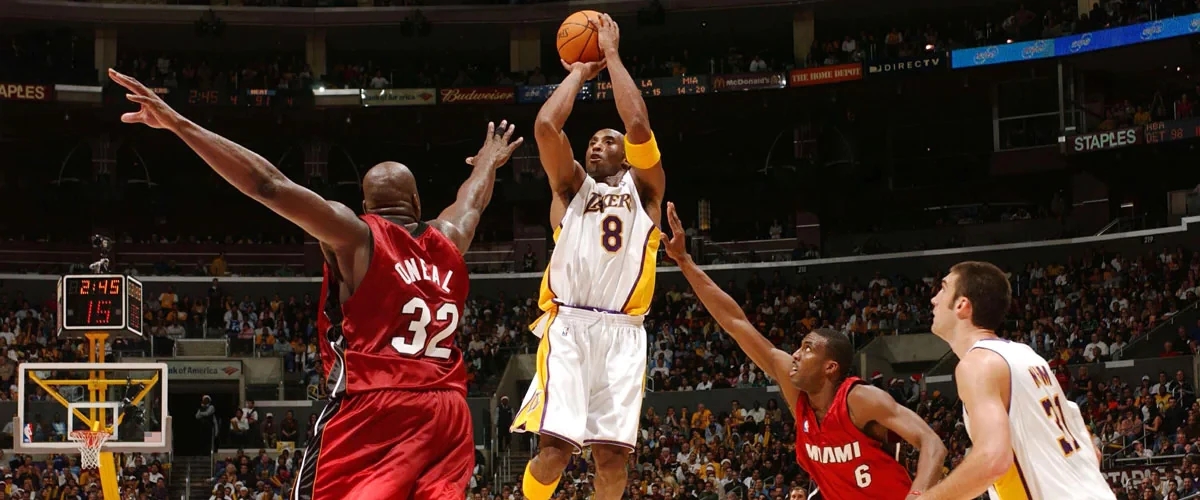
2004-05
Ch...Ch...Ch...Changes
With a new coaching staff headed by two-time NBA Champion Rudy Tomjanovich and a starting line-up returning only one player from last season's Western Conference Championship team, the 2004-05 Lakers figured to be a work in progress. The team had new faces such as Lamar Odom, a starter on the 2004 U.S. Men's Olympic basketball team, and Caron Butler, a 2002-03 All-Rookie First Team selection, mixed with the veteran leadership of Vlade Divac returning home to where he began his career. Early on, however, an ominous tone was set when Divac, penciled in as a starter before training camp, was lost due to a herniated disc in his back that would ultimately keep him out for a majority of the season. Nonetheless, the Lakers opened the year with a convincing 89-78 victory over the upstart Denver Nuggets before a sell-out crowd at STAPLES Center on November 2. While unable to put together a three-game win streak throughout the opening two months, Los Angeles still built a 15-12 record at the turn of the calendar. Of their 12 losses before January 1, five came by five or fewer points.
One of those games included the most anticipated regular season basketball game in recent NBA history, matching the Miami Heat and former Laker Shaquille O'Neal against the Lakers and Kobe Bryant on Christmas day. In a game that lived up to its billing, Bryant scored a game-high 42 points while O'Neal posted a double-double (24 points, 11 rebounds) in their first ever meeting. Los Angeles, however, couldn't hold a seven-point fourth quarter lead and lost in overtime 102-104.
Despite the close losses and losing Bryant for a month to injury after suffering a severely sprained right ankle against Cleveland on January 13, the Lakers continued to improve and moved to six games above .500 (22-16) by January 21. Los Angeles closed out January and opened February with consecutive victories before the season would take a dramatic shift.
On February 2, Tomjanovich stepped down from his head coaching post due to health reasons, leaving long-time Lakers' assistant coach Frank Hamblen to man the ship as Los Angeles entered the toughest part of their schedule. Exactly one month after injuring his ankle, Bryant returned to the Lakers' lineup February 13 at Cleveland. While dropping his first game back to the Cavs, the Lakers rebounded by winning their last game before the All-Star break, to which Bryant was selected a Western Conference starter, and reeled off their first three-game win streak of the season with two wins immediately following the break, improving to 28-24.
The team continued to see-saw, however, dropping their next four games following its three-game surge. Fittingly enough, Los Angeles then won four of its next five including back-to-back road victories at Dallas and Charlotte. In the game against Dallas, Bryant saw his franchise record streak of 43 consecutive free throws made come to an end, surpassing the previous mark of 40 held by Hall-of-Famer Gail Goodrich. With four games in the next five nights, Los Angeles dropped each of them, falling below .500 for the first time since they were 1-2 on November 5. In the process, the Lakers lost their leading rebounder and second leading scorer when Lamar Odom suffered a strained left shoulder March 18 against Indiana, an injury that would sideline him for the remainder of the season. The Lakers continued to slide, ultimately dropping eight consecutive games, the second longest streak in franchise history. In the process, Los Angeles dropped nine straight road games, tying the 2003-04 Lakers mark for second longest streak in franchise history.
Despite the Lakers struggles down the stretch, third-year forward Caron Butler was a bright spot, averaging 22.8 points for the month of April to go along with 7.6 rebounds and 2.22 steals. In addition, as a team, the Lakers established new franchise records for both three-point field goals made (644) and three-point field goals attempted (1813). Also, entering the year, no Lakers' team had shot 100 percent from the foul line since the 1991-92 season when the team converted 27-of-27 from the charity stripe in a January game against Denver. In their March 8, 2005 contest with the Clippers, the Lakers converted 23-of-23 free throws, marking the second time during the season that the Lakers shot 100 percent from the foul line. Earlier in the year, the Lakers converted 20-of-20 free-throws in an 89-87 road victory over the Clippers December 11.
Entering the Lakers regular season finale needing just three points to become the 115th player in NBA history to amass 14,000 points, Kobe Bryant scored 37 points against the Portland Trail Blazers to bring his career total to 14,034 at the end of his ninth NBA season. Already the youngest player in league history to reach 10,000 points, Bryant surpassed Michael Jordan as the youngest player to reach the 14,000 point benchmark.
While playing just 46 games (23-23) with their opening night starting lineup of Chris Mihm, Odom, Butler, Bryant and Chucky Atkins, the Lakers season culminated in April with the team missing the playoffs for the first time since the 1993-94 season.
Return to top of page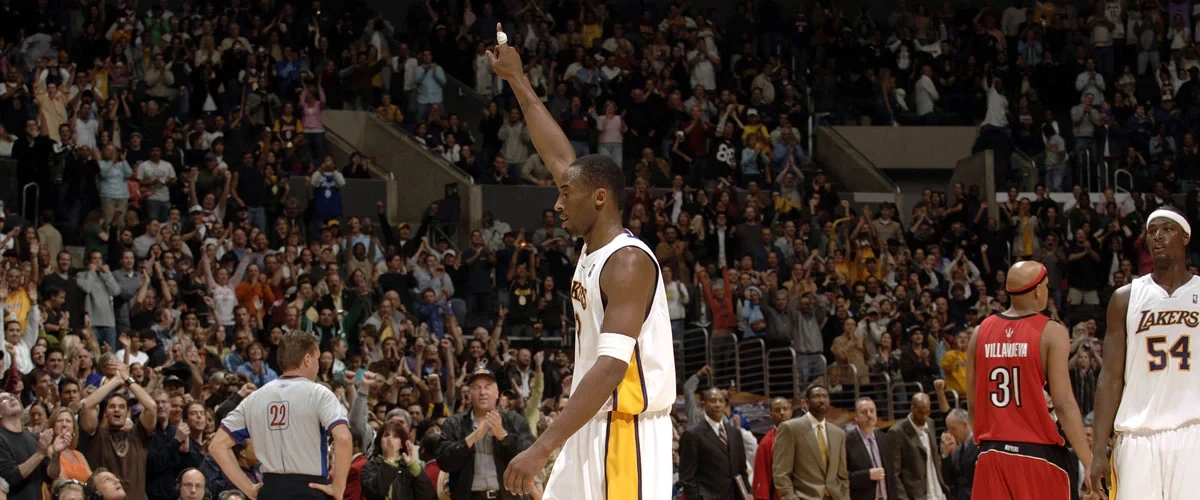
2005-06
Jackson and Playoffs Return to Los Angeles while 81 Becomes a Household Number
The 2005-06 season saw the return of Phil Jackson - and with him, the return of the Lakers' winning tradition. Following six seasons, four NBA Finals appearances and three consecutive championships, Phil Jackson took one year away from the team before signing on once again to coach the league's most storied franchise.
A Jackson return meant a reunion with Kobe Bryant, two of the key components from the Lakers 2000, 2001 and 2002 Championship seasons. And despite the return, as well as significant off-season moves by the franchise, fans and media alike remained skeptical as to whether the Lakers would even challenge for a spot in the postseason. After missing the playoffs in 2004-05, the Lakers used their first lottery pick since 1994 to select high- school center Andrew Bynum, the youngest player ever selected in the history of the draft. In addition, the Lakers brought back a familiar face from the Showtime era in Kareem Abdul-Jabbar to mentor the newly acquired Bynum at center. Los Angeles acquired forward Kwame Brown from the Washington Wizards via trade and signed free-agent Smush Parker to help add depth in both the front court and at guard.
Combined with a few new faces and influx of young talent, the franchise was poised for a new start. United once again, Jackson and a rejuvenated Bryant wasted no time in getting the Lakers back to their traditional winning ways. The Lakers emerged victorious in their season opener at Denver with a 99-97 overtime thriller in which Bryant connected on the game-winner with 0.6 seconds remaining in the extra period. Although the team's first extensive road-trip in November proved to be treacherous for the team as they experienced their first three-game losing streak of the season, the Lakers opened eyes around the league by going 5-1 on a six-game trip in early December which included wins at Chicago and Dallas.
While the team's youth led to inconsistency early on, it was clear that Bryant would need to shoulder more of a scoring burden in the early going. On December 20th at STAPLES Center, Bryant displayed just how up to the task he was at the expense of the Dallas Mavericks as he single handedly outscored the entire Mavericks squad 62-61 through three quarters. Bryant's 30-point third established a new franchise record for points in a quarter while tying for the fourth best period in NBA history as the Lakers went on to lead by as many as 35 in the contest as Bryant sat out the entire fourth period.
Despite a four-game losing streak in late December that seeped into early January, the Lakers bounced back January 6 at home against the Philadelphia 76ers when Bryant and Smush Parker combined for 12-of-12 shooting from 3-point territory as Los Angeles won easily 119-93. In the victory, Bryant established a new franchise record for 3-pointers made without a miss, connecting on all seven of his attempts. Parker made all five of his attempts, marking the first time since the introduction of the 3-point shot in 1979 that two teammates have been perfect from behind the arc with a minimum of five attempts each.
Scoring 40 of his game-high 50 points in the second half the following night on the road against the Clippers, Bryant helped the Lakers overcome a 13-point third quarter deficit to win 112-109. Two days later, on January 9, Bryant became the first player since Wilt Chamberlain in November of 1964 to record four consecutive games scoring 45-plus points. His 45-point, 10-rebound, five-assist performance propelled the Lakers to a 96-90 win over the visiting Indiana Pacers as they moved two games above .500 at 18-16.
Later in the month, the Lakers avenged a disappointing Christmas Day loss to the Miami Heat with a 100-92 victory at STAPLES Center on Martin Luther King Day. Bryant led all scorers with 37 points while Lamar Odom narrowly missed a triple-double with 19 points, 10 rebounds and 9 assists in the victory.
Following a disappointing road loss to the Sacramento Kings in which the Lakers surrendered a five-point lead with 35.5 seconds remaining in regulation and a one-sided defeat to the Suns in Phoenix a night later, Los Angeles aimed to end their skid in a January 22 contest against the visiting Toronto Raptors. The Lakers once again opened the game sluggishly, falling behind by as many as 18 points beginning the third. From that point, however, the rest, as they say, is history. In one of the greatest performances in NBA history, Bryant took control of the game, scoring 55 points in the second half alone and amassing a staggering 81 points on the night to carry the Lakers to a 122-104 victory. Bryant's totals for points in a half and game became the second highest totals in NBA history, bettered only by Wilt Chamberlain's 100-point game (59-point half) back in March of 1962.
Bryant's milestone season, however, was only beginning to gather steam. Entering the team's March 3 match-up at Golden State, Bryant needed just 10 points to become the youngest player in NBA history to reach 16,000 career points. Bryant more than reached the mark as his 42 points propelled the team to a 106-94 victory over the Warriors. Nearly one month later on April 2, Bryant tied Elgin Baylor's Lakers franchise record with his 23rd 40-plus point game of the year - leading his squad to a104-88 victory over Houston. Just four days later at Denver, Bryant surpassed the Baylor mark with his 24th 40-point game of the season, but the Lakers would fall to the Nuggets in a 108-110 overtime thriller. Bryant once again took aim at another Lakers' record prior to their April 14 contest versus Portland. Needing 16 points to surpass Baylor's franchise record of 2,719 points established more than four decades earlier during the 1962-63 season, Bryant erupted for 50 points en route to a 110-99 victory.
To top off a magical regular season highlighted by brilliant individual performances and an end of the season playoff push, Bryant helped lead the Lakers to their fifth straight victory and 11th win in their final 14 games with a 115-95 victory over the New Orleans/Oklahoma City Hornets. In the process, Bryant scored 35 points to finish the season with 2,832 points - the 7th greatest scoring season of all-time and 8th greatest scoring average (35.4 points) in league history. With the win, the Lakers finished with the sixth best record in the Western Conference and secured a seventh seed in the Western Conference Playoffs.
Facing the heavily favored Suns in the First Round, the Lakers dropped Game 1 at Phoenix 102-107 but came away encouraged that they could indeed get a desired split on the road. Los Angeles controlled the tempo from the outset of Game 2 and behind Bryant's 29 points, 10 rebounds and five assists and Lamar Odom's 21 points, seven rebounds and five assists, the Lakers evened the series at one game apiece with a 99-93 victory heading back to STAPLES Center.
After winning Game 3 99-92 to take a 2-1 series lead, the Lakers looked to take a commanding 3-1 advantage entering Game 4. Despite playing just 10 first-half minutes due to foul trouble, Kobe Bryant came up big late in one of the most memorable playoff games in Lakers history, connecting on a game-tying driving lay-up with 0.7 seconds to force overtime after Smush Parker stole the ball from Steve Nash along the sideline, leading to the break and lay-up. In the overtime period, Luke Walton tied up Nash to force a jump ball with Los Angeles down one with just a few seconds remaining. The tip went in the Lakers' direction and into Bryant's hands. With the clock winding down, Bryant took the ball up court and fading away from the right elbow, knocked down the jumper to secure a miraculous 99-98 victory, giving the Lakers a 3-1 series lead.
After dropping Game 5 in Phoenix, the Lakers returned home looking to close out the series. With Bryant scoring the team's final five points of regulation to put Los Angeles up three with 29.3 seconds remaining, Tim Thomas connected on a game-tying three-pointer off of an offensive rebound with 6.3 seconds, ultimately sending the contest into an overtime in which the Suns scored 21 points to force a Game 7 with a 126-118 victory. Having been just seconds from the Western Conference Semifinals, a seemingly stunned Lakers team succumbed to the Suns momentum in the deciding Game 7 at Phoenix and were eliminated from the postseason with a 90-121 loss at US Airways Center.
Despite a disappointing end to the season, the return of Jackson coupled with the historic brilliance of Kobe Bryant and a memorable playoff series against Phoenix made for one of the more memorable Lakers seasons of all-time while providing new-found momentum for future success to come.
Return to top of page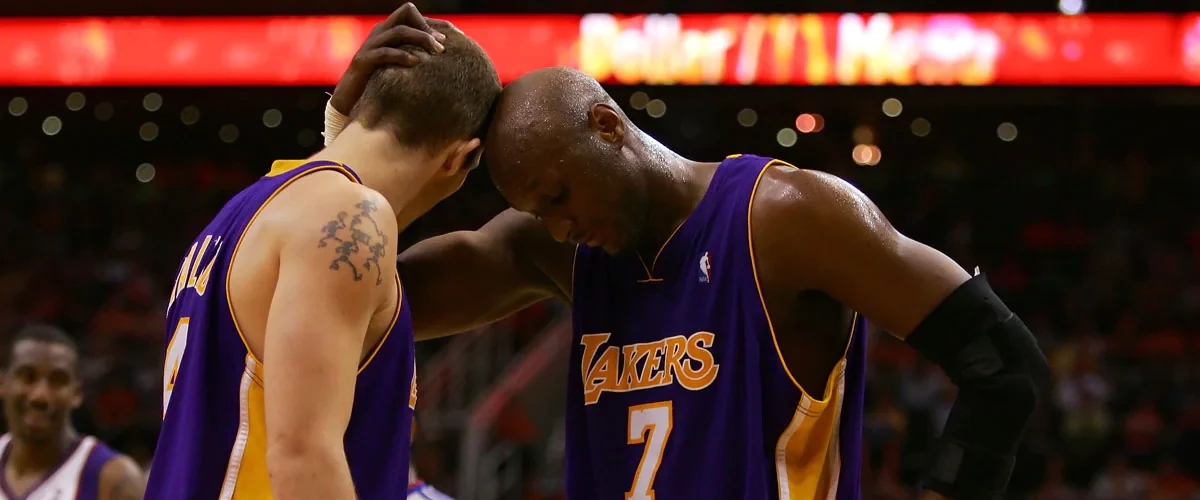
2006-07
Another Playoff Loss to Phoenix
Only five times in the 62-year history of the Lakers had the team not made the playoffs, with the 2004-05 season - with Phil Jackson taking what he now calls a "sabbatical" standing out as the only blemish since 1993-94.
But Jackson returned the following season, leading the Lakers back to the playoffs in a deep Western Conference despite a roster short on elite players, ultimately losing a tough First Round matchup with the Phoenix Suns. Kobe Bryant put forth one of the greatest scoring seasons in league history, averaging 35.4 points, and returned in 2006-07 no less determined to win despite a team still lacking experienced, talented players.
Bryant actually began the season on the bench, taking two games to further recover from an offseason knee injury before returning to steadily get back into form, but then scoring 52 points in the final game of November to help the Lakers open the season at 9-5. Lamar Odom, L.A.'s only other elite player, posted 34 points, 13 rebounds and six assists in the season opener and was a consistent producer until he spraining his knee in mid-December. The injury would keep Odom out for 21 games, of which the Lakers would win 12 largely due to Bryant carrying a heavy load, starting alongside an inexperienced group including Luke Walton, Brian Cook, Kwame Brown and Smush Parker.
Odom finally returned on Jan. 26, but the Lakers would go only 7-17 in their next 24 games, suffering respective losing streaks of six and seven games as frustrations grew. On the heels of that second losing streak (Mar. 2 - 15), Bryant went on an absurd scoring tear, reeling off consecutive games of 65, 50, 60 and 50 points (becoming the 2nd player in NBA history to do so alongside Wilt Chamberlain) in wins over Portland, Minnesota, Memphis and New Orleans. It was enough to steer the Lakers back on a winning course, allowing for the seven best record in the West and 12th best in the league to pit themselves back into the playoffs, again against the 2nd-seeded Phoenix Suns.
Maurice Evans, Andrew Bynum, Ronny Turiaf, Jordan Farmar, Sasha Vujacic and Vladimir Radmanovic found ways to contribute off the bench here and there, but it was Bryant upon whom the burden of winning rested.
Kobe did manage to deliver one playoff victory to L.A. with a 45-point performance in Game 3, but Steve Nash, Amare Stoudemire and Co. were too much for the Lakers, earning a 4-1 First Round victory to end the purple and gold run.
For the season, ultimately impressive considering the lack of talent on Jackson's roster, Bryant was named First Team All-NBA, to the NBA All-Defensive First Team and MVP of the All-Star game, while Bynum became the youngest Laker to record a double-double a season before he'd begin to make a much larger impact. Bryant and Odom were about to receive quite a bit more help.
Return to top of page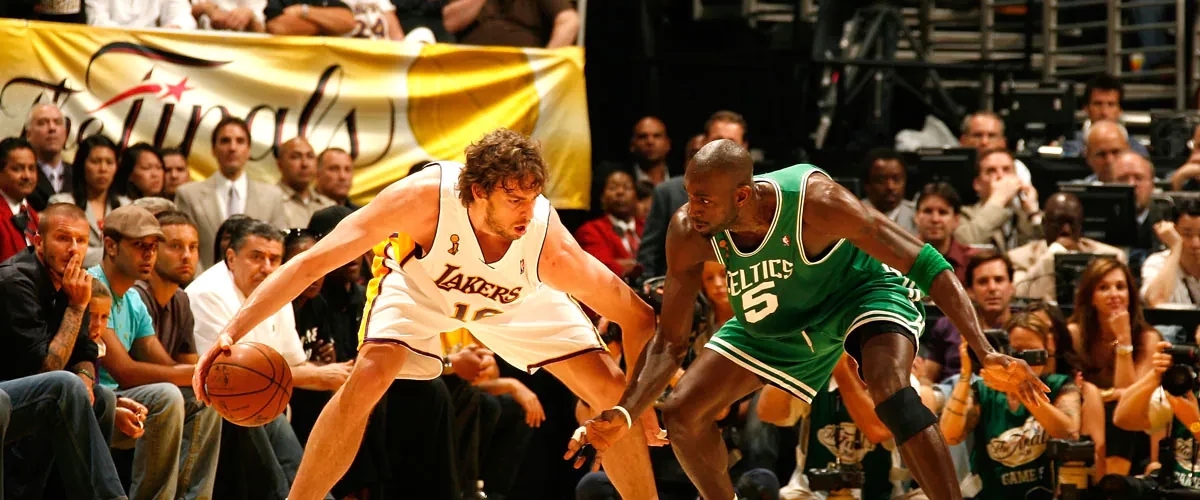
2007-08
The Addition of a Spaniard Sends Lakers Back to Finals
A fascinating year in Los Angeles began in the offseason, when Kobe Bryant, pining for more talent on the roster, went as far as to request that he be traded before returning his focus to the Lakers and opening the season with a 45-point performance in a last-second loss to Houston.
Derek Fisher had come back to the Lakers after two years in Golden State and one in Utah, joining Bryant, Lamar Odom, Andrew Bynum, Vladimir Radmanovic, Luke Walton, Jordan Farmar and Ronny Turiaf in L.A.'s rotation ... at least to start the season.
After an average November (9-7) impacted by Lamar Odom's comeback from offseason shoulder surgery, the Lakers went 10-4 in December before reeling off six straight victories in January to bring their record to 25-11. Bynum, who'd entered the starting line-up after 10 games and announced himself nationally with a 28-point, 12-rebound performance in a Christmas day win over Phoenix, averaged 19 points and 12.8 rebounds in January before suffering what turned out to be a season-ending knee injury against Memphis on Jan. 13. The Lakers had amassed the league's best record at that point, but had also suffered a significant injury to Trevor Ariza, whom they'd acquired in late November from Orlando.
Stung by the injury bug, L.A. finished the month at 3-5 before GM Mitch Kupchak pulled off a masterful move in acquiring 7-foot center Pau Gasol from the Memphis Grizzlies, a trade that immediately changed the fortunes of both the Lakers and the NBA. Gasol's skill set couldn't have fit better into Phil Jackson's triangle offense, and he proved himself capable playing slightly out of position on defense at center as well as L.A. finished the season 22-5 when the Spaniard played (going 5-4 when he sat with an ankle injury). Included in that stretch was an 11-game winning streak just after Gasol joined the team, and a 7-1 spurt to finish the season that vaulted L.A. into the top spot in the Western Conference.
The wave of good play continued into the playoffs as L.A. swept Denver 4-0 in Round 1 and outlasted a tough Utah team 4-2 in Round 2. Then came the defending champion San Antonio Spurs in the Western Finals, whom the Lakers handled in five games thanks in part to Bryant's 39-point performance in the clincher and fantastic play up front from both Gasol and Odom.
But the dream finally ended in the NBA Finals against the hated Boston Celtics, who won Games 1 and 2 and rallied from a 24-point deficit in Game 4 to put L.A. in a 3-1 hole, ultimately winning Game 6 back in Beantown in blowout fashion to secure the title.
Bryant averaged 30.1 points, 5.7 assists and 5.6 rebounds in the playoffs, Gasol was good for 16.9 points, 9.3 rebounds, 4.0 assists and 1.9 blocks while Odom averaged 14.3 points and 10.0 rebounds.
As disappointing as the end result was, 2007-08 was a terrific if unexpected year for the Lakers, who would enter 2008-09 full of expectation, optimism and revenge on the mind, armed with Bryant, Gasol, Odom and Fisher, not to mention the return of a healthy Andrew Bynum and Trevor Ariza.
Return to top of page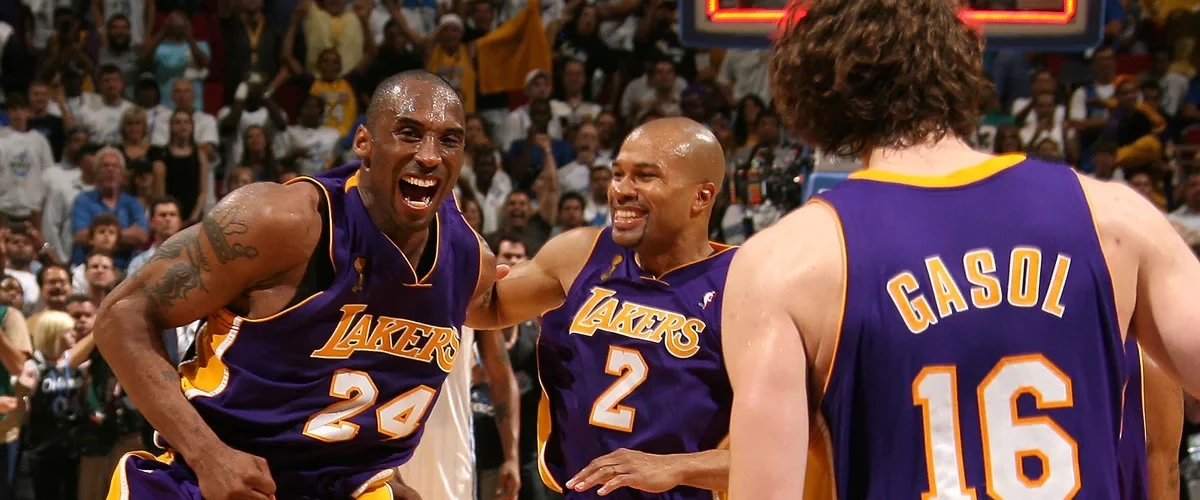
2008-09
The Larry O'Brien Trophy Returns to Los Angeles
In Los Angeles, winning championships is always the goal. Period. But for the first time since 2003-04, the Lakers entered the season with a team that knew it was more than capable of winning the whole thing.
With the combination of elite talent featuring Kobe Bryant, Pau Gasol, Lamar Odom and Andrew Bynum and the mental motivation circulating amongst the team from L.A.'s 131-92 Game 6 loss to Boston in the previous season's Finals, the Lakers were a team operating with a single goal.
The season opened with that premise in mind, as the team won its first seven games, went 14-1 in November, beat Boston by nine on Christmas Day and carried a 42-10 record into the All-Star break, establishing a wide lead in the Western Conference. Yet for the second straight January, L.A. got some bad news when Andrew Bynum went down with another knee injury, once again against Memphis, though the 7-footer did return with four games left in the regular season and played throughout the playoff run.
Bryant had scored 48 points in the game after Bynum went down in the previous season, and this time went off for 61 points in a remarkable performance at Madison Square Garden on Feb 2. Then - with some notable help from Gasol and Odom - Bryant led the Lakers to key wins at Boston and Cleveland as L.A. established its supremacy on the road. The Lakers concluded the season by going 7-1 in April to run away with the top seed, rolling into the playoffs for a First Round matchup with Utah.
The Jazz managed to win only Game 3 as L.A. advanced with a 4-1 series win, but the plucky Ron-Artest-led Houston Rockets forced the Lakers to seven games, L.A. winning Game 5 by 40 and Game 7 by 19 to set up a Western Finals matchup with Denver. The Nuggets stole Game 2 with a 106-103 win at STAPLES Center, but Bryant scored 41 points to help L.A. regain home court advantage with a 103-97 Game 3 win. The Lakers dropped Game 4, but won Game 5 by nine at home before closing the series out with a dominant 119-92 Game 6 win in Denver, highlighted by Bryant's 35-point, 10-assist gem.
Awaiting the Lakers in the NBA Finals were the Orlando Magic, whom L.A. disposed of in Games 1 and 2 before the Magic struck back in Game 3 with a 108-104 victory. Then came the tipping point of the series, when Orlando held a five-point lead in the final minute of Game 4, but fell victim to a huge crunch-time performance from Derek Fisher that featured two dagger three-pointers, the first tying the game to force OT and the second putting the game away. Then came L.A.'s championship-winning Game 5 performance, a 99-86 victory that produced the 15th title in franchise history.
Bryant took home Finals MVP honors for the first time, on the strength of 32.4 points, 7.4 assists and 5.6 rebounds per game, while Gasol, Odom, Fisher, Bynum as well as Trevor Ariza, Jordan Farmar, Shannon Brown and Luke Walton all offered a hand in a true team effort.
With that, the goal was achieved: the Lakers were champions again.
Return to top of page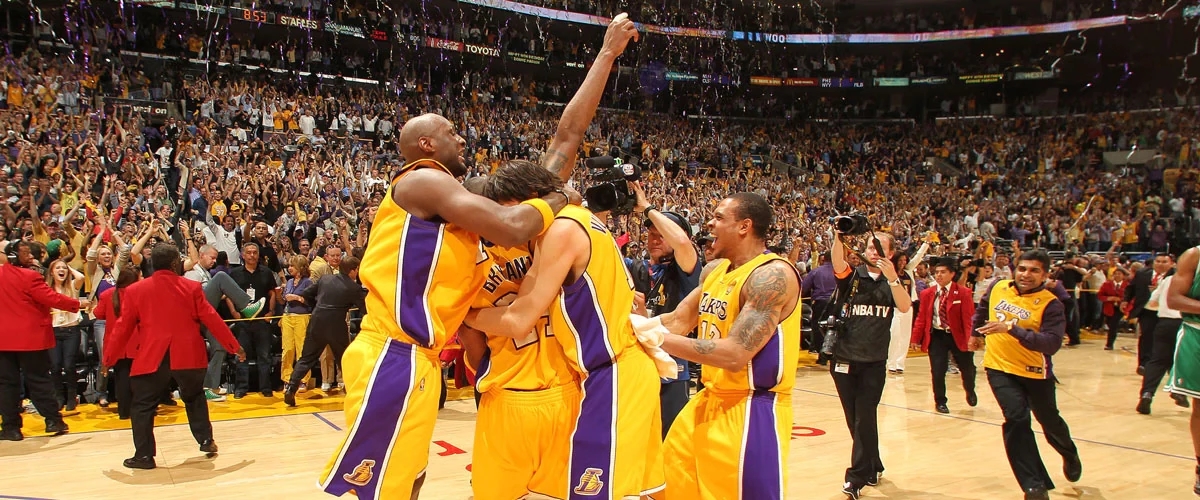
2009-10
Back-to-Back
As had already happened 15 times in franchise history, the Lakers entered an NBA season as the champions of basketball, returning all but one player from the 2008-09 title-winning squad with the solitary goal of defending their throne.
The lone roster move saw Trevor Ariza go to Houston and Ron Artest - still arguably the league's top on-ball defender - join Derek Fisher, Kobe Bryant, Pau Gasol and Andrew Bynum in the starting line up.
Riding their superior size and Kobe Bryant's superior skill, the Lakers overcame an early hamstring injury to Gasol to open the season 23-4, 11 of those wins coming in consecutive fashion when the Spaniard returned. The Lakers headed into the All-Star break at 41-13, comfortably atop the Western Conference, with Bryant and Gasol representing the team in Dallas.
It wasn't all rosy as the regular season continued, however. Bryant was still battling an avulsion fracture to the index finger of his shooting hand that he'd suffered in December, in addition to tweaks to his ankle and knee, while Bynum suffered a late season Achilles strain, injuries which kept the two out for a combined 25 games (17 for Bynum). That contributed to the team winning just four of its final 11 games to finish at 57-25, a mark still good for the No. 1 seed in the West and No. 3 overall behind Cleveland and Orlando.
But thanks in no small part to the experience of Phil Jackson, the Lakers never lost their confidence, which was soon exhibited in the postseason. Two straight road losses allowed Oklahoma City to tie L.A.'s first round series at two, but the defeats seemed to wake up the Purple and Gold, who promptly ran off 10 straight postseason wins to beat the Thunder 4-2 (winning the series on Gasol's last-second put-back layup), sweep the Jazz 4-0 and go up 2-0 on the Suns in the Western Finals. While Phoenix battled back to win two games at home, Artest tipped in Bryant's last-second miss to give L.A. a Game 5 victory, and Kobe offered up a motley crew of deadly shots in Game 6 to send the Lakers to the Finals for the third straight season.
With their return to the big stage came a chance to avenge the team's painful 2008 Finals loss to the Boston Celtics, and thought it took seven hard fought games, L.A. ultimately emerged with an 83-79 Game 7 victory that saw purple and gold streamers rain down from the STAPLES Center rooftop.
The Lakers opened the Finals with an impressive 102-89 Game 1 win, but fell 103-94 in Game 2 when Boston's Ray Allen hit seven first half three-pointers. Home court advantage was quickly regained, however, with a critical 91-84 victory in Game 3 at Boston thanks largely to Fisher's 11-point fourth quarter. Boston battled back to narrowly win Games 4 and 5 in Boston, before the Lakers pounded the Celtics with a terrific 89-67 Game 6 effort, until finally overcoming a 13-point third quarter deficit in Game 7, capped by late three-pointers from Fisher and Artest and the all-around play of Gasol and Bryant.
Bryant concluded the playoffs with averages of 29.2 points, 6.0 rebounds and 5.5 assists, while Gasol added 19.6 points, 11.1 rebounds and 2.09 blocks of his own, while the contributions of Artest, Fisher and Bynum - who gamely played through a meniscus tear that would need postseason surgery - plus Lamar Odom, Jordan Farmar, Shannon Brown and Sasha Vujacic off the bench all proved critical at various points of the playoffs.
Finals MVP for the second straight season, Bryant had scored at least 30 points 12 times throughout the playoff run, while Phil Jackson had won his 11th championship as a coach and the Lakers were champions of basketball for the 16th time.
Visit Lakers Back to Back Champions Page
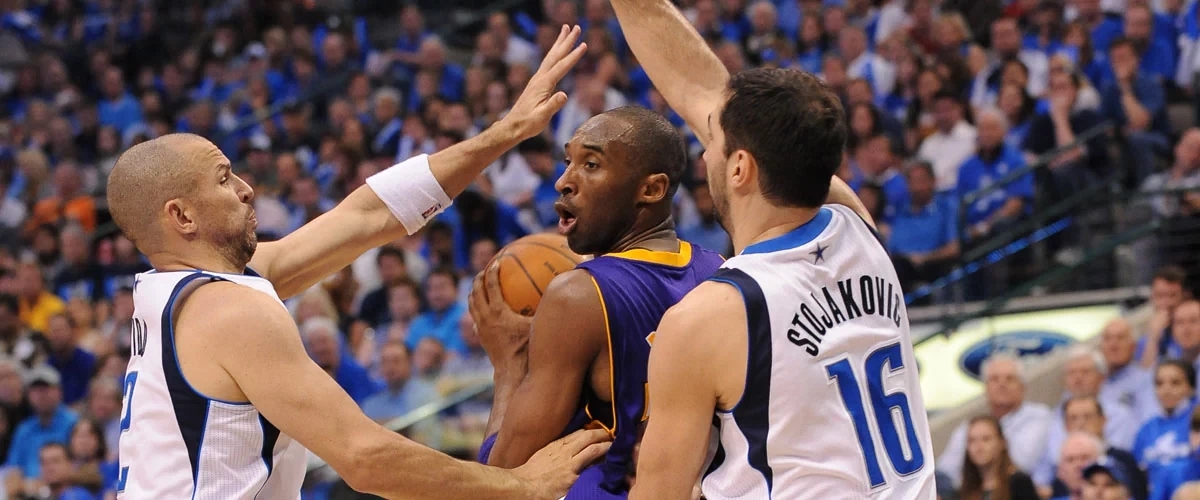
2010-11
Lakers Season Review
When the Lakers raised the 2010 NBA trophy after defeating Boston in seven games, it wasn't long before visions of a potential three-peat took hold.
Even though no team had made it to four straight Finals since Magic Johnson's Lakers (1982-85) and Larry Bird's Celtics (1984-87), L.A. was returning its unmatched size alongside Kobe Bryant, thinking the 2011 trophy was theirs to lose. And the greatest coach of all-time, Phil Jackson, already owning a ridiculous three three-peats and more rings than he could wear on his fingers, was coming back to boot.
"After a couple weeks of deliberation, it is time to get back to the challenge of putting together a team that can defend its title in the 2010-11 season,"said Jacksonwhen announcing his return in July. "It'll be the last stand for me, and I hope a grand one."
But there was a bit of knowing hesitancy even then for Jackson, who recognized the minefield his players would have to navigate.
"It's an impossible task,"he said before training camp. "You just go about it and don't think about how difficult it is, and play each game and don't worry about anything but that. It takes remarkable talent to be able to do it."
The talent was certainly there for L.A., who managed to win 57 regular season games for the second consecutive year. Bryant and Gasol were again named to the All-Star team, Lamar Odom had his best season as a Laker (as shown with Sixth Man of the Year honors), Bynum dominated on defense and the glass for the first extended period of his career, Derek Fisher was steady as ever while steering the ship, Ron Artest remained among the league's very best perimeter defenders and the "Killah Bee's" bench trio of Matt Barnes, Steve Blake and Shannon Brown showed early-season promise.
Signs of mental and physical fatigue throughout the season are telling with the benefit of hindsight, but they occurred for a team that had already earned the benefit of the doubt. Until someone actually beat the Lakers four times in a playoff series, overreaction was, perhaps, hasty. They'd won too many big games together to overanalyze a rough preseason in Europe, to let concern about Bynum (missed the first 24 games) or Bryant's respective knees reign supreme, to sweat losing streaks that reached as many as five games for the first time since Gasol came over from Memphis in 2008. They were too big, too long, too strong ... it seemed regardless of their regular season travails, they would figure it out in the playoffs.
There were some, most notably Bryant, that weren't even willing to pick against the Lakers when they were down 3-0 to the Mavericks in the Western Conference Semifinals.
But Kobe, unable to really gain full strength in a knee that was operated on the previous summer, didn't have the same burst. Gasol's struggles in playoffs were as foreign to the team as his Spanish passport. Meanwhile, the team chemistry just was not the same, shown on the court through a lack of cohesive defensive rotations and only a passing resemblance of the pretty triangle offense that marked Phil Jackson's Lakers at their best.
After Dallas - who played fantastic team basketball throughout the playoffs - blew L.A.'s doors off in Game 4 to shockingly cut the season well short of the only acceptable goal, Lakerland had a chance to decompress, to try and explain, to attempt to and understand how a team that still felt itself the league's best had been swept. But the best answer may not have come from Bryant, Jackson, or GM Mitch Kupchak. Instead, head trainer Gary Vitti, who had spent more individual time amongst both the players and the coaching staff than anyone,offered his insight.
You can feel the fatigue even from 2008 to 2009, but there was a psychological push because you lost (to Boston in the Finals) that you push through that fatigue. From 2009 to 2010, you saw more fatigue, but it was Boston again, so we had something to prove. That's a psychological advantage. And then this season, we just ran out of gas. It's normal. When you play through June, it doesn't give you a lot of time to get your body and your mind right before you're back in training camp. It just doesn't, that's the way it is and it's why so few teams repeat, let alone three-peat. There just wasn't enough left in the tank. There was just no way to refill it ... and we tried.
Pretty simple.
Consider that the lowest moment of the regular season came on Feb. 16 at Cleveland, when L.A. lost its third straight game prior to the All-Star break to the league's worst team, one it had beaten by 55 points on Jan. 11, then heard about it throughout All-Star weekend. This was a tired bunch of Lakers.
With just four days away from one another to find some collective energy, L.A.'s response was to go 17-1 once the break was over, unleashing controlled fury against many of the league's best, including San Antonio, Dallas twice, Oklahoma City, Portland, Orlando and Atlanta. The defending champs were back. Right?
But the fatigue was not a mirage, and it returned in a hurry. L.A. dropped five straight games in April and limped into the playoffs. And after needing six games against the Hornets in Round 1 came the ignominious sweep at the hands of Dirk and Co., and now a long, drawn out summer to think about it (imagine the look on Kobe's face when the Mavs raised Larry O'Brien...).
Phil Jackson's premonition turned out to be accurate, as a fourth trip to the Finals was simply too much to ask.
Return to top of page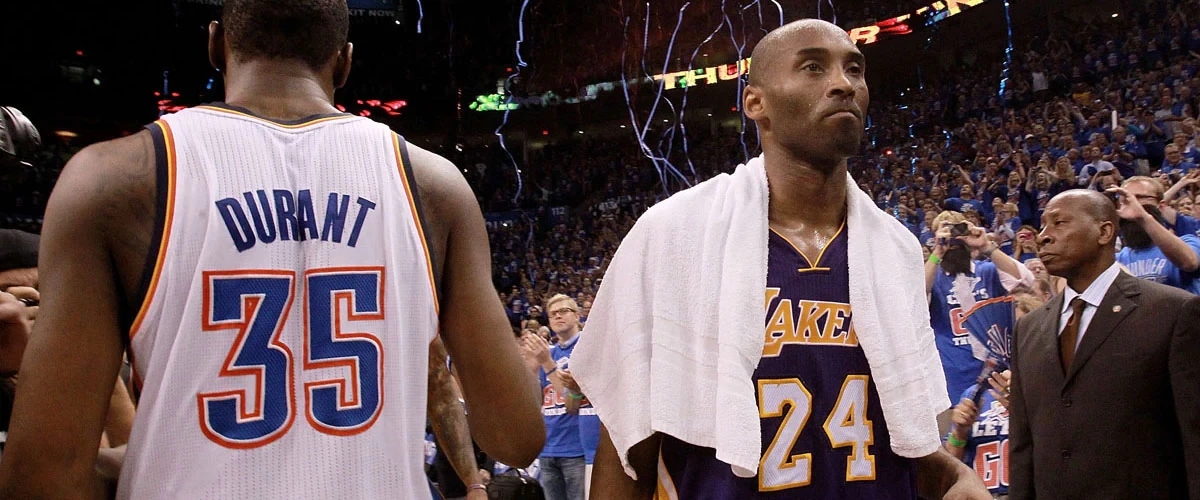
2011-12
Lakers Season Review
The 2011-12 Lakers campaign almost never got off the ground, with the NBA lockout that began on July 1 extending into late November until an agreement was finally forged.
As such, new coach Mike Brown – hired over the summer to replace Phil Jackson – had quite a challenge, afforded only a two-week preseason to put in an entirely new system. Adding to the difficulty was a trade that ended up not going through, with reigning Sixth Man Lamar Odom an ultimate casualty of the process as he ended up in Dallas in exchange for a trade exception and a second round pick.
The season began on Christmas Day, with the Lakers opening the year playing unprecedented back-to-back-to-back games because of the compressed 66-game schedule. L.A. opened without the services of center Andrew Bynum, who was serving a 4-game suspension stemming from a second-round sweep to Dallas in the 2011 playoffs, and narrowly lost its first two contests.
The purple and gold struggled to string together consistent performances early on, especially on the road, where they posted just a 2-7 record during the first month of the season. But thanks to Kobe Bryant, they still managed to win a lot of games. Despite battling through a torn ligament in his wrist, the longtime All-Star strung together four games of 40+ points in early January, carrying a Lakers offense that was still trying to adjust to the new system.
Looking to upgrade a roster that posted a 27-16 record before the trade deadline, Lakers GM Mitch Kupchak traded for Cavs reserve point guard Ramon Sessions, while sending Derek Fisher to Houston in a separate deal that also pought big man Jordan Hill to Los Angeles. With Sessions adding a pick and roll game to the offense, the Lakers looked a more dangerous team heading into the postseason, highlighted by a 17-point, 9-assist performance at Dallas a week after he was acquired in mid March.
The Lakers closed the season with a 14-9 mark to finish at 41-25, enough for third place in the Western Conference, their play slipping a bit after the No. 1 spot was no longer in reach. Among the major positives from the regular season was the play of Bynum, who missed only one game due to injury and averaged 18.7 points and 11.8 boards — both career highs — with 1.9 blocks on 55.8 percent shooting. That was good enough to earn the starting center slot on the Western All-Star team, where he joined 14-time All-Star Bryant.
In mid-April, Bynum pulled down a career-high 30 rebounds at San Antonio. Only four other Lakers in franchise history had previously accomplished that feat: George Mikan; Elgin Baylor; Wilt Chamberlain and Kareem Abdul-Jabbar.
Bynum's game was absolutely aided by the play of Gasol, who moved away from the basket despite maintaining the NBA's best low post skills in order to accommodate his younger, bigger teammate. One week after Bynum’s 30-rebound game, Gasol put up his fifth career triple-double on the road at Golden State with 21 points, 11 rebounds and 11 assists. Gasol's play down the stretch helped the Lakers go 5-2 while Bryant missed seven games due to a painful shin injury.
The Lakers drew the Denver Nuggets in the first round of the playoffs, taking a commanding 3-1 lead despite playing without Metta World Peace, suspended seven games for elbowing James Harden in the second to last regular season game. Denver rallied to win the next two games, forcing a Game 7 at Staples Center, but the Lakers won out behind a combined 39 points, 35 rebounds and 10 blocks from Bynum and Gasol, plus 17 points and eight assists from Bryant.
Next up for the Lakers: the Oklahoma City Thunder. L.A. faced an early 1-0 deficit and found themselves within two minutes of sending the series back to Los Angeles all knotted up. Up seven points down the stretch of Game 2, L.A. couldn't hold on for the victory, and faced a 2-0 deficit heading home for Game 3.
L.A. won Game 3 in front of its fans, but again blew a lead in the final moments of Game 4, OKC closing the game on a 22-8 run to take a commanding 3-1 lead in the series. The Lakers were fatigued against the younger Thunder, since Games 3 and 4 came on a very rare playoff back-to-back, due to the condensed schedule forced by the lockout.
Bryant went off for 42 points in Game 5, but it wasn't quite enough, the Thunder winning 106-90 to send the Lakers home before the Western Finals for the second consecutive season.
The answer from Kupchak and Dr. Jerry and Jim Buss? Get Dwight Howard and Steve Nash for the coming season.
Return to top of page
2012-13
Lakers Season Review
Few seasons in the history of the Lakers that began with as much promise as the 2012-13 campaign were as turbulent and ultimately disappointing.
An unfortunate run of injuries and a lack of chemistry between a star-studded – if newly-assembled – roster saw the team that was on the cover of Sports Illustrated with a “Now This is Going to be Fun” title (and the consensus prediction to win it all) lose in the first round of the playoffs.
It looked so good at first...
Rewind to the end of 2011-12, when the Lakers lost to Oklahoma City in Round 2 of the playoffs. That offseason, L.A. had what appeared to be one of the best offseasons in recent NBA history. GM Mitch Kupchak and the front office acquired both two-time MVP Steve Nash (in a trade with Phoenix) and multiple-time All-Star Dwight Howard (in a trade with Orlando), who graced that S.I. cover, to pair with Kobe Bryant, Pau Gasol and the supporting cast.
However, things took a quick downward turn when Nash fractured his leg in just the second game of the season, a key part of a 1-4 start the saw coach Mike Brown get fired. In stepped Mike D’Antoni, who’d coached Nash to such success in Phoenix, but who himself was coming off knee surgery from which he’d yet to fully recover.
Nash would play in 50 of the 82 games, but was never really himself, instead constantly plagued by back, hamstring and hip issues.
And while that injury to Nash would have lasting impact, it was a season-ending injury to Bryant that spelled ultimate doom. Kobe, who’d been playing terrific, All-Star individual basketball as usual all season – 27.3 points, 6.0 assists and 5.6 rebounds with 1.4 steals – tore his left Achilles tendon in the third-to-last game before the playoffs.
Bryant had been carrying an incredible load with the ailing Nash and Howard playing below expectation, the Black Mamba averaging 30.5, 7.5 and 7.0 in 45.2 minutes per game in April. He basically refused to come out of games, and pushed himself to the literal brink. Bryant’s effort dragged the Lakers from a low point of eight games below .500 (17-25) in January to a 45-37 final record. But without him, the Lakers had little chance to beat San Antonio, who swept L.A. out of the first round.
Pau Gasol had some issues with his deployment on the floor under pace-and-space D’Antoni, and saw his averages dip to 13.7 points, 8.6 boards and 4.1 assists (down from 17.4, 10.4 and 3.6 in 2011-12) as he often found himself on the perimeter.
Howard was brought in to run screen/roll with Nash, but preferred to post up, which wasn’t a great fit in D’Antoni’s offense or with L.A.’s personnel. He posted solid numbers nonetheless with 17.1 points, 12.4 boards and 2.4 blocks, but really struggled to fit in.
Role players Metta World Peace, Steve Blake, Earl Clark, Antawn Jamison and Jodie Meeks contributed to varying degrees of success, with Clark starting 36 games and Blake 13.
L.A. ranked ninth in the NBA in offense despite finishing 17th in assists, and struggled defensively to the 20th spot in defensive efficiency. They played the fifth-fastest pace in the league and grabbed the fourth-most boards.
The struggles of 2012-13 would carry over into 2013-14 as well, as Nash and Bryant combined to play in only 21 total games, and Howard left in free agency.
Return to top of page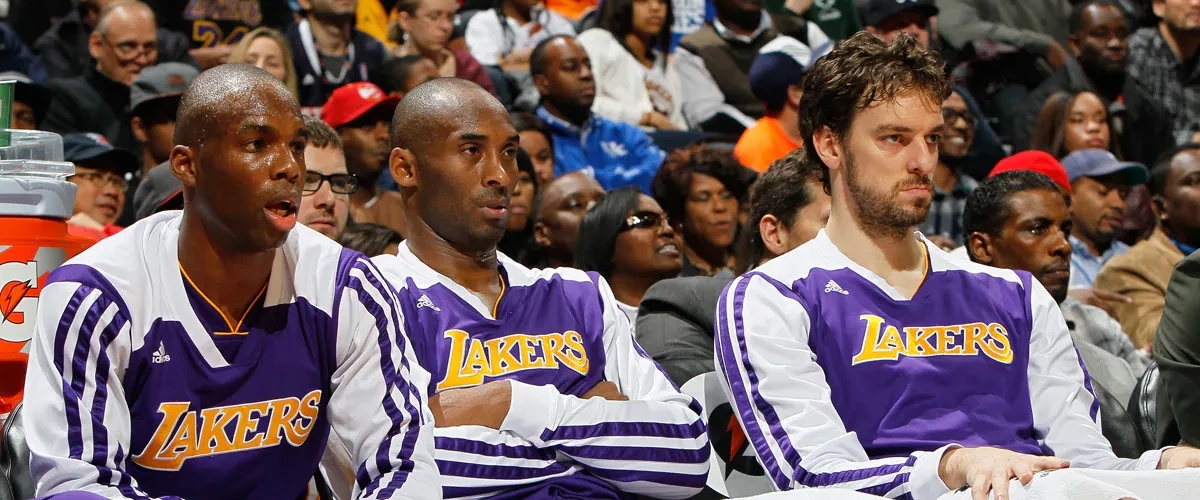
2013-14
Lakers Season Review
No Laker was safe from injuries during the 2013-14 campaign, as Los Angeles’ roster missed a league-high 319 games due to health reasons.
Future Hall of Famers Kobe Bryant and Steve Nash only played 21 contests combined, as 19 different players suited up for the Lakers.
Despite losing Dwight Howard to free agency, waiting for Bryant to recover from an Achilles tear and waiving Metta World Peace over the offseason, the Lakers managed to keep afloat at the beginning of the year by starting 10-9.
However, they were not able to continue to tread water, instead finishing the season with a 27-55 record and missing the playoffs for the first time in nine years.
Under the direction of head coach Mike D’Antoni — who resigned after the year — the Lakers played high-tempo basketball that reached the NBA’s second-fastest pace (97.7 possessions per game).
This resulted in plenty of offense, as the team ranked second in made 3-pointers (9.4), third in 3-point percentage (38.1) and fourth in assists (24.5). However, it also amplified the Lakers’ issues on the defensive end.
Despite scoring the league’s 11th-most points (103.0), Los Angeles allowed the second-most (109.2). Opponents also racked up the second-most assists (25.8), while also dominating on the glass. No team surrendered more total (49.0) or offensive boards (13.0) than the Lakers, who were outrebounded by 8.0 per game.
Though L.A. also surrendered the NBA’s most steals (9.6), several Lakers benefitted from D’Antoni’s high-velocity offense.
While Bryant only played from Dec. 8-17 before a knee injury prematurely ended his season, Nick Young thrived off the bench by providing a team-high 17.9 points on 43.5 percent shooting. The sixth man also had a knack for the big play, tallying a franchise-record seven four-point plays.
After being signed midseason, Kendall Marshall thrived in the system, piling up the league’s 10th-most total assists (477), while recording the second-highest assist percentage (44.3). He averaged 8.0 points and 8.8 assists per contest.
Jodie Meeks pitched in 15.7 points and a team-best 1.4 steals, while hitting 40.1 percent from 3-point range. Though Pau Gasol wasn’t especially suited for the offense, he still put up plenty of numbers by adding 17.4 points, 9.7 rebounds, 3.4 assists and 1.5 blocks per game.
Meanwhile, Jordan Hill was a standout on the boards. He posted the NBA’s third-highest offensive rebound percentage (13.8) by grabbing 2.7 in 20.8 minutes per game.
While the Lakers set a new franchise mark for most losses in a season, there were still some highlights.
In his limited time, Nash nonetheless managed to reach 10,335 career assists, hitting third on the NBA’s record book before never playing again. Plus, Gasol finished the year with 16,576 career points, moving past Detlef Schrempf for the second-most ever by a European player.
In addition, the Lakers pounded New York, 127-96, on March 25, setting a franchise record in the process by scoring 51 points in the third quarter alone.
Return to top of page
2014-15
Lakers Season Review
To understand how the Lakers finished 2014-15 with the worst record in franchise history (21-61), look no further than the combination of a league-high 339 games missed to injury/illness, and the preseason commitment to maintaining roster flexibility heading into the coming summer.
Some background: After the Lakers went to three consecutive NBA Finals (2008-2010), General Manager Mitch Kupchak and his staff first attempted to trade for Chris Paul, before ultimately moving to acquire Dwight Howard and Steve Nash. Howard departed for Houston prior to 2013-14, and Nash proved unable to stay healthy, and was declared out for the season in October ahead of his subsequently announced retirement later in the year.
With Pau Gasol signing in Chicago last summer, Kobe Bryant was the lone holdover from that championship run. And as Kupchak has reiterated on several occasions, it was the Lakers’ wish to maintain some financial flexibility heading into the final season of Bryant’s large contract, which led to L.A. avoiding signing players that it didn’t see as future championship pieces or stars to long-term deals.
Head coach Byron Scott replaced Mike D’Antoni, but dealt with a similar roster of players on short-term contracts, a nod to that need for future flexibility. Kupchak assembled a roster that the organization thought would be competitive, if not one capable of seriously contending, but no fewer than seven players – Bryant, Nash, Nick Young, Julius Randle, Xavier Henry, Ronnie Price and Wayne Ellington – suffered season-ending injuries at some point of the campaign.
Such was the injury situation that the Lakers had only two available guards for the season finale against Sacramento on April 15, and both were call ups from the D-Fenders of the D-League: Jabari Brown and Vander Blue. Midseason acquisition Tarik Black made for the third undrafted rookie in the starting lineup. Black made his mark with athleticism, finishing third among all rookies in rebounding, and all three are ones to watch on L.A.’s Summer League or perhaps preseason rosters.
Bryant’s injury was the most impactful to the loss column: He tore his rotator cuff on Jan. 21 at New Orleans and was shut down for the season. Despite struggling with his efficiency while shooting a career-low 37.3 percent from the field, Bryant did finish ninth in the league with 22.3 points per game, and passed Michael Jordan for third on the NBA’s all-time scoring chart with 32,482 points.
Randle, a hardwood star since middle school and during his one year at Kentucky, fell to the Lakers at No. 7 overall in the 2014 Draft. He’d be a harbinger for L.A.’s season when he went down in the first game against Houston on Oct. 28, and was unable to show off the skills that made him the highest Lakers draft pick since James Worthy (1982). Randle drew rave reviews inside the facility for his dedication to studying the game and attacking his rehabilitation, dead set not to waste his rookie year in preparation for the coming season.
Easily the biggest bright spot for the Lakers was the emergence of Randle’s fellow rookie and No. 46 overall pick Jordan Clarkson, who rose from relative unknown to the Western Conference Rookie of the Month for March. Clarkson got his chance to play in part due to all of the injuries, and he certainly capitalized upon it. After the All-Star break, Clarkson averaged 16.7 points on 47.9 percent shooting with 5.4 assists, 4.6 rebounds and 1.0 steals in 32.6 minutes per game, proving himself a real asset for the organization moving forward.
Ed Davis was another consistent plus for the purple and gold, ranking 10th in the NBA in offensive rebounds (230) despite limited playing time as Scott developed the young roster. He made 60.7 percent of his shots, ranking second only to DeAndre Jordan (71.0 percent) in the NBA.
Fellow veterans Jordan Hill, Jeremy Lin, Carlos Boozer and Wesley Johnson had moments of success throughout the year, while former Lakers second round picks Ryan Kelly and Robert Sacre earned plenty of playing time to develop their games.
If there�’s a positive out of the season aside from Clarkson’s emergence, it’s that the Lakers have the fourth-best chance to earn a top three pick in the 2015 Draft. They also possess Houston’s first-round pick (No. 27 overall) and have space to acquire talent in free agency. Coupled with the return of Bryant, Randle and Young from injury, 2015-16 can’t come soon enough after the most difficult of seasons in Los Angeles.
Return to top of page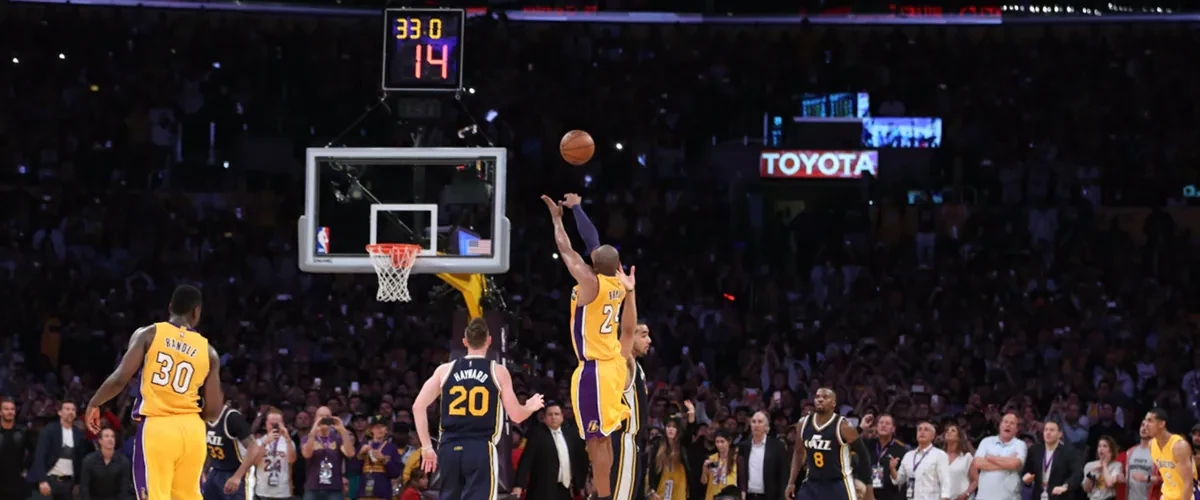
2015-16
Lakers Season Review
An incredible 60-point performance from Kobe Bryant in the final game of his Hall-of-Fame career put a bow on what was otherwise a very difficult 2015-16 season for the Lakers.
L.A. went 17-65, finishing behind only Philadelphia. The Lakers did end up with the No. 2 overall pick as a result – which turned into Brandon Ingram – to serve as a payoff for a difficult season to stomach for the proud franchise.
The two stated 2015-16 goals from coach Byron Scott* had been to send Kobe out the right way, and to develop a group of young players that the franchise hoped would offer dividends down the road.
*Scott’s contract was not picked up after the season.
An argument can be made that both were accomplished as the year wore on, with Bryant staying healthy enough to play in 66 games, averaging a team-best 17.6 points at age 37 through a career-low field goal percentage (35.8). Bryant showed a softer side to the Black Mamba personality, delighting fans across the country and watching around the world. There were moments of brilliance, gems spread across the campaign, of course none equaling the April 13 finale in which Jack Nicholson, Jay-Z, Kanye West and, well, everybody, could only observe and cheer in disbelief as Bryant’s point total climbed and climbed as he delivered a final victory.
Meanwhile, the young quadrant D’Angelo Russell, Jordan Clarkson, Julius Randle and Larry Nance, Jr., who closed that final game against Utah next to Bryant, all showed degrees of progress and, thus, signs of hope moving forward.
Kobe, and to a lesser degree, veteran Lou Williams, dominated the basketball for much of the season, but when Russell was given the reigns, he produced like many expected from the 2015’s No. 2 overall pick.
In 10 games just after the All-Star break, Russell averaged 21.0 points, 4.8 assists and 3.1 3-pointers made, highlighted by a 39-point season-high effort against Brooklyn in which he drained a dagger three. His minutes ticked up as Bryant took a few games off, and he responded by showcasing his mix of shooting, passing and size. Russell’s season averages of 13.2 points, 3.3 assists and 3.4 boards with 1.2 steals rank right there with what current All-Star point guards produced when they were just 19 years old.
With a long way to grow on both ends of the floor and in the weight room, Russell attacked the offseason and was arguably the best player in the Las Vegas Summer League. He has a chip on his shoulder heading into his second season.
Russell’s backcourt mate, Clarkson, built on a solid rookie season by serving as the team’s most consistent offensive player, producing 15.5 points per game on 43.3 percent shooting plus 4.0 boards and 2.4 assists with 1.1 steals per game. The No. 46 overall pick in 2015 was rewarded with a new contract after the season, and is expected to start alongside Russell in the backcourt next season and, perhaps, for years to come. Clarkson recognized the need to improve his defense, a focus for the offseason, in addition to his three-point range (34.7 percent).
In what was essentially Randle’s rookie season – considering he only played 14 minutes in 2014-15 before breaking his leg – he was one of only 13 players in the NBA to average a double-double, ranking 15th with 34 of them. In 28.2 minutes per game, Randle still ranked 10th overall on the glass, and grabbed more defensive boards than all but two players (Andre Drummond and DeAndre Jordan). The former No. 7 overall pick was in the Lakers’ practice facility more than any other player in the offseason, working to improve his entire game, with a focus on his jump shot and right hand.
Nance, Jr. went from being a relative unknown as the No. 27 overall pick out of Wyoming to a clear NBA rotation player with upside thanks to his combination of elite athleticism and hoops IQ. He scored 5.5 points with 5.0 boards and nearly a steal per game in 20.1 minutes despite battling an at-times sore knee that he tore in college. Now healthy, Nance, Jr. was terrific at Summer League and could have a critical role in new coach Luke Walton’s rotation.
The Lakers got contributions in other areas from veterans like Williams (15.3 points), Roy Hibbert (1.4 blocks) and Brandon Bass (7.2 points, 4.3 boards), but it was generally either Bryant or the young guys that were the focus.
The team got younger for 2016-17 with the additions of Ingram and No. 32 overall pick Ivica Zubac (both 19), though free agent signees Luol Deng and Timofey Mozgov – as well as Jose Calderon, acquired in a trade – will bring valuable experience.
It would be impossible for any franchise to replace a player like Bryant, who brought so much for so long. With that said, Walton’s hiring has already brought a newfound energy into the franchise. That combined with a talented stable of young players from the last three NBA Draft’s has the Lakers eager and optimistic to move forward from a difficult 2015-16 campaign.
Return to top of page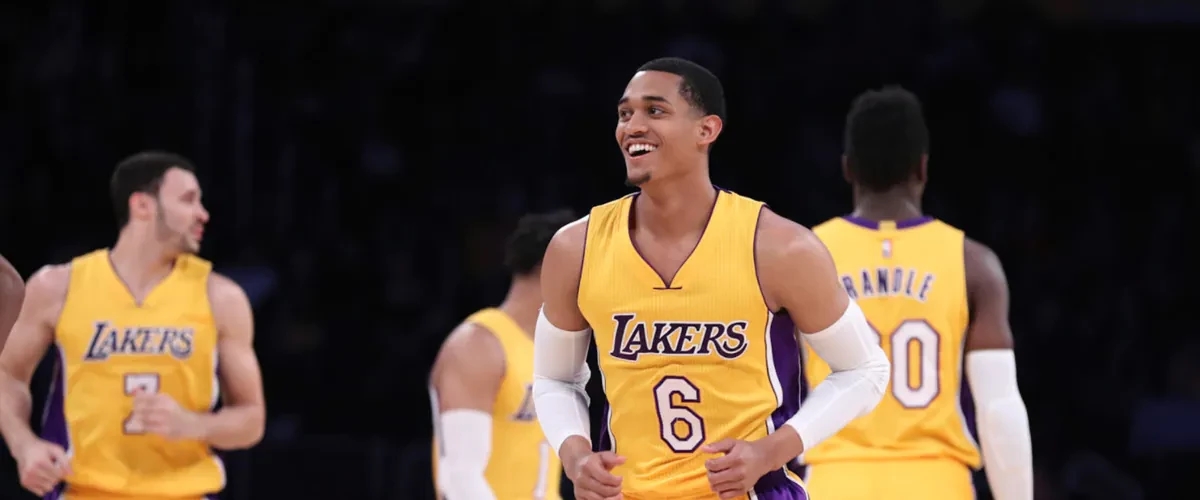
2016-17
Lakers Season Review
Under first year coach Luke Walton, the Lakers went 26-56 to finish with the third worst record in the NBA, despite winning nine more games than the 2015-16 squad.
The season was marked by significant changes in the front office. Just before the All-Star break, Lakers Co-owner and Governor Jeanie Buss hired a new President of Basketball Operations, Earvin “Magic” Johnson, and soon added a new GM, Rob Pelinka to replace Jim Buss and Mitch Kupchak.
In Magic’s first move, the team’s leading scorer in the first half of the season, Lou Williams, was shipped to Houston for the Rockets’ first round pick and Corey Brewer. Meanwhile, L.A. traded veteran guard Marcelo Huertas to Houston for young point guard Tyler Ennis in a separate deal. They then waived another veteran, Jose Calderon, and called up David Nwaba from their D-League affiliate L.A. D-Fenders.
In concert with Walton, Johnson and Pelinka oversaw the continued development of the many young players on L.A.’s roster, as many of the veteran players sat subsequent to the break.
Some of the vets played well earlier in the season, like Nick Young, and some struggled, like Luol Deng. Others played OK, like Timofey Mozgov. Young hit an impressive 170 three-pointers in just 60 games, nearly setting a franchise record (Nick van Exel, 183) on a solid 40.4 percent, while playing some of the best defense of his career. Deng managed just 7.6 points per game on 38.7 percent shooting, while Mozgov scored 7.4 points with 4.9 boards in 20.4 minutes.
But the focus of the season was on the improvement of 19-year-old Brandon Ingram, Ivica Zubac (20), D’Angelo Russell (21), Julius Randle (22), Jordan Clarkson (24) and Larry Nance, Jr. (24).
Nobody made bigger gains than Ingram. While learning what the NBA was all about early in the season, the four-time state champion from Kinston, N.C. averaged 8.0 points per game on 36.3 percent from the field. But after the All-Star break, something clicked, and Ingram put up 13.2 points on 47.5 percent from the field, looking like a totally different player. No Laker received more praise in the exit interviews from his teammates, in addition to Walton and Pelinka, and it was for good reason. Having gone against LeBron, Kawhi, Paul George and Durant, Ingram picked up the consistent aggressive mentality needed to succeed as a two-way wing player, and grew in confidence with each matchup. His future is quite bright.
Speaking of bright, fellow 2016 selection Ivica Zubac (No. 32) was quite the pleasant surprise. Looking at per 36 numbers from his 11 starts, Zu averaged 16.8 points (52.9 percent field goals), 9.4 boards and 2.0 blocks with 1.8 assists. Improving his defensive versatility will be a big focus, but he really showed off his wide array of post moves, great hands and strong work in the screen/roll game in addition to his ability to protect the rim. He went off for 25 points on 12 of 15 FG’s plus 11 boards at Denver (3/13/17).
Russell made some major gains in his second season season. In 21 games after the break, he averaged 18.5 points on 42.5 percent field goals and 35.6 percent from three (2.5 makes per game), along with 5.0 assists and 1.8 steals to lead the team in each category. Russell showed his varied skill set at both PG and SG, including an excellent handle, an ability to score inside and out, a quick release on his shot and some real talent to find teammates in screen/roll situations or just generally within Walton’s offense. He’ll need to continue to work on his body, and on his defense, but he’s well ahead of pace statistically on most of the current NBA All-Star guards when they were 21.
Randle saw a jump in production despite playing just about the same number of minutes from his second season, most notably raising his field goal percentage from 42.9 percent to 48.7 percent. How? His shot selection and patience improved significantly, and he made progress on his jump shot and finishing at the rim. His per 36 numbers were strong: 16.5 points; 10.7 boards; 4.5 assists and 0.8 steals. When Randle played at peak energy, L.A. was a much better team, and Walton and the front office have challenged him to improve his body even more to be able to play like that more consistently. Even so, he tied Nance, Jr. for the most win shares on the team in 2016-17 (3.5).
Clarkson was one of the NBA’s most productive bench players for much of the season, before Walton tried him as a starter alongside Russell after the break. His numbers were similar to his second season, as he posted 14.7 points on 44.5 percent shooting on the season (15.5 points, 43.3 percent in 2015-16). But his production spiked after the break as his minutes went up, resulting in 19.4 points and 4.2 assists a night.
ance, Jr., such a versatile talent that L.A. smartly grabbed at No. 27 overall in 2015, had some well-rounded per-36 minutes numbers: 11.2 points; 9.2 boards; 2.4 assists; 2.0 steals; and 1.0 blocks. He showed his versatility by being productive in a reserve power forward role, and also as a starting center late in the season. No Laker played better off-the-ball defense, and he pledged his desire to keep improving on the ball as well.
Nwaba and Ennis both showed signs of being legitimate NBA rotation players once receiving regular minutes late in the season, and reserve bigs Tarik Black and Thomas Robinson had their respective moments as well.
Metta World Peace made an incredibly positive impact on his younger teammates, which Walton and the young players went out of their way to note throughout the season. His on-court production was limited, but he managed to go out with an unlikely 18-point performance at Staples Center in what was likely his last game for the Purple and Gold.
In sum, the talented young core is now established alongside the combination of a very popular head coach and new front office, giving reason for excitement that everything is headed in the right direction towards the thing the Lakers care most about: winning more games.
Return to top of page
2017-18
Lakers Season Review
With a 35-47 record in the 2017-18 campaign, the Lakers added nine wins from the previous season, and saw their young players continue to improve to solidify a talented young core that’s been built through the past four NBA Drafts.
The season really began in Las Vegas, where the Lakers won their first Summer League championship as No. 2 overall pick Lonzo Ball earned MVP honors, and No. 27 pick Kyle Kuzma was named MVP of the championship game. Soon after, the Lakers moved from the Toyota Sports Center into the state-of-the-art UCLA Health Training Center, which the players (and staff) were thrilled to declare their new home.
After starting the regular season 5-5, the Lakers struggled with injuries and unsteady play and fell to a low point of 16 games below .500 (11-27) on Jan. 5. That concluded a 9-game losing streak in which L.A. lost a series of close games to tough opponents, and in the midst of it, Julius Randle entered the starting lineup, Ball returned from a shoulder injury and Brandon Ingram started to play the best basketball of his career as the team turned things around rather quickly.
In fact, the Purple and Gold went 20-9 through March 13 to take the record up to 31-36. They remained a distance away from the final playoff spot due to the early losing, but L.A.’s play under 2nd-year head coach Luke Walton was improved enough to catch the attention of the league.
While the Lakers ended up finishing the season with the 8th fewest games missed to injury/illness (133, which was well below the league average of 185), many of those games came in the final month, when Ball, Ingram and Isaiah Thomas missed the bulk of the action. In related news, the Lakers struggled to log wins in the final weeks, going 4-11 to finish the season.
As the sixth-youngest team in the NBA, the Lakers truly relied upon players in their first few seasons, and a terrific 2017 Draft helped considerably towards that end.
Ball averaged 10.2 points, 7.2 assists, 6.9 rebounds and 1.7 steals, numbers that closely mirror those of Jason Kidd’s rookie campaign (11.7, 7.7, 5.4, 1.9), and he was very good defensively, particularly for a 20-year-old, which helped him have the best net rating on the team. He was named to the All-Rookie 2nd team despite missing 30 games with various injuries.
Kuzma – acquired in an offseason trade with Brooklyn involving Brook Lopez, Timofey Mozgov and D’Angelo Russell – was a revelation that ultimately made the All-Rookie 1st team behind his 16.1 points (tied for the team lead), 6.3 rebounds and 159 made 3-pointers on 36.6 percent behind the line.
No. 30 pick Josh Hart was also impressive, particularly late in the season. He averaged 7.9 points and 4.2 rebounds while leading the team in 3-point shooting (39.6 percent), and more notably, in 23 starts, posted 13.3 points, 6.0 boards and 2.0 assists with 1.0 steals.
At No. 42, L.A. took Thomas Bryant, and while the 20-year-old appeared in only 15 games with the Lakers, he tore up the G-League for the South Bay Lakers, averaging 19.7 points, 7.4 boards and 1.5 blocks in 37 games and made G-League First Team.
Still younger than most rookies, Brandon Ingram turned 20 in September, and finished the season matching Kuzma and Randle with 16.1 points per game to lead the team, adding 5.3 boards, 3.9 assists, 0.7 steals and 0.6 blocks. He improved his shooting percentage from 40.2 as a rookie to 47.0 percent, and his three-point percentage from 29.4 to 39.0, while also showing even more versatility than some expected by playing point guard, as he successfully filled in for Ball in February. Ingram did miss 23 games with a variety of minor injuries late in the season after posting 18.6 points, 5.6 assists, 5.2 boards, 1.1 blocks and 0.6 steals in February on 54.5 percent from the field and 52.2 percent from three.
Ingram, Ball and Kuzma all had arguments for team MVP, but Julius Randle may have been the best player on the team, particularly once he entered the starting line up in late December. In his 49 starts, he went for 18.6 points, 9.1 boards, 3.1 assists and 0.6 steals on 56 percent from the field and 75 percent at the free throw line. Randle showed the ability to defend big men inside while also switching onto guards on the perimeter, which unlocked L.A.’s ability to play small and switch 1 through 5. Furthermore, he played all 82 games, the only Laker to do so.
Lopez and Kentavious Caldwell-Pope were the two veterans that were with the Lakers throughout the season, and each had moments of strong play, particularly later in the season. Meanwhile, Corey Brewer and Isaiah Thomas contributed on- and off-court leadership before and after the All-Star break, respectively.
Tyler Ennis had his best month of action in April when Ball and Ingram were both out, while Luol Deng played only in the first game of the season.
L.A. also took advantage of the first year for the two-way contracts with the South Bay Lakers, and got some needed minutes from Alex Caruso throughout the season, as well as Vander Blue and eventually Gary Payton II. They also called up longtime D-League/G-League veteran Andre Ingram for the final two games of the season, and Ingram scored 19 points on 6 of 8 shooting with three blocks in his NBA debut against Houston, more swats than he’d ever totaled in 10 years of minor league hoops.
At the February trade deadline, Larry Nance, Jr. and Jordan Clarkson were traded to Cleveland for Thomas, Channing Frye and Cleveland’s 1st Round pick (No. 25 overall), a move that allows the Lakers to get back into the first round, since their own pick (No. 10 overall) will be made by Philadelphia*.
*Philly acquired the pick from Phoenix, who’d in turn acquired it back in 2012 from the Lakers in the Steve Nash deal.
That move by President of Basketball Operations Magic Johnson and GM Rob Pelinka also freed up additional salary cap space heading into the offseason, giving the Lakers the opportunity to be in the mix for free agents, or to assume contracts in a trade, if so desired.
With a very strong stable of young talent that should continue to get better, plus the space to add significant pieces, the Lakers appear closer to once again establishing themselves as the NBA winner that they’ve traditionally been.
Return to top of page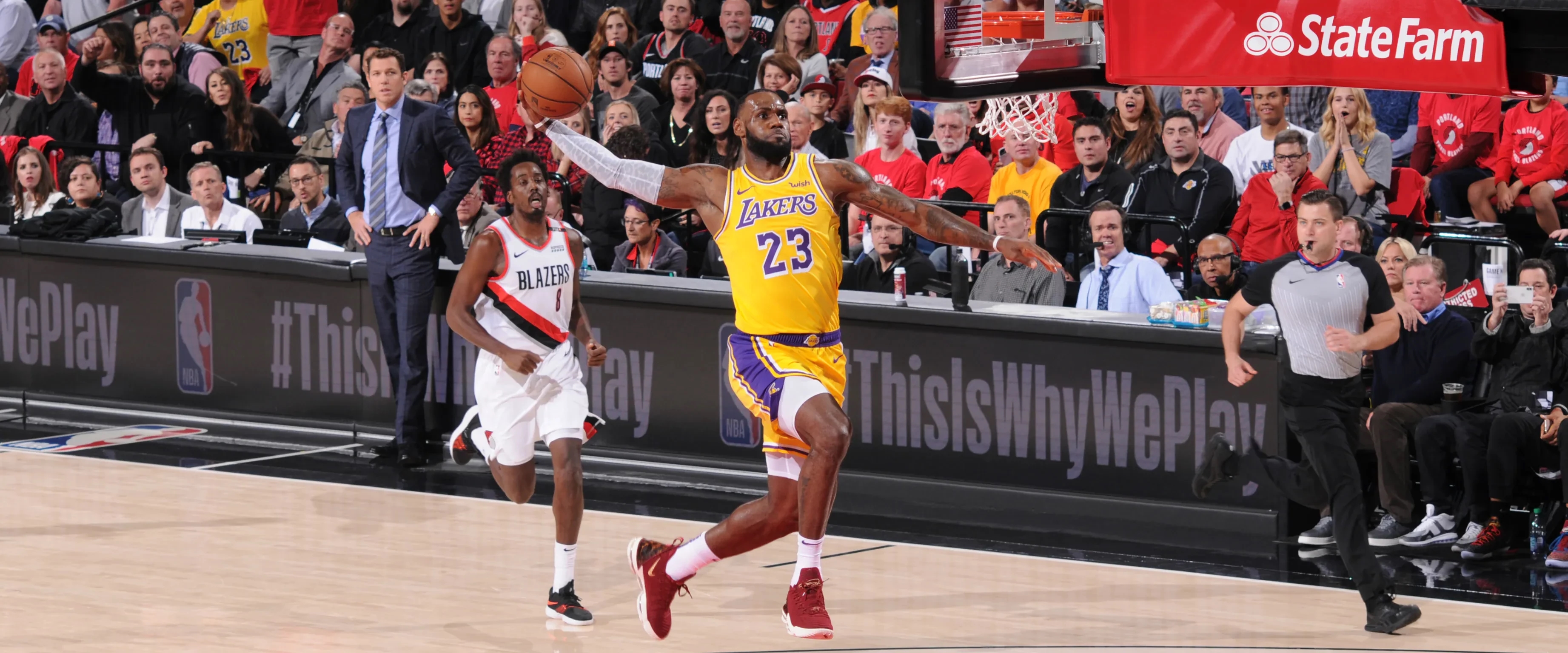
2018-19
Lakers Season Review
When LeBron James decided to join the Lakers as a free agent in July of 2018, he brought not only his four MVP’s and three Finals MVP’s, but a sense of confidence that L.A. would return to NBA prominence.
Unfortunately, a slew of injuries that sidelined LeBron – who was limited to a career-low 55 games – as well as several of his teammates were perhaps the biggest factors in taking the Lakers from the No. 4 seed in the West on Christmas Day to the No. 10 seed at season’s end (37-45).
James suffered a groin strain late in that Dec. 25 win at Golden State, and wouldn’t return for roughly six weeks, as L.A.’s playoff hopes took a big hit.
In a crowded West featuring many teams that returned largely intact from the previous seasons, the Lakers were already at a continuity disadvantage. They had a group of talented young players to go with veterans primarily signed on expiring contracts, theoretically to preserve cap space for the upcoming summer, all figuring out the best way to complement LeBron’s game.
Instead of improving as the season went along, the continuity suffered further when Brandon Ingram, presumed sidekick-to-LeBron, missed four games in October (suspension) and six in December (ankle) before his season ended on March 2 due to Deep Venous Thrombosis (DVT) in his arm that was surgically repaired on March 16. Ingram had been playing his best basketball of his career in the six games after the break, averaging 27.8 points on 57.0 percent shooting and 52.9 percent from three, plus 7.5 rebounds and 2.5 assists in 37.2 minutes per game.
Fellow No. 2 overall pick Lonzo Ball had just begun to find a nice offensive rhythm to couple his consistently excellent defense when he badly sprained his ankle on Jan. 19, the last time he appeared on the court. And with Josh Hart battling knee tendinitis from late December through his final game on March 19, and Ivica Zubac traded at the deadline for Mike Muscala, Kyle Kuzma was the only member of L.A.’s young core who stayed healthy through late March, when his season ended due to left foot tendinitis.
By way of impact on the team’s record, each of those injuries were significant, although none more than James. The 15-time All-Star had appeared in95.1 percent of the 1,453 games in his 15-year career,including all 239 playoff games, so his injury was certainly not expected. Of course, the mileage on his legs after eight straight trips to the NBA Finals is certainly significant, but he does now get his first full offseason since 2005 to get his body primed for 2019-20.
Overall, the Lakers ranked 22nd in the NBA* in games lost to injury (192).
*According to the Smart injury database.
The offseason will be just as important for Ingram and Ball to get fully healthy, because when they shared the court with LeBron, L.A. went 15-8, good for a 65.2 percent win rate. Though it’s a smaller sample size, that 65.2 percent would have had the Lakers battling for a top four playoff spot alongside Denver (65.9), Portland (64.6) and Houston (64.6).
Coach Luke Walton, who mutually parted ways with the Lakers after the season before agreeing to become Sacramento’s head coach, emphasized effort on defense and pace on offense.
The Lakers finished the season ranked 13th in defensive efficiency; they were seventh when Ball got hurt in January, but just 23rd from that point onward. L.A. ranked 2nd in the NBA in both fastbreak points and points in the paint, and fourth in pace.
They really struggled offensively, however, ranking 23rd in efficiency, and 29th in 3-point percentage, free throw percentage and turnovers.
President of Basketball Operations Magic Johnson – who stepped down from his role on the final day of the season – and GM Rob Pelinka tried to address the lack of shooting at the trade deadline by acquiring the aforementioned Muscala in addition to Reggie Bullock (in exchange for Svi Mykhailiuk and a second-round pick). Neither Muscala nor Bullock were able to find a real rhythm on offense, but neither were the bulk of their teammates, at least from a shooting perspective.
That included LeBron, who shot 33.9 percent from three, his second lowest percentage since 2010-11 … but he was an absolute star on the court nonetheless, and led the Lakers in scoring, rebounds, assists, made threes, made free throws and minutes.
James averaged 27.4 points (+0.2 on his career average), 8.3 assists (+1.1), 8.5 rebounds (+1.1), 1.3 steals (-0.3), 0.6 blocks (-0.2), 51.1 percent FG’s (+0.6), 33.9 percent 3’s (-0.4) and 66.5 percent FT’s (-7.1). He was fifth in the NBA in scoring and third in assists, and became the only player in league history to rank in the top 10 in scoring (fourth) and assists (10th).
Kuzma upped his scoring from 16.1 points as a rookie to 18.7 in his second season, and saw his passing improve to 2.5 assists per game up from just 1.8. He was in a 3-point shooting slump for much of the season, hitting only 30.3 percent after shooting 36.6 percent in year one. However, he improved both his shot selection and his finishing, and still managed to up his overall FG percentage as a result.
Of the several veterans on expiring contracts, JaVale McGee had moments of real success both early and late in the season, with his 12.0 points setting a career high, and rebounding and block numbers nearly matching his 2011-12 highs. Rajon Rondo was a true leader in the locker room, though his struggles on the defensive end contributed to a net rating of -8.4, second last on the team. Lance Stephenson competed consistently on both ends, and joined Rondo as two of only four Lakers to shoot over 35 percent from three, a surprise for two players who haven’t always shot the ball well from three.
Tyson Chandler was very impactful in November after he was waived by the Suns and opted to sign with the Lakers, before nagging injuries limited his effectiveness on the court as the season went on. Kentavious Caldwell-Pope struggled for much of the season until his minutes went way up with all of the late-season injuries to his teammates, and he averaged 23.8 points per game in April (11.4 on the season).
No. 25 overall pick Moe Wagner suffered early in the season with an injury that occurred in summer league that limited his playing time, before he was able to earn some minutes late in the season. No. 39 overall selection Isaac Bonga also played sparingly, but showed flashes of potential with his unique length at the PG spot.
The team’s relationship with their G-League squad, the South Bay Lakers, was quite fruitful once again, as two-way players Alex Caruso and Johnathan Williams were impactful towards wins especially late in the season. Caruso led the Lakers in net rating (3.3) for players earning at least 20 minutes per game. Meanwhile, late-season call-up Jemerrio Jones defended and rebounded his way to a net rating of 10.7 in his six games, albeit ones in which the Lakers were already out of the playoff race with little but pride to play for.
If there’s a benefit from L.A.’s difficult season, it’s the resulting lottery pick �– projected to be the 11th overall selection – that was certainly unexpected at the start of the season. That, the return of a rested LeBron plus the young core and an absence of financial obligations to players that aren’t producing heading into the ever-important free agency period puts the Lakers in position to achieve in 2019-20 what they were unable to in 2018-19.
Return to top of page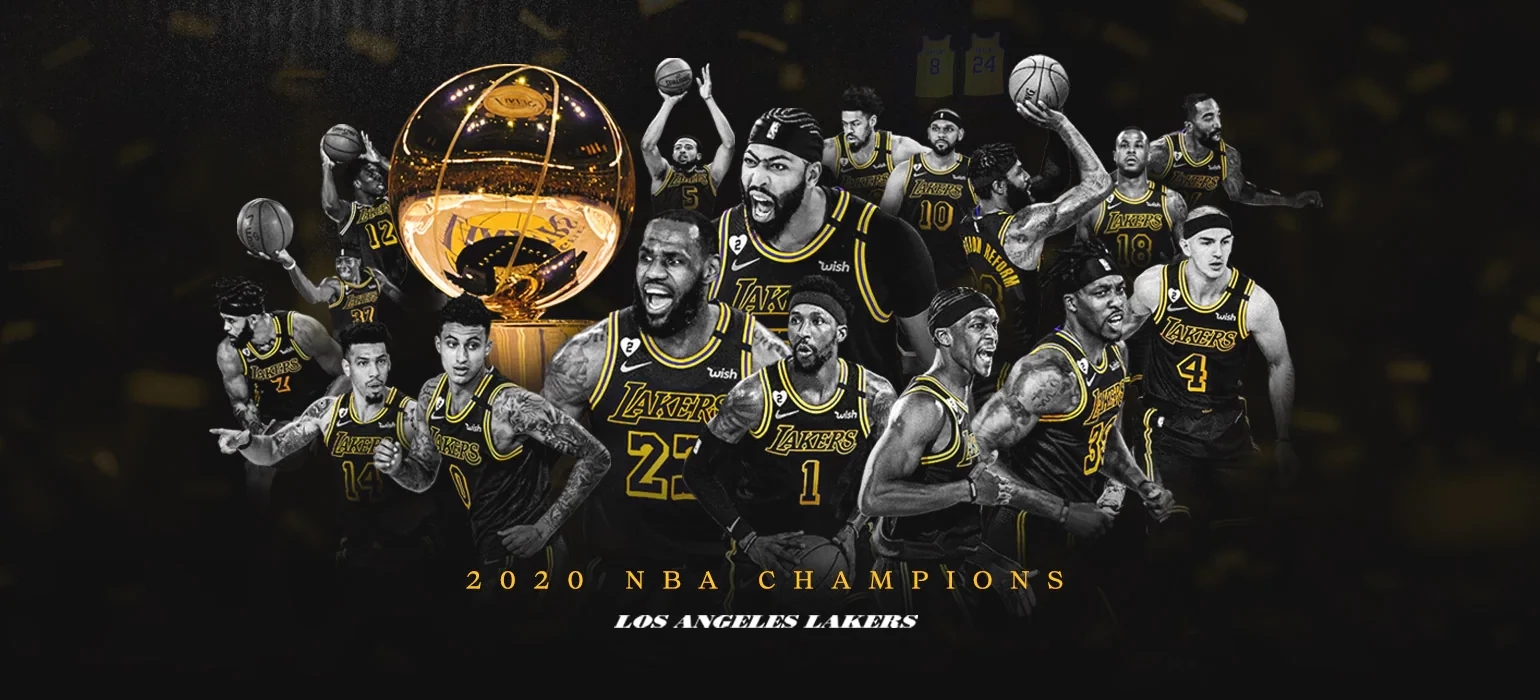
2019-20
Lakers Season Review
The most mentally challenging, emotional and longest season in NBA history finally culminated in a familiar place: the Los Angeles Lakers winning the title for the 17th time in franchise history.
What an Odyssey it was for a talented, experienced group of players led by Finals MVP LeBron James and his fellow All-NBA-First-Team member Anthony Davis, before they emerged from three months in the COVID-19-pandemic-proofed Bubble outside of Orlando.
On Oct. 11, 2020, the Lakers defeated the Miami Heat 106-93 to cap a tremendous 16-5 run to the Larry O'Brien trophy that featured 4-1 gentlemen's sweeps of Portland, Houston and Denver.
Oct. 6, 2019 seems further than one year prior to the raising of the trophy, but that's when the team left for a preseason trip to China.
During the unprecedented journey that ensued, the Lakers had to push through: the devastating loss of Kobe Bryant and his daughter Gianna in January; the pandemic that shut the season down from March through June; and the killing of George Floyd, Breonna Taylor and other victims of police violence that sparked a push for social justice, a recognition that Black Lives Matter and the pursuit of being Anti-Rascist, which for the Lakers, including the hiring of Dr. Karida Brown, the team's Director of Racial Equity and Action.
The team had to find a way to focus on basketball, and under the guiding vision of head coach Frank Vogel, they managed to take things one day at a time.
After the preseason trip to China amidst difficult circumstances, the Lakers returned to try and get ready for the Oct. 22 opener against the Clippers. While they narrowly lost that game, the Lakers promptly ripped off a seven-game winning streak. They'd never give up first place in the West for the rest of the season.
After a Nov. 10 loss to Toronto, L.A. won 10 straight to reach 17-2, then 24-3 after a particularly impressive set of road wins. L.A. beat Denver 105-96 on Dec. 3, then smashed Utah 121-96 the next night, before finishing off a three-game trip with a 136-113 handling of Portland.
The first losing streak of the season was from Dec. 17-25, with the Lakers losing four games, though that came after they'd played 12 of the prior 15 games on the road, and with LeBron and AD missing one game apiece.
They responded with nine wins in 10 games to reach a 33-7 mark. L.A. then won 11 of 12 games from Feb. 8 – March 8, climaxing with back-to-back home wins over the East No. 1-seeded Bucks, 113-103, and the West's No. 2-seeded Clippers, 112-103. The last game they played before the shutdown was on March 10, a loss to Brooklyn, bringing their record to 49-14, first in the West by 5.5 games.
For the next several months, the players had to work out on their own at their respective homes, aided by videos from the strength and conditioning staff, and in some cases, equipment that was dropped off. At a certain point, players were able to return to the UCLA Health Training Center for COVID-19-safe individual workouts, as the team prepped for quarantine and eventual travel to Florida to participate in three warm-up games to the eight seeding games that would count in the standings.
L.A. was without starting point guard Avery Bradley, opted out of the Bubble for personal reasons after a strong two-way regular season.
With "Black Lives Matter," "Say Their Names," "Vote" and "I Can't Breathe" on their jerseys, the Lakers first Bubble game was against LAC, in what many thought would be a preview of the West Finals. LAL handled business with a 103-101 win to essentially lock up the No. 1 seed. They were thus able to treat the remainder of the month like preseason to get ready for Round 1, and they went 2-5 while playing an extended rotation, and limiting the minutes for LeBron and AD in particular. They were also without Rajon Rondo due to fractured thumb, and he wouldn't be back until Round 2, where he'd make a big difference.
The Lakers opened the postseason against Portland, who'd won six of their eight seeding games to get into a play-in mini tournament with Memphis, and beaten the Grizzlies to secure a matchup with the No. 1 Lakers. And in Game 1, some of the rust from the seeding games carried through on offense. According to Second Spectrum, the Lakers had the worst "shooting luck" of any team dating back to the 2013-14 season, scoring 46 fewer points than expected based on the quality of the shots, the players who took those shots, and the number of free throws. They missed threes. They missed layups. And yet because their defense was very good, they still had a chance to win before ultimately falling 100-93.
From that point forward, the Lakers exerted their dominance, winning four straight games by a total of 60 points. L.A. held Portland, who averaged 123.4 points in the seeding games, to 106.0 per game. Vogel's defensive plan for Damian Lillard worked extremely well, limiting the All-Star to 24.3 points on 39.3 percent shooting, after he'd averaged 30.0 points on 43.7 percent FG's in the regular season.
A different, but similarly effective game plan helped contain James Harden and the Houston Rockets in Round 2. Like Portland, Houston won Game 1, before the Lakers figured out the proper formula and won four straight games by a total of 51 points. Harden went from 34.3 regular season points to 29.4, while Russell Westbrook went from 27.2 points to just 19.8.
L.A. stuck to their familiar 4-1 ways in the Western Conference Finals against Denver, with Game 3 the only loss. LeBron and AD continued to dominate efficiently on offense, while also making a huge impact on defense against Nikola Jokic and Jamal Murray. Those two young players are terrific offensive talents, just like Harden and Westbrook, or Lillard and McCollum, but none of those players possess the two-way impact of L.A.'s stars. Davis drilled his first career playoff buzzer-beater in Game 2 with a beautiful wing 3-pointer that barely touched the net. And the Lakers also continued to get consistent play from their role players on both sides of the court, and a 117-107 Game 5 victory (LeBron had a ridiculous 38 points, 16 boards and 10 assists) sent them to the Finals.
Miami matched L.A.s 12-3 record to get easily through the East, but then dropped Games 1 and 2 to the Lakers by 18 and 10 points, respectively, as the Lakers grasped control. Injuries to Goran Dragic and Bam Adebayo certainly didn't help their cause. The Heat rallied to win Game 3 behind Jimmy Butler, but the Lakers answered in Game 4. Things appeared to be set up for L.A. to clinch in 5 while wearing their Black Mamba jerseys, but Miami battled to win and force Game 6, the first time the Lakers had to go past Game 5.
With Alex Caruso sliding into the starting lineup for the first time in the postseason for Game 6, the Lakers absolutely suffocated Miami with an incredible defensive effort, as they took a 64-36 halftime lead that locked up the championship.
It was a Lakers team that clicked from Day 1 through Day 365+, and there's plenty of credit to go around.
Vice President of Basketball Operations/GM Rob Pelinka traded for Davis in July, and then built a roster to ideally compliment Davis and LeBron. Pelinka assembled a group of mostly veteran, two-way players that embraced a collective role around the two All-Stars. He also added free agent center Dwight Howard to replace the injured DeMarcus Cousins, and eventually picked up Markieff Morris without giving anything up in February. Both played critical roles in the championship run.
Hired in May, Frank Vogel focused on the day-to-day work, while establishing strong relationships in the locker room with his players and staff, and developed a defense-first culture that carried through the calendar.
James and Davis couldn't have been much better, with LeBron finishing second in the MVP race, and Davis 2nd in Defensive Player of the Year voting, both to Milwaukee's Giannis Antetokounmpo, despite both having extremely strong cases for the honors. Perhaps that provided an extra bit of motivation in their pursuit of the ultimate award, and their playoff stats couldn't have been much better: LeBron: 27.6 points, 56.0% FG's, 37.0% 3's, 10.8 rebounds, 8.8 assists, 1.2 steals, 0.9 blocks Davis: 27.7 points, 57.1% FG's, 38.3% 3's, 9.7 rebounds, 3.5 assists, 1.2 steals, 1.4 blocks
L.A.'s third-best player may have been its defense, but they had no shortage of contributions from the rest of the roster. Kentavious Caldwell-Pope and Danny Green combined to hit 84 3's while providing consistent perimeter defense. Caruso and Rondo were a fantastic backcourt bench duo, often finishing games with L.A.'s smaller lineup, keyed by Caruso's defensive impact, and Rondo's massive and critical uptick in production and impact from the regular season.
Kyle Kuzma and Morris provided steady two-way play on the wings, with Morris even starting at center to close out the Rockets, while Kuzma eschewed his typical shot attempts to focus on defense and scoring off cuts to the rim or spot-up threes. JaVale McGee and Howard protected the paint and rolled to the rim when on the court – Howard was especially impactful against Nikola Jokic and Denver – and led the cheers from the bench when Vogel went small.
Jared Dudley provided steady leadership from the bench, while Quinn Cook, Dion Waiters and J.R. Smith joined McGee and Howard in vocal support made more important by the lack of fans in the Bubble. Meanwhile, 19-year-old rookie Talen Horton-Tucker flashed some real talent in limited minutes, while two-way players from the G-League's South Bay Lakers, Kostas Antetokounmpo and Devontae Cacok, got invaluable experience practicing and watching film with LeBron, Rondo and Co. for the lengthy Bubble stretch.
As such, the Lakers won the title for the first time since 2010, and the first time since the 2013 passing of Dr. Jerry Buss. His daughter Jeanie, the CEO/Governor of the Lakers, graciously accepted the trophy from commissioner Adam Silver in much the same way as her father had: by thanking and praising L.A.'s opponents, and giving all the credit to the players, coaches and front office employees.
They had sacrificed so much through the longest and most unique season in NBA history, and pushed through it all to bring the Larry O'Brien trophy back to Los Angeles.
Return to top of page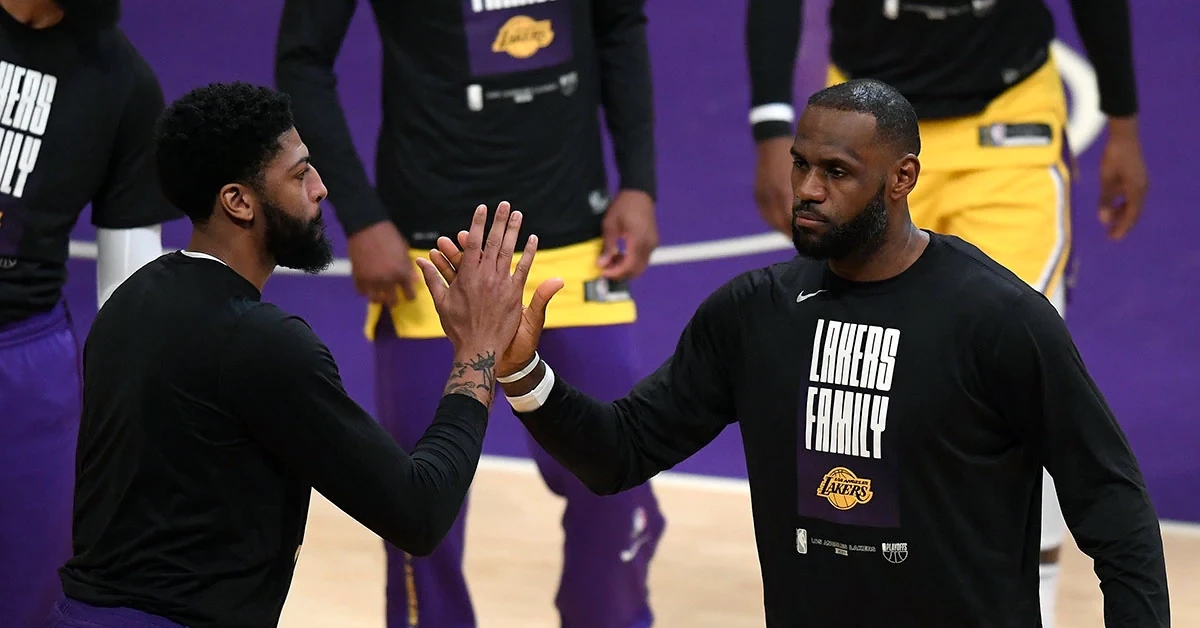
2020-21
Lakers Season Review
Coming off the 17th title in franchise history, won on Oct. 11, 2020 in the NBA finals against Miami, the Lakers entered the 2020-21 season with a clear goal of defending their crown, a mission that fell victim to injuries and the resulting lack of cohesion.
With LeBron James and Anthony Davis combining to miss over half the pandemic-shortened 72-game season, L.A. wound up with the No. 7 seed, before falling 4-2 to No. 2 Phoenix in Round 1. The Lakers took home court from the Suns and led 2-1 before AD went down with a groin injury just ahead of halftime of Game 4, and Phoenix capitalized with three straight wins.
It’s hard to separate the physical and mental toll the longest season in NBA history took on the Lakers, who had only 60 days between Game 6 and their first preseason game, on Dec. 11.
Some might call it the Bubble Tax. Miami (0-4 to MIL) and Boston (1-4 to BKN), the two Eastern Conference finalists in the Bubble, both lost in Round 1 in 2021, while LAL’s 2020 WCF opponent, Denver, managed to beat a banged up Portland team in Round 1 before being swept by Phoenix in Round 2.
Injuries happen to every NBA team, every season, but when those injuries are to star players like LeBron James and AD, they come to define the season. On Media Day leading into the season, Davis hinted at the difficulty of the short offseason, especially for him and LeBron.
“Both of us, we want to play, but it is a quick turnaround,” he said, days after signing a maximum extension with the Lakers. “We have to make sure we’re able to have our bodies healthy enough to make sure we can repeat … hopefully it all ends well where we’re able to get our rest but still get out there and compete.”
When the season started, the Lakers were in a better rhythm than most teams, which was the positive side of the shortened offseason. By February 14, they were 21-6, second only to Utah’s 21-5 at that point, for the NBA’s best record. They found ways to win games even when they didn’t play well, like during a 5-0 home winning streak in which they went to OT three straight times. Offseason acquisitions Dennis Schroder and Montrezl Harrell offered new energy and were more than carrying their weight, while Marc Gasol was fitting nicely into the starting lineup, providing spacing at the five spot that was absent the previous year.
However, Feb. 14 was also when Davis injured his calf/Achilles area against Denver, on the same leg where some issues kept him out the previous week. He wouldn’t return until April 22, and the All-NBA First Teamer started only 36 of 72 games.
Compounding AD’s absence, Schroder missed four straight games between Feb. 16-26 due to the NBA’s health and safety protocols, and L.A. lost all four. Gasol then missed most of the month of March due to protocols, leaving LeBron James with a constantly rotating cast of teammates.
And yet, LeBron led the Lakers to a 4-0 start out of the All-Star break, bringing their record to 28-13, LAL still in good position for home court advantage in the first round, and with Davis nearing a return. Still just 20, 2nd-year guard Talen Horton-Tucker continued to flash his potential, posting individual highs of 26 points and 11 assists in different games to help shoulder some of the burden. But then, on March 20, Atlanta’s Solomon Hill crashed recklessly into LeBron’s ankle, resulting in a high ankle sprain that kept LeBron out of all but four regular season games, and less than 100 percent for the Suns series.
With all the absences, Andre Drummond – acquired at the trade deadline after he agreed to a buyout with Cleveland – had very few games to integrate into a lineup with both LeBron and AD. Meanwhile, most of the Lakers that had played the full length of the Bubble – Kentavious Caldwell-Pope, Alex Caruso, Kyle Kuzma and Markieff Morris – all dealt with varying nagging injuries.
So, despite closing the season with five straight wins to finish 42-30, the Lakers drew Phoenix, the NBA’s healthiest team in the regular season. Indeed, Chris Paul played 70 games for Phoenix, and Devin Booker 67, while Mikal Bridges didn’t miss a game, and Deandre Ayton started the first 69 until resting for the final three ahead of Round 1.
It was the presence of Davis that Phoenix couldn’t handle in Games 2 and 3, as he went for 34 points in each win, before the injury in Game 4 tilted the balance of the series.
“Game 4, we had supreme confidence that we had taken control of the series,” said Coach Frank Vogel. “Then Anthony goes down, and I think there was a bigger deflating effect.”
Credit has to go to the Suns, who played excellent basketball. And yet, LAL are left to think what might have happened were they to have had a traditional offseason, even while accepting the necessary business elements that had to come first.
“It was different,” said Davis. “All around the league, guy’s bodies didn’t handle that very well … but now we have the opportunity to take advantage of this longer offseason … to prepare for next season … I think health played a big part in why we’re in the position we’re in. We just wasn’t healthy. We were very healthy last year. Not this year.”
“It was a bit of a struggle, added Caruso. “KCP playing on one leg. AD couldn’t go. That was just kind of the storyline of the year, taking away from the potential that this team had.”
All in all, the Lakers missed 94 games to rotation players with injuries, including 73 to starters, plus 23 games due to NBA health and safety protocols.
The injuries also made it difficult for the players to develop cohesion with one another on the floor.
“A lot of that is repetitions that we couldn’t have,” explained Wesley Matthews. “Live practice situations that we couldn’t do. Condensed season, with travel, which doesn’t leave you much time to practice, go hard and compete in practice, and play so that you can see those live looks because you have to preserve your legs (for games). So with lineups changes, superstars are in and out of the lineups, games were almost practices for us. We played I don’t know how many rotations that were on the court for the first time.”
Even with all the missed time, LeBron still earned a spot on the All-NBA Second Team, his record 17th All-NBA appearance (13 First Teams). He was the leading MVP candidate before his injury, continuing to refuse to show any signs of showing down in his 18th NBA season, at age 36.
In averaging 25.0 points per game to lead the Lakers, LeBron secured his 17th consecutive season, adding to his standing NBA record, with the next closest players reaching 12 seasons (Michael Jordan, Kobe Bryant, Kevin Durant and Karl Malone). LeBron closed the gap on Malone for second on the All-Time scoring list (36,928 to 35,367). And, oh yeah, he also ranks 8th on the NBA’s All-Time assist list after leading LAL with 7.8 per game, trailing No. 7 Oscar Robertson 9,887 to 9,696, with Magic Johnson (10,141) also in view.
Drummond’s 10.2 boards per game led the way in his 21 appearances, while AD led the team in blocks (1.64) and steals (1.25), with KCP tossing in the 10th best 3-point percentage season in franchise history (41.0 percent). KCP also ranks 5th on LAL’s all-time 3-point FG’s made list (522), with teammate Kyle Kuzma currently ranking 6th (510).
AD, Caruso*, KCP and Schroder all received All-Defensive Team votes in recognition of the team that finished the year ranked No. 1 in defensive efficiency despite all of the injury absences, and Frank Vogel deserves considerable credit for that.
*Caruso finished third in the NBA in defensive rating.
Vogel was able to keep whatever players were on the floor in their defensive shape, and draw out the type of energy it takes to be good on that end most every night, but the offense struggled without LeBron most of all, and certainly AD as well. The Lakers finished the season ranked 24th on that end.
Now, here’s the good news for the Lakers: they have a full offseason to get their bodies back on track for the 2021-22 season. After a 71-day offseason last year, they’ll get all of June, July, August and September to get right mentally and physically before training camp starts in October.
And then, once again, the goal of a team built around LeBron and AD will be simple, in Rob Pelinka’s words: “We have an insatiable desire to bring banner No. 18 here.”
Return to top of page
2021-22
Lakers Season Review
With the stated preseason goal of winning a championship, the 2021-22 Lakers finished with just 33 wins, to 49 losses, ultimately failing to qualify for a play-in berth, let alone the playoffs. Undoubtedly, it was a very disappointing campaign for all involved.
Lakers VP of Basketball Operations Rob Pelinka summarized things prior to Monday’s exit interviews at the UCLA Health Training Center.
The day after the season concluded with an OT win at Denver, the organization announced that Frank Vogel’s tenure as the team’s head coach – which included the 2020 NBA championship in his first season – had come to an end.
“We expressed gratitude for the three years of being able to work together,” said Pelinka at his exit interview on Monday, April 11. “It’s a point in the Lakers history where we felt like it was time for a change in our leadership voice. Those are difficult things to do.
“This is an inflection point where he goes from being the leader of the Lakers to part of our legacy, and especially our championship legacy.”
One of the most difficult things Vogel had to deal with throughout the 2021-22 season was a lack of health, which led to a franchise-high 41 different starting lineups on the season. Even more damaging was who was missing: LeBron James and Anthony Davis were out for a combined 68 games. Potential starter, or at worst, sixth-man-to-be Kendrick Nunn missed the entire season, and several other key role players missed action, as Trevor Ariza and Talen Horton-Tucker both had early-season surgeries.
“Forty one starting lineups ... wow,” said LeBron. “It’s just, you never get an opportunity to see what the ball club could have been. Definitely frustrating, for sure.”
Regardless of health, the team just didn’t play well enough on either side of the basketball. They finished 22nd in offensive efficiency, and 21st in defensive efficiency, after Vogel had led them to No. 1 in defense in 2020-21, and No. 3 in 2019-20.
“Obviously it wasn’t a successful season by any means, from top to bottom,” said Russell Westbrook, who joined the Lakers in a trade that sent Kyle Kuzma, Kentavious Caldwell-Pope and Montrezl Harrell plus a first-round pick to Washington last summer. “There are so many different things you can point to … I’m big on putting a ton of pressure on myself coming into any situation. Just my play in general, not my best season … I know a lot of people outside of here have their own expectations, but for me personally, I put myself on a very high scale, and I’m not happy (with how I played).”
L.A. failed to build the type of chemistry that seemed almost instantaneous when Davis joined LeBron in 2019-20. That team started 24-3, despite little carryover from the previous season. This year’s edition never got more than three games over .500, at 16-13, when undrafted rookie – and major bright spot – Austin Reaves hit a buzzer-beating three at Dallas. The next game, at Minnesota, Davis suffered a knee sprain that would keep him out for over a month, right around the time where most of the team would miss games due to the NBA's health and safety protocols. From that point moving forward, Davis and LeBron would play only seven more games together.
Health provided, Davis does believe that he and LeBron can still anchor a championship team.
“We’ve shown that we can,” said Davis. “I don’t know that’s something we just have to reevaluate in the offseason, upstairs, me and him talking about this season and what we would like to see next season and kind of just figure it out. Guys like to decompress and just kind of take time to think about themselves and look in the mirror and evaluate themselves and then come together as a group and just figuring out what’s best for the team to get back to championship mentality that we had our first year. So that would be a very interesting conversation just from the standpoint of what changed.
“I mean, injuries, but even when we were healthy we, I don’t think we were able to reach our full potential. For whatever reason. So I think we want to figure it out and just get back to that championship pedigree that us as players know we’re capable of and like I’ve said the organization.”
That 2019-20 model – and 2020-21 to a similar extent – was built more upon athletic, two-way role players supporting LeBron and AD, where as the 2021-22 version had more primary ballhandlers, less size and less versatility.
“Our roster did not work,” said Pelinka. “We did not have the season that our fans expect … we have to fix those things, and one of the things we’ve done and will do as we look to hire a new coach is to include that coach in the process of how to make a roster work together.”
L.A. did see several bright spots from young players throughout the season, headlined by a terrific debut from Reaves, who was nabbed by the scouting department and developed by the coaching staff from the start of summer league play. Malik Monk overproduced on a minimum contract with an efficient offensive season at all three levels. Talen Horton-Tucker had moments of on-ball dominance amidst an adjustment to a different, off-ball role, and free agent pickups Stanley Johnson and Wenyen Gabriel made meaningful contributions with their athleticism and energy.
LeBron impressively averaged 30.3 points per game, the second highest of his 19-year career, and he did so efficiently, shooting 52.4 percent from the field (career average: 50.5 percent). He set a new high in three’s made per game (2.9) and took advantage of an often-vacant paint due to small Laker lineups by consistently ranking among league leaders in points at the rim, even if those lineups often left L.A. more vulnerable on defense especially in AD’s absence. It was the first time in LeBron’s career where he played significant minutes at center.
“(Position) doesn’t matter for me personally,” said LeBron. “My personal goal was to be able to play any position on the floor. Every game is different. Matchup is different at times. So, to be able to have the availability to our team that I can switch off and play center for minutes or play point guard for minutes or play the wing spot for minutes according to what the game dictates or needs, that’s for me to make sure that I’m equipped and in the best possible shape I can be in to help us win ballgames.”
Davis put up his usually impressive numbers, averaging 23.2 points, 9.9 boards, 3.1 assists, 2.3 blocks and 1.2 steals, but had one player fall into his leg (Minnesota’s Jaden McDaniels on Dec. 17), and landed upon the foot of another (Utah’s Rudy Gobert on Feb. 16), limiting him to 40 games played.
How to best fill a roster around AD and LeBron will be ironed out by the front office in the coming weeks.
“I mean, it’s human nature to automatically to start thinking about the roster and what it could look like and how we could obviously have a roster that brings in more wins,” said LeBron. “That’s the most important thing. That’s the job that we’re in. So, I’ll start to think about it a little bit. But it’s not sorely on me, obviously, but we definitely want to be better. We want to be better coming into next year. That’s the most important thing for this summer.”
"He feels highly motivated to return next year and have another elite (season),” added Pelinka. “For him to play that way in Year 19 (2021-22) is jaw dropping … Every indication that we’ve received is he sees the Lakers as his home.”
It’s only been 18 months since the Lakers won the 2020 title, and rediscovering some of the chemistry that was so electric for that team, and really, most title teams, will be important. If not easy.
“Basketball chemistry can be an elusive concept,” explained Pelinka. “You don’t always know if it’s going to be there, or not, until you get a chance to see if players gel together. There are so many factors … injuries to star players … we also signed a point guard that we didn’t get a single game out of in Kendrick Nunn. But we’re in a results business, a wins and loss business. We’re not in an excuse business.”
“I do think a chemistry of players that are willing to work hard together and make the sacrifices needed to compete every night at a high level is a north star, and a barometer,” Pelinka concluded. “But the calculus for Lakers success is pretty binary. Either we win a championship, or we don’t. There are no gold stars for the in between. This year, we failed in that mission. That’s the way we look at things here. To get into a position where we can be a team that competes next year at that level to try and bring our fans the 18th title is going to take a focus on making sure that the chemistry of the team is healthy and that we’re growing together throughout the course of a season.”
Return to top of page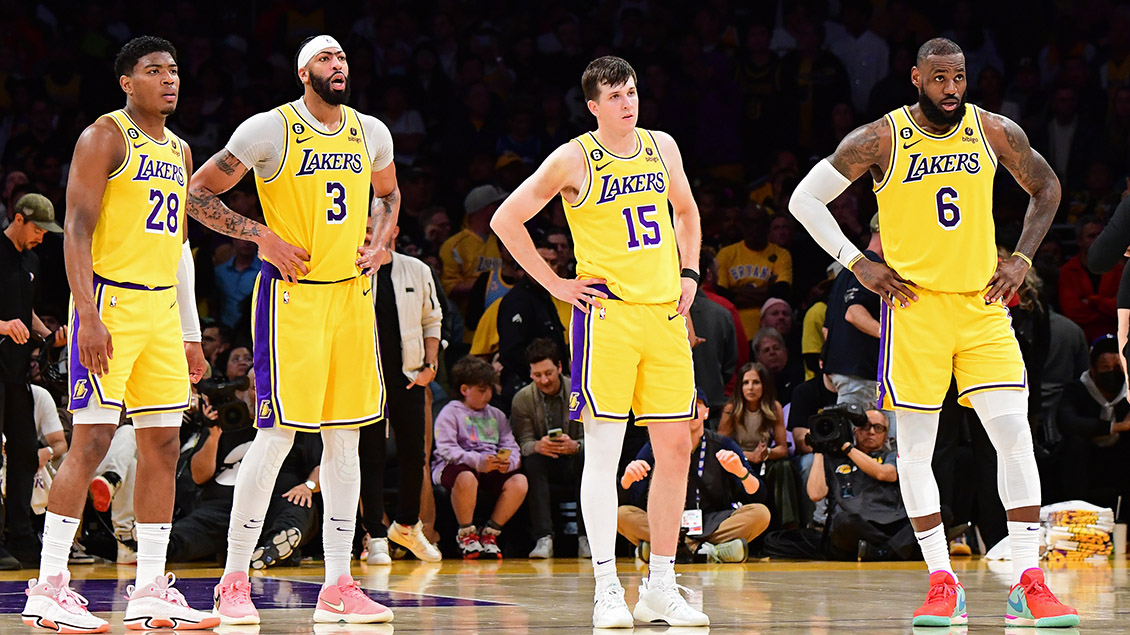
2022-23
Lakers Season Review
The 2022-23 Lakers season, in some ways, had two seasons within one:
1) A difficult, injury-plagued slog prior to the trade deadline that produced a 25-31 record.
2) An impressive push to the regular season finish line (43-39) to secure the No. 7 seed and subsequent playoff series defeats of Memphis (No. 2) and Golden State (No. 6) before an eventual loss to Denver (No. 1) in the Western Conference Finals.
Though both Lakers stars, LeBron James and Anthony Davis, missed significant regular-season time due to respective foot injuries, they did begin and end the season in the starting lineup. What changed at the deadline was their supporting cast.
The season began with an 0-5 struggle, before the Lakers got their first two wins of the season against Denver and then New Orleans, before another 0-5 stretch dropped them to 2-10. A lack of continuity both in coaching staff – new head coach Darvin Ham brought with him a mostly-new group – and on the roster was evident, as the fit of Russell Westbrook and Patrick Beverley in the starting group never quite worked.
The first of many injuries to make that process harder came as LeBron suffered a strained left adductor on Nov. 9, a loss to LAC. But that’s when Anthony Davis began a 10-game tear in which he averaged 35.3 points on 64.8 percent field goals, plus 15.6 boards and 2.90 blocks to lead the Lakers to an 8-2 record in their next 10 games.
Amidst that run, Dennis Schröder and Thomas Bryant both returned from preseason thumb injuries, and provided a collective spark off the bench to stabilize a rotation that had been going deeper than was ideal. Meanwhile, Davis exploded for 44 points and 10 boards, with LeBron James adding 28 points and 11 assists, enough to outduel Giannis Antetokounmpo and the Bucks in Milwaukee. AD was even better the next game against the Wizards, dropping in 55 points alongside 17 rebounds as the Lakers coasted to a 130-119 victory, improving to 10-12 on the season.
But Davis then missed two of the next three games, and some difficult-to-take losses followed in Philly (LAL missed key free throws in the final seconds) and Boston (LAL led by 13 with four minutes left). Davis then hurt his foot in a home win against Denver on Dec. 16, with LAL 12-16; he’d miss the next five-and-a-half weeks of the season.
Just as Davis had stepped up in LeBron’s absence, the King returned the favor until Davis returned on Jan. 25, carrying the Lakers to a 10-10 mark without AD, an impressive feat highlighted by his scoring 47 points in Atlanta on his 38th birthday. That preceded a four-game winning streak including a tough road win at Sacramento on the second night of a B2B.
Davis led the Lakers in scoring (21) and rebounding (12) while blocking four shots, keying a 113-104 win over SAS in his return. But in the next game, at Boston, an obvious shooting foul on Jayson Tatum was missed – the NBA later ruled that a foul should have been fouled as Tatum clearly hit LeBron’s arm on a layup attempt – just ahead of the buzzer in a game L.A. lost in OT, their fourth OT loss to that point.
Amidst the challenging season, LeBron was also steadily pursuing Kareem Abdul-Jabbar’s all-time scoring mark, which he ultimately broke on Feb. 7 vs. OKC. Then with LeBron nursing an ankle/foot injury and missing the next three games, L.A. went into the All-Star break at 27-32.
However, they also changed their season in that period in a major way, with a bevy of moves around the trade deadline. First came the acquisition of Rui Hachimura from Washington for Kendrick Nunn and second round picks. Then came the acquisition of D’Angelo Russell, Jarred Vanderbilt and Malik Beasley in a three-team trade with Minnesota and Utah, with Russell Westbrook and draft compensation going to Utah (a protected first) and Minnesota (a second), and Mike Conley from the Jazz to the Wolves. L.A. also acquired Mo Bamba from Orlando, Davon Reed from Denver, and two second round picks from the Clippers, with Thomas Bryant going to the Nuggets and Patrick Beverley and cash going to Orlando.
Since that roster remake, the Lakers would go on to win eight of their next 11 games, vaulting from 13th in the Western Conference to a three-way tie for ninth at 33-34, just one games back of the No. 7 seed. That run came in spite of another injury to LeBron, who tore a tendon in his foot in an OT win at Dallas on Feb. 26; but Davis kept the Lakers afloat, as they were three games over .500 in LeBron’s month-long absence until a March 26 return.
In a super tight Western playoff chase in which the No. 12 and No. 4 teams weren’t separated by all that much, the Lakers won nine of their final 11 games of the season to improve to 43-39, securing home court for a play-in game against Minnesota.
In that final stretch, Austin Reaves cemented his place in the starting lineup, alongside the two stars, D’Angelo Russell and Jarred Vanderbilt, a group that found success on both sides of the court.
A tough play-in victory over Minnesota came in overtime, setting up a Round 1 showdown with No. 2 seeded Memphis.
On April 16, the Lakers began that series against the Grizzlies in style, with a dominant 128-112 victory in Memphis. They led 32-27 after one, then overcame a six-point halftime deficit with a dominant second half, and a 15-0 run to close the game. Hachimura exploded for 29 points off the bench, tying Mychal Thompson for the most points for a Lakers reserve in a playoff game, with Davis swatting seven shots to go with three steals and 12 boards in a dominant defensive effort. Reaves added 23 points, and took over crunch-time scoring duties with an impressive individual flurry.
Memphis was able to bounce back and win Game 2, 103-93, with a desperate effort that held up despite 28 points and 12 boards from LeBron, despite Ja Morant’s absence due to a hand injury. The Lakers, nonetheless, returned to Los Angeles with home-court advantage.
“With the Purple and Gold crowd roaring through both Games 3 and 4, L.A. managed to win each contest to take a commanding 3-1 series lead. Game 3 started with a ridiculous 35-9 first quarter for the Lakers that essentially put the game out of reach after 12 minutes. Davis finished with 31 points and 17 boards plus three blocks and two steals, with LeBron adding 25 points, and D’Angelo Russell seven assists in a 111-101 victory that was never that close.
Game 4, on April 24, was a harder lift, despite another strong start to the game that had L.A. up 53-38 with four minutes left in the 2nd quarter, before a big Memphis push had them within only two points at the half. The Grizzlies continued their rally to take a two-point lead into the fourth quarter, and led by as many as seven late in the fourth, before back-to-back-to-back threes from Russell, and several key plays from LeBron forced overtime. James was the difference maker in OT, sealing the win with a tough drive through Grizzlies traffic.
Memphis again rallied in Game 5, taking a 116-99 victory against a fatigued Lakers team, with LeBron struggling towards a 5-for-17 shooting night, even as Davis managed 31 points and 19 rebounds. But James vowed to be better in Game 6 … and he was.
In fact, the entire Lakers team played great basketball on April 28’s Game 6. They led by 11 after one, 17 at the half, and 33 after three, before ultimately blowing the Grizzlies out of the arena with a 125-85 result. Russell went off for 31 points, including five triples, with LeBron adding 22 points on 9 of 13 FG’s, before getting to rest alongside Davis (16 points, 14 boards, five blocks) for the entire fourth quarter. L.A. swarmed around defensively to hold Memphis to just 30.2 percent shooting, as they sealed a spot in Round 2.
The Lakers advanced to face the defending-champion Golden State Warriors in Round 2 of the postseason, with GSW having defeated Sacramento in Game 7 on the Sunday leading into the opener on Tuesday, May 2.
Much like in Round 1, the Lakers jumped on their opponent in Game 1, and wrestled home-court advantage away from the higher seed with a 117-112 victory in San Francisco. Anthony Davis led the way with a remarkable 30-point, 23-rebound, 5-assist, 4-block performance.
While the Warriors bounced back with a 127-100 blowout in Game 2, the Lakers followed their Round 1 model once again by defending home court in Game 3 – 127-100 – and Game 4 – 104-101.
Game 3 turned with a dominant second quarter (38-18) and featured 25 points and 13 boards from Davis, plus 21 points apiece from LeBron James and D’Angelo Russell. Game 4 would become known as the Lonnie Walker IV game, as he exploded for 15 points, all in the pivotal 4th Q, as the Lakers outscored GSW 27-17 in the period to take a commanding 3-1 series lead.
Like they did in Game 2, the Warriors found an answer at home in Game 5, winning 121-106, before the decisive Game 6 saw a steady, thorough Lakers effort that ended GSW’s title defense with a 122-101 margin. LeBron was remarkably efficient, scoring 30 points on 10 of 14 FG’s, with nine boards and nine assists in 43 minutes, to lead the way.
Standing between the Lakers and a trip back to the NBA Finals were the Denver Nuggets, led by two-time NBA Nikola Jokic. And it was the Serbian center who was the difference in back-to-back home wins to put the Lakers in their first hole of the postseason, as Denver managed to win two close ones, 132-126, and 108-103, that the Lakers had chances to steal.
Davis was incredible offensively in Game 1, scoring 40 points, but LeBron’s 22 led the way in a more difficult Game 2, in which Denver’s role players managed to convert more opportunities than the Lakers. Jamal Murray provided perimeter support to Jokic’s inside efforts, with former Laker Kentavious Caldwell-Pope combining with Bruce Brown and Michael Porter Jr. to get it done for the Nuggets.
Reaves continued a terrific postseason run by scoring at least 20 points in a fourth straight game with 23 in Game 3, to support LeBron and AD, but Denver once again made more plays down the stretch. L.A. had a 94-93 lead with 7:48 to play, but couldn’t hold on in what was ultimately a 119-108 loss.
The season ended two days later, in even tougher fashion. Near the conclusion of a nip-and-tuck game, Jokic made a fading, contested-by-Davis, desperation three off one foot with 2:50 to play to put Denver up six, yet another Nuggets answer to a game, and series, full of them. L.A. managed to close to two points in the final seconds, but twice, LeBron couldn’t score, after he played nearly 48 minutes towards 40 points, 10 boards and 9 assists.
As such, the Lakers didn’t reach their ultimate goal of winning the 18th title for the franchise, but all in all, a run to the WCF after being six games under .500 in February was quite impressive, and something upon which the team promised to build heading into the summer.
Return to top of page